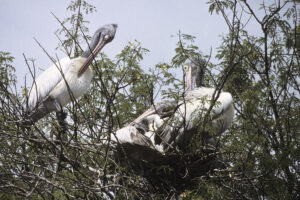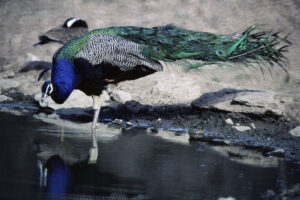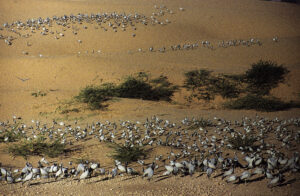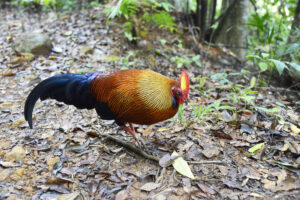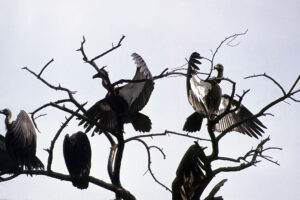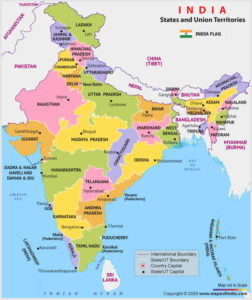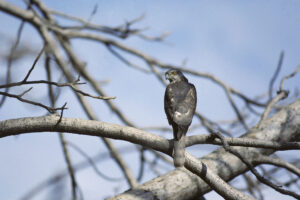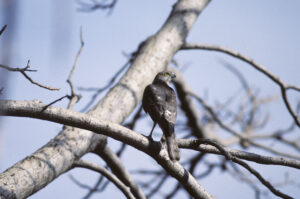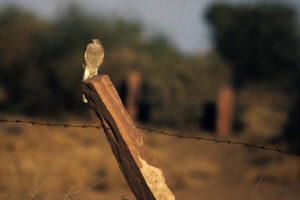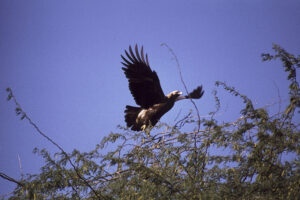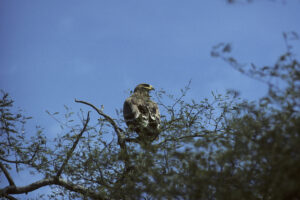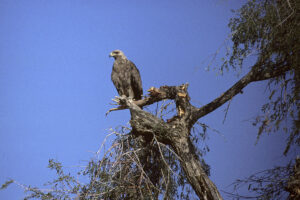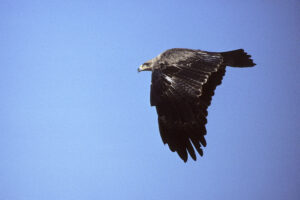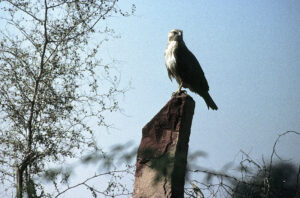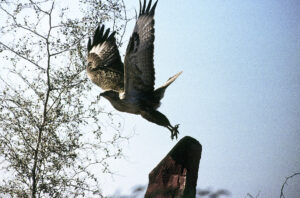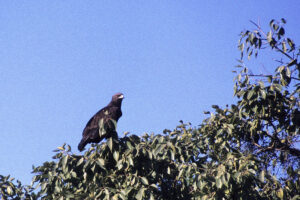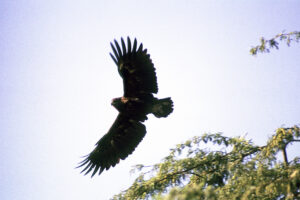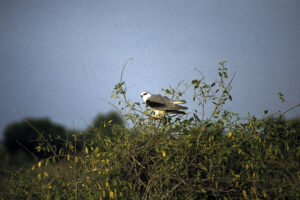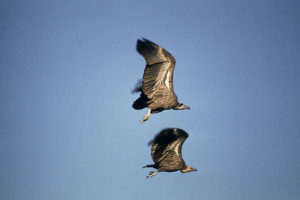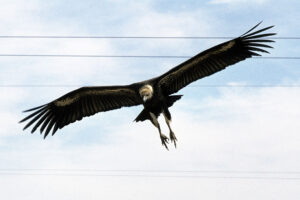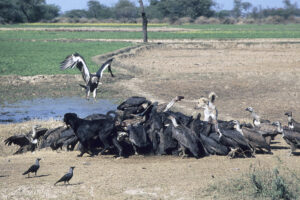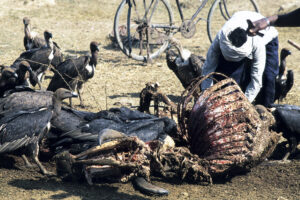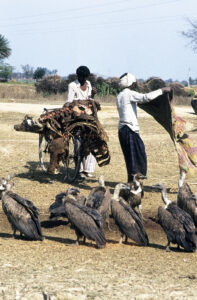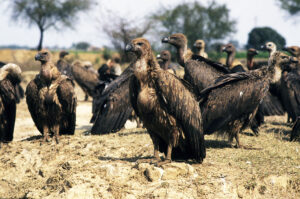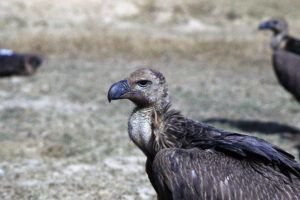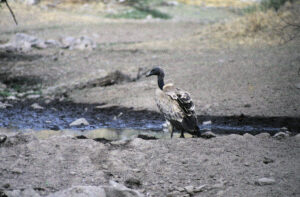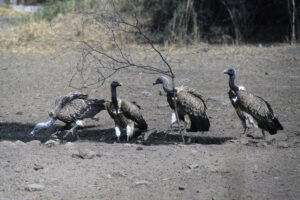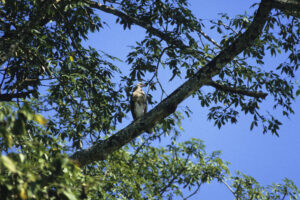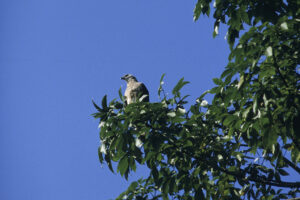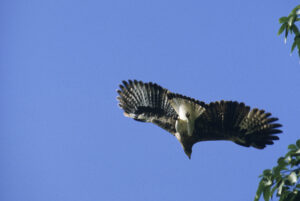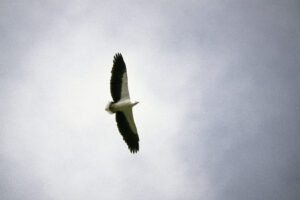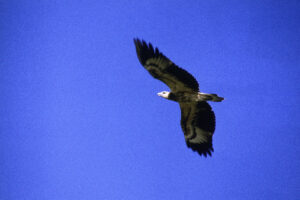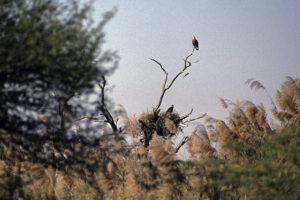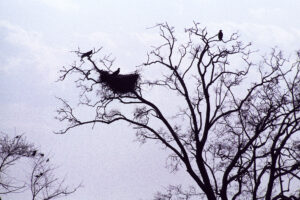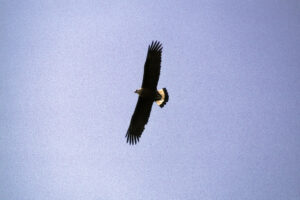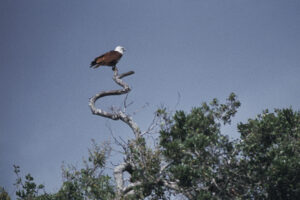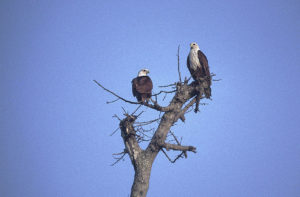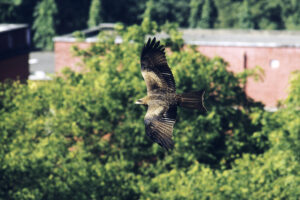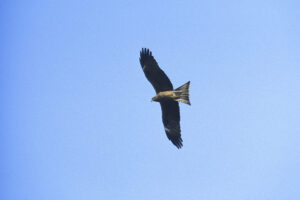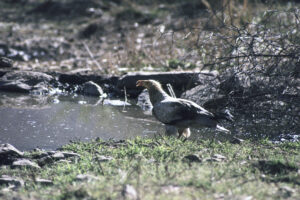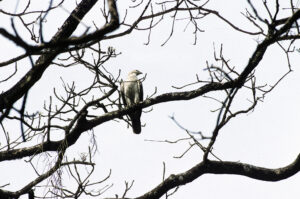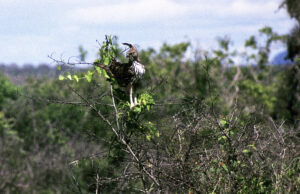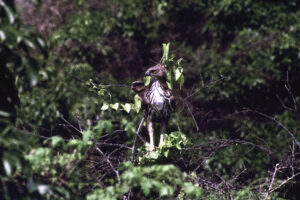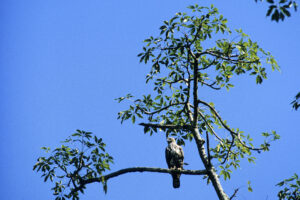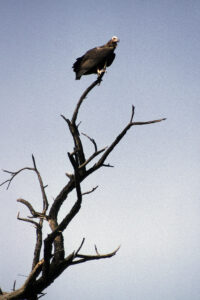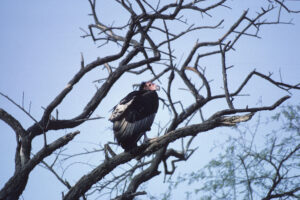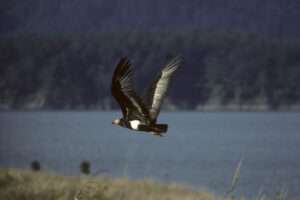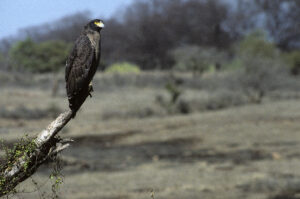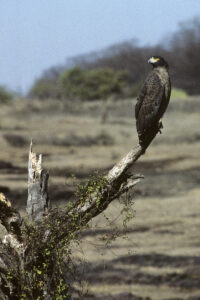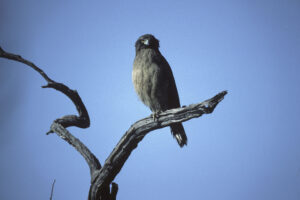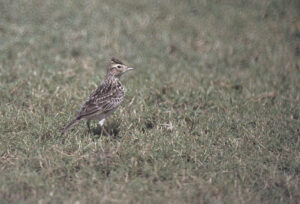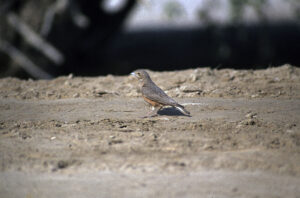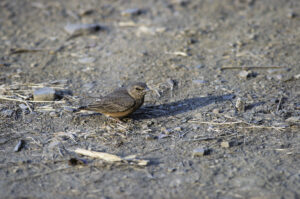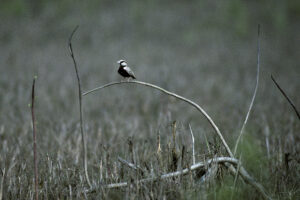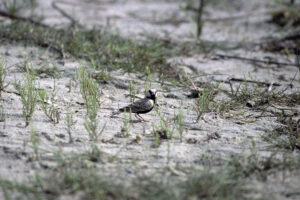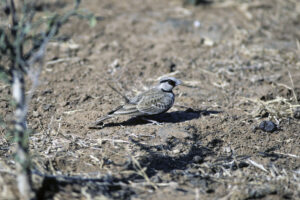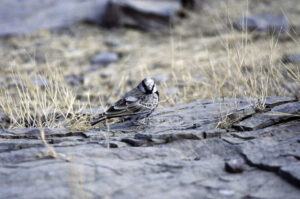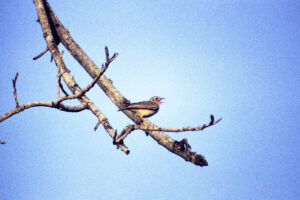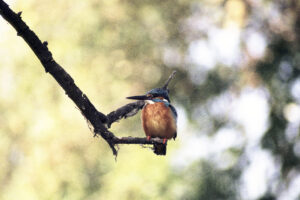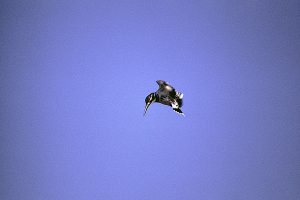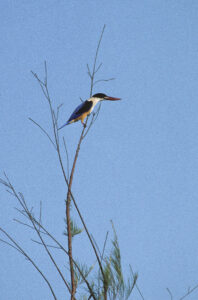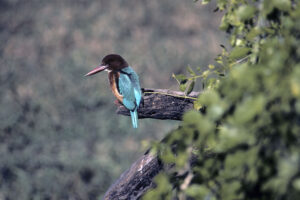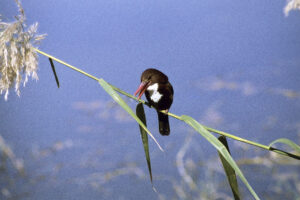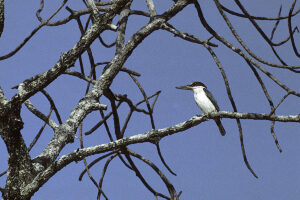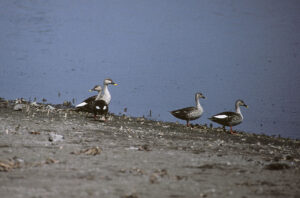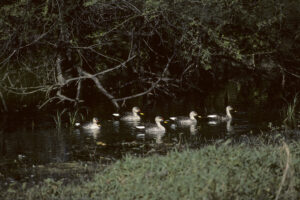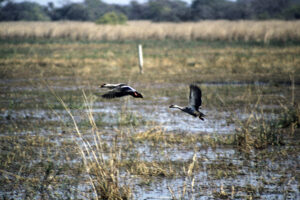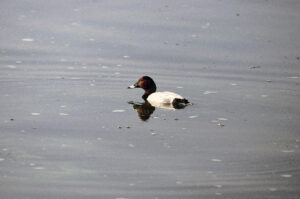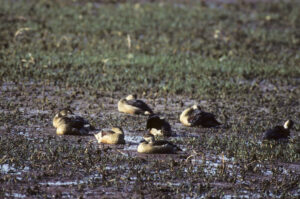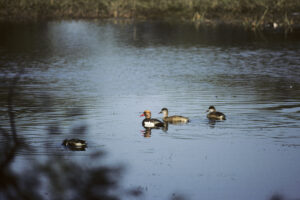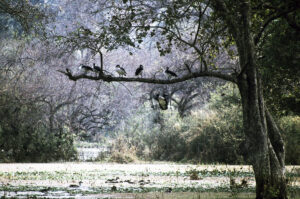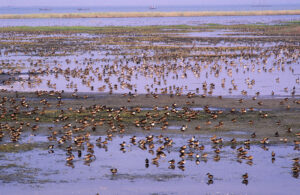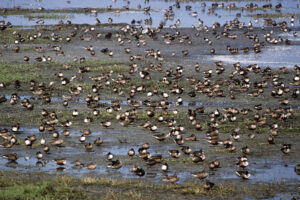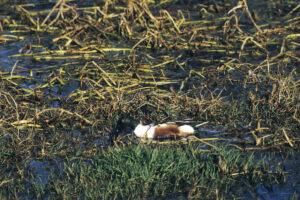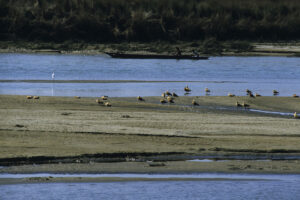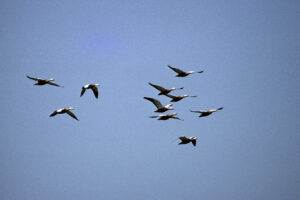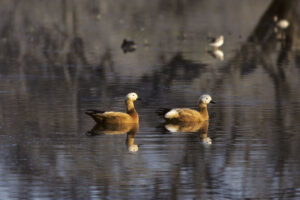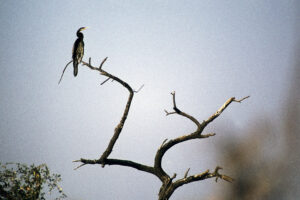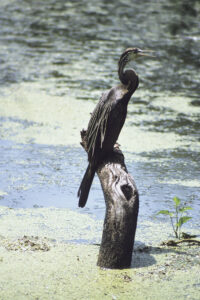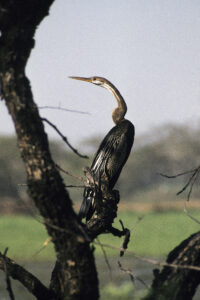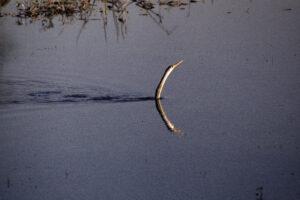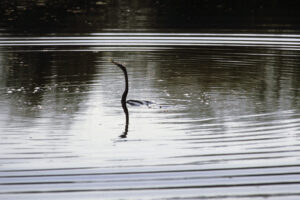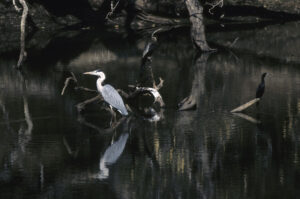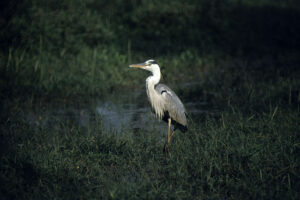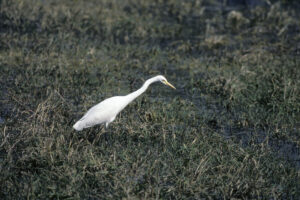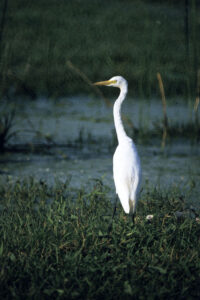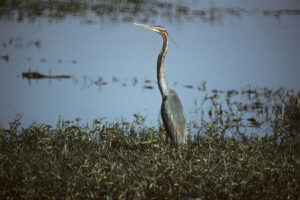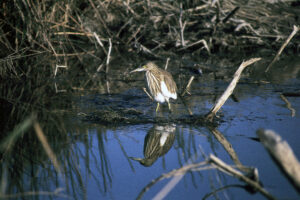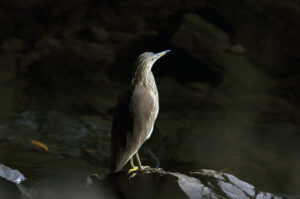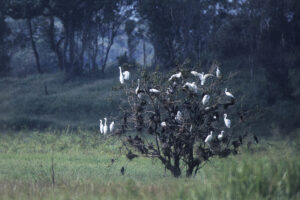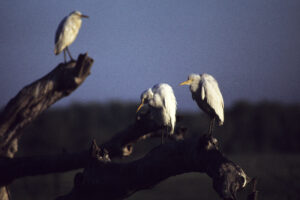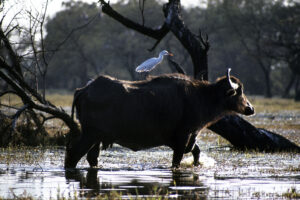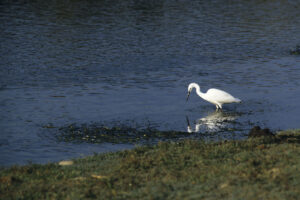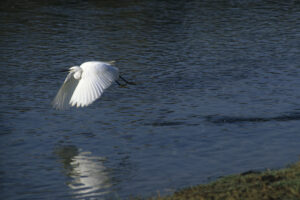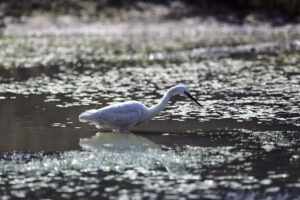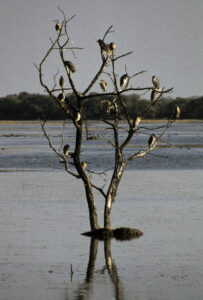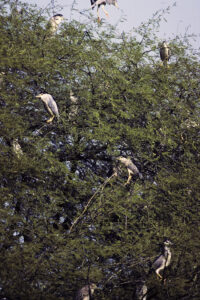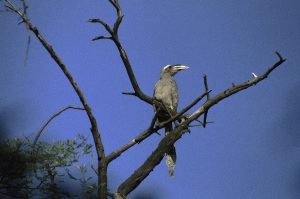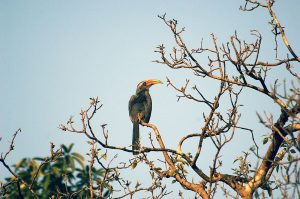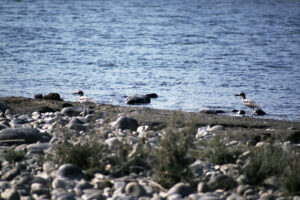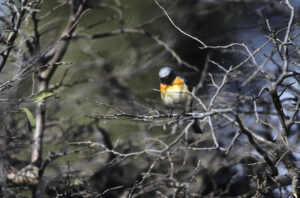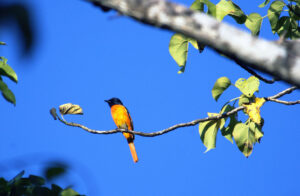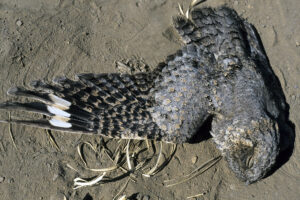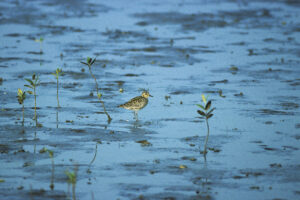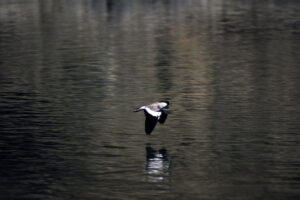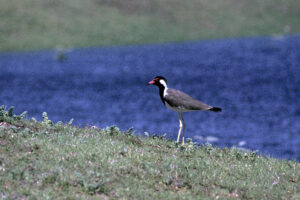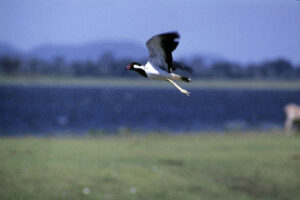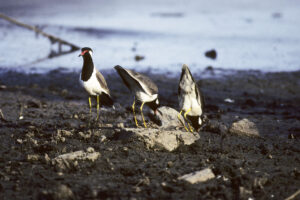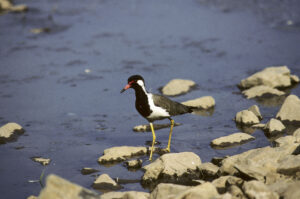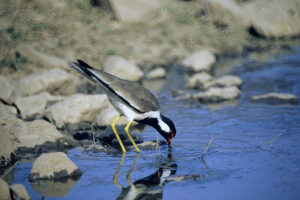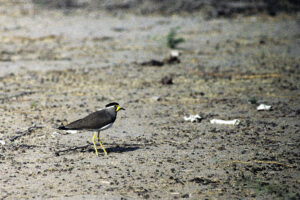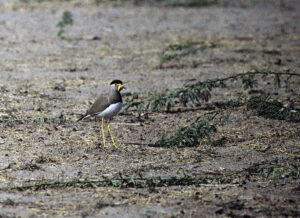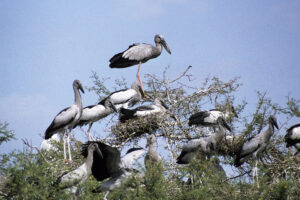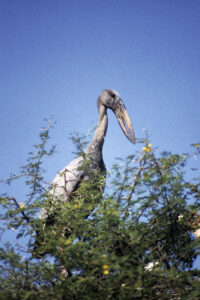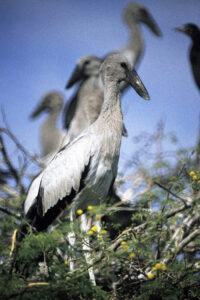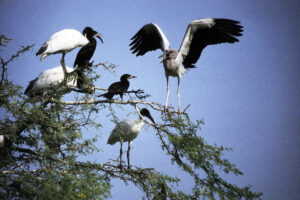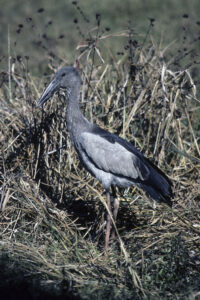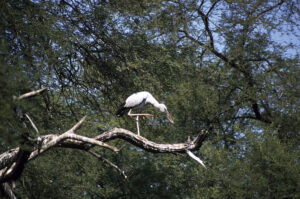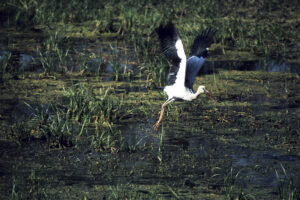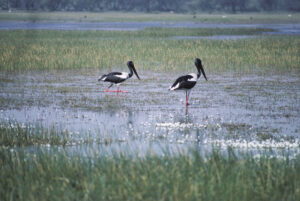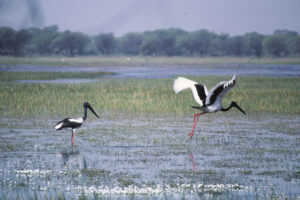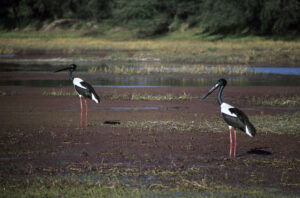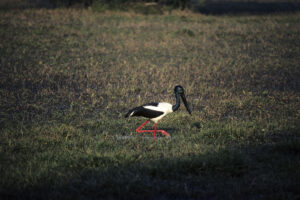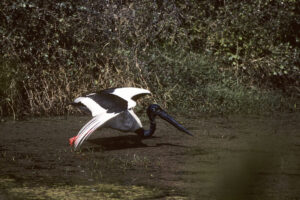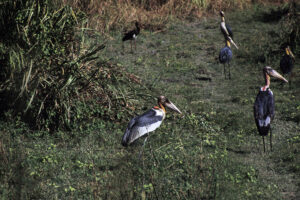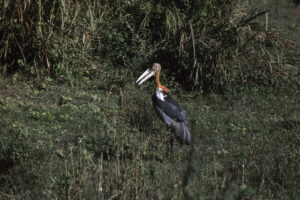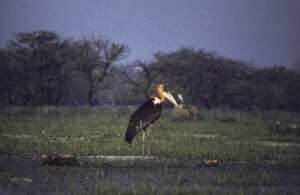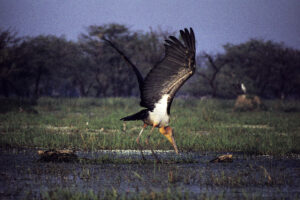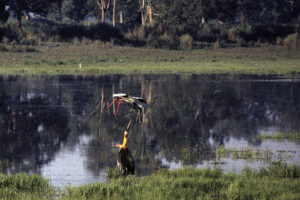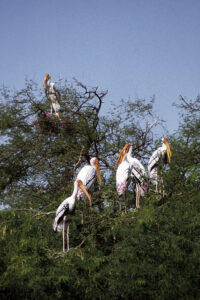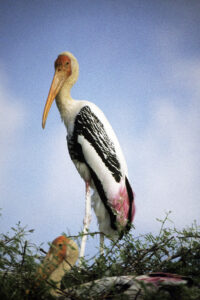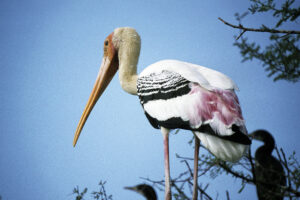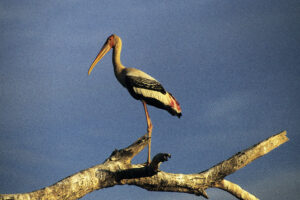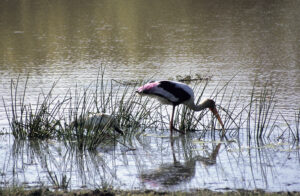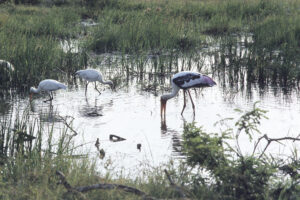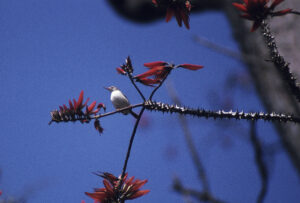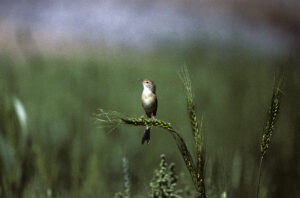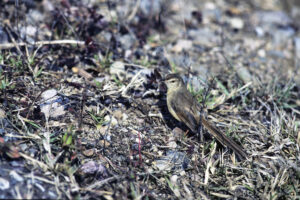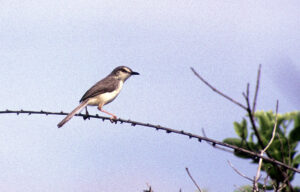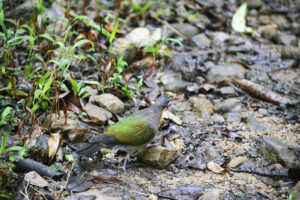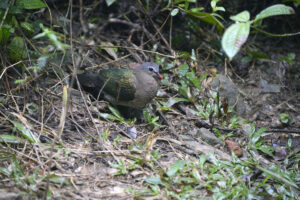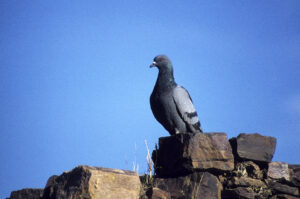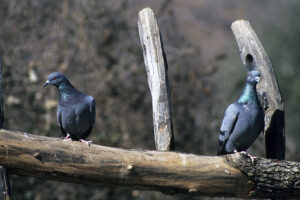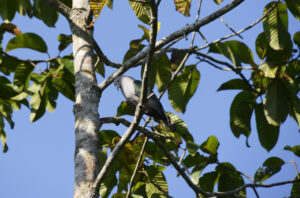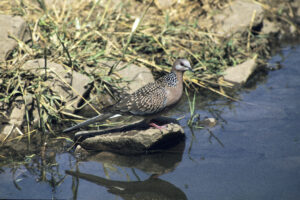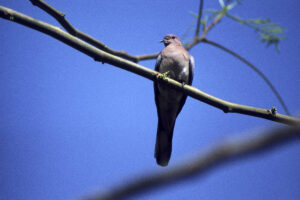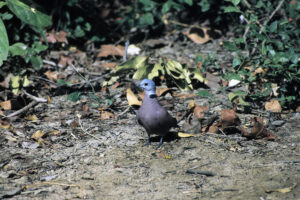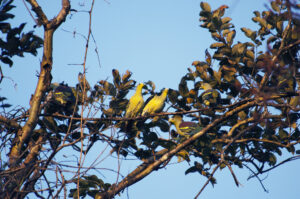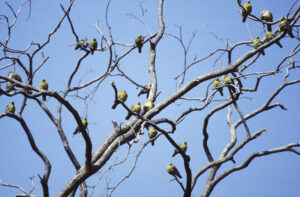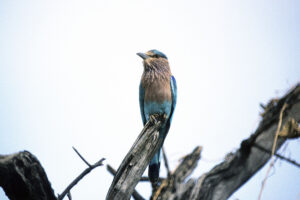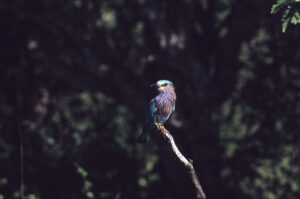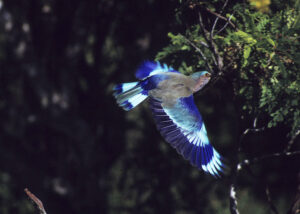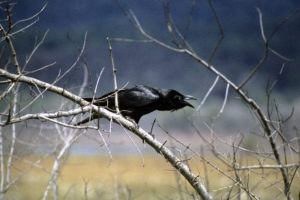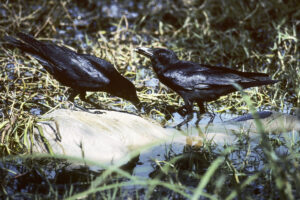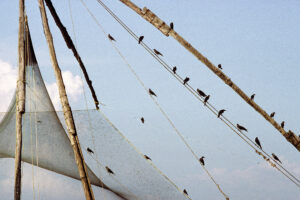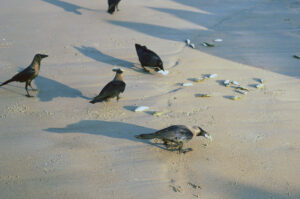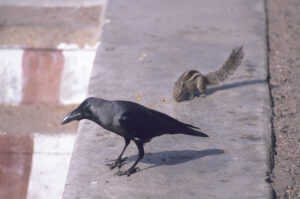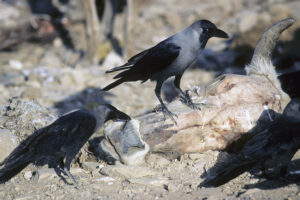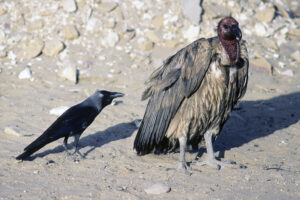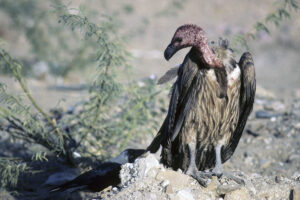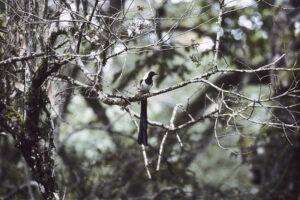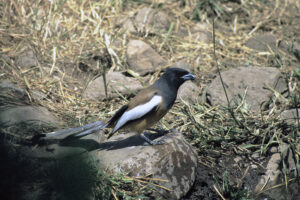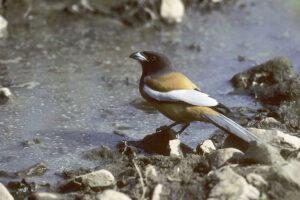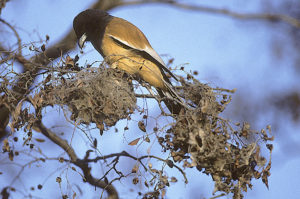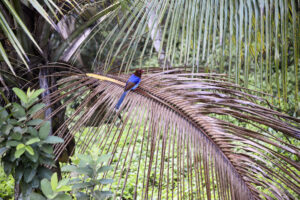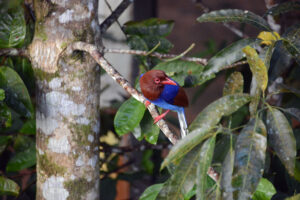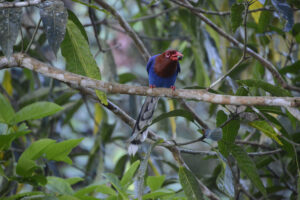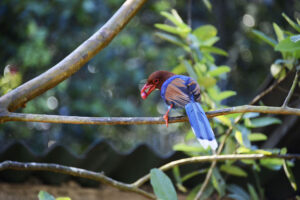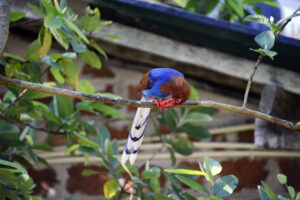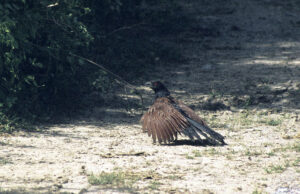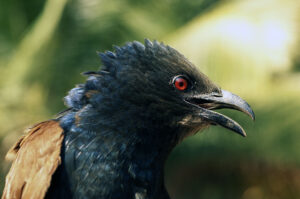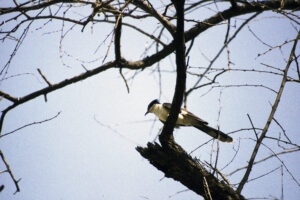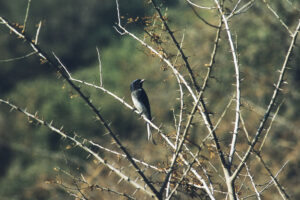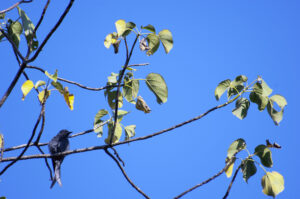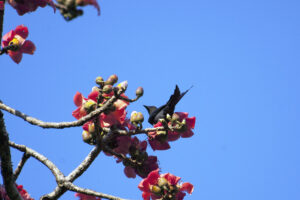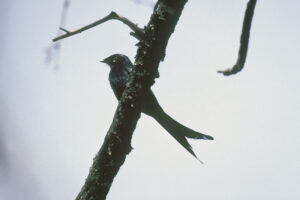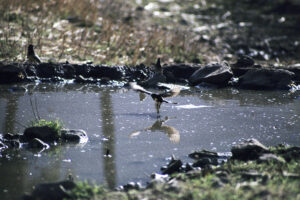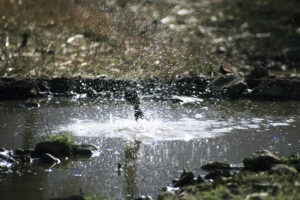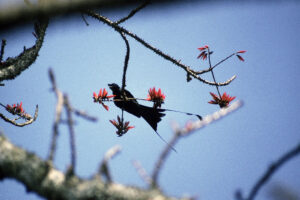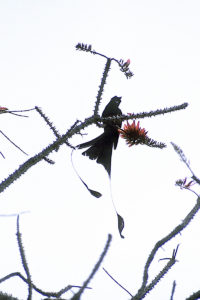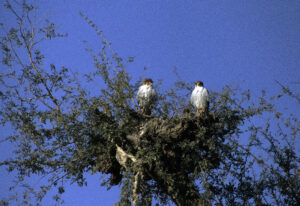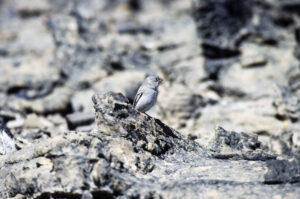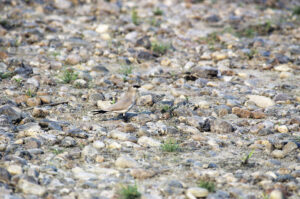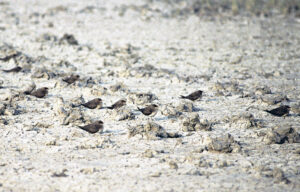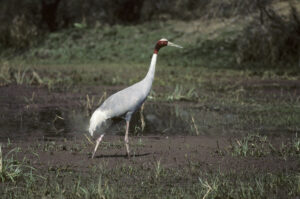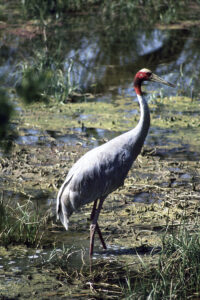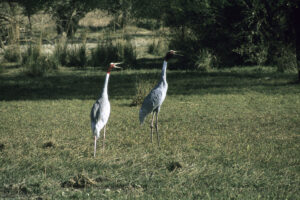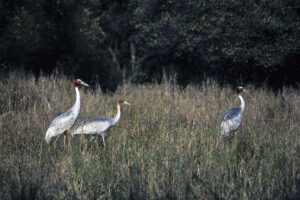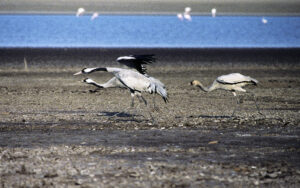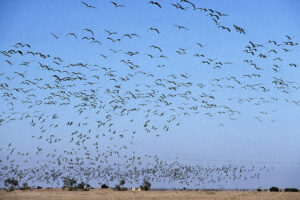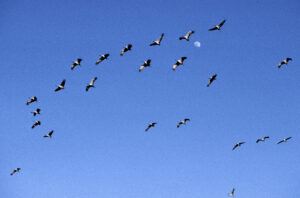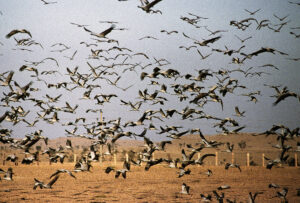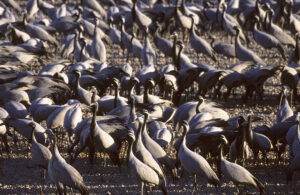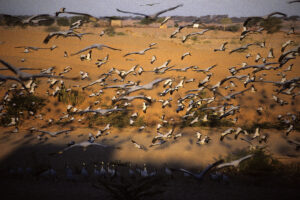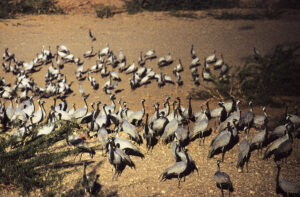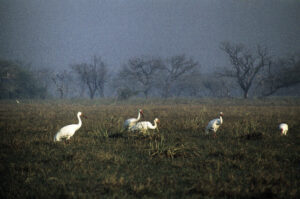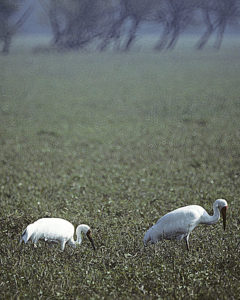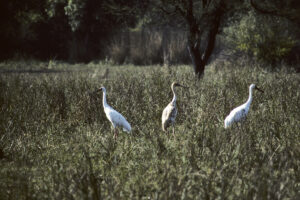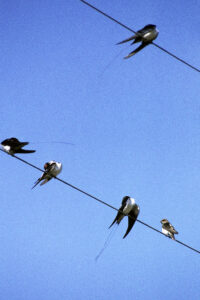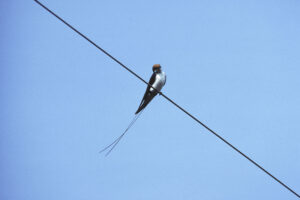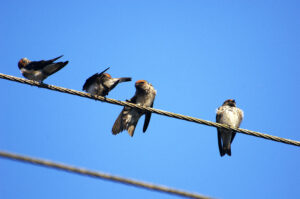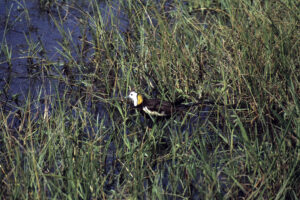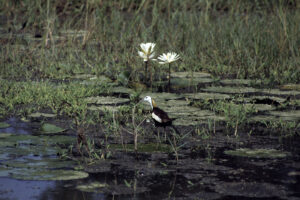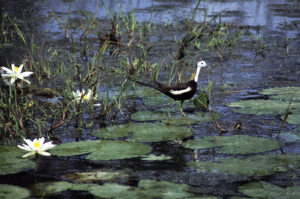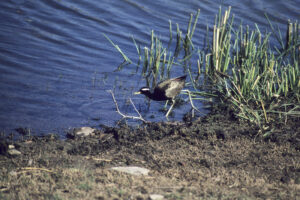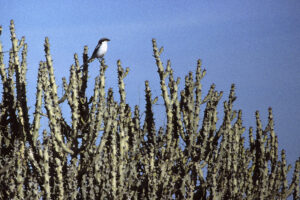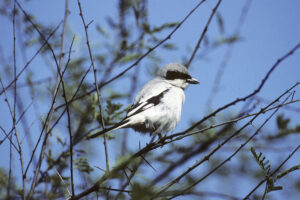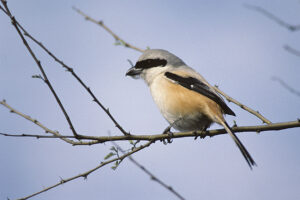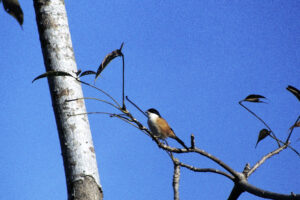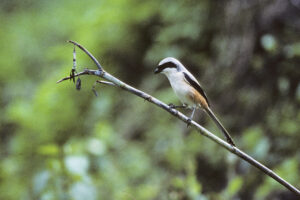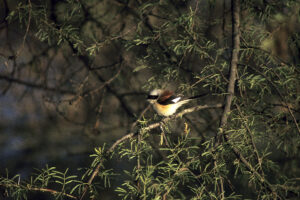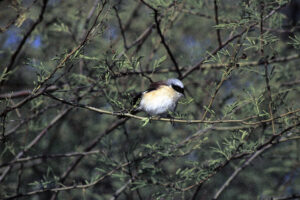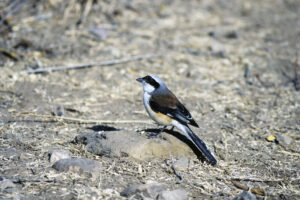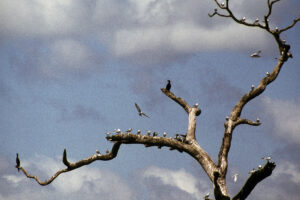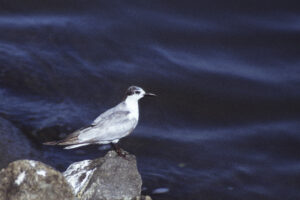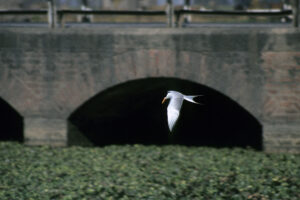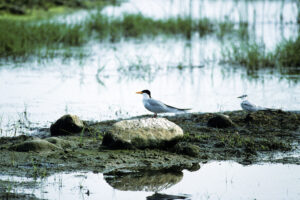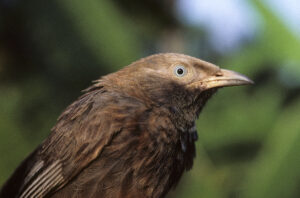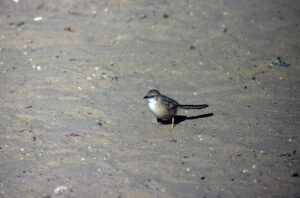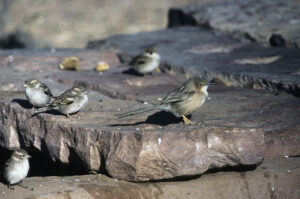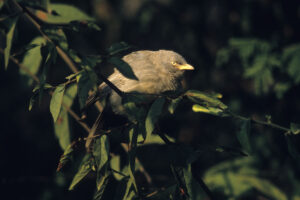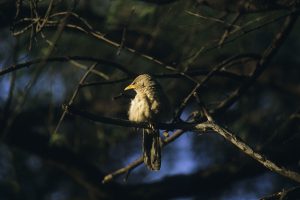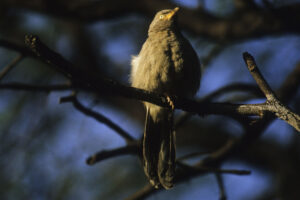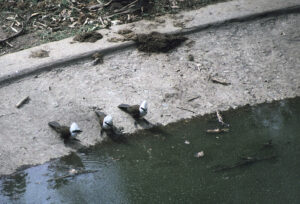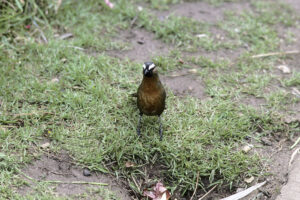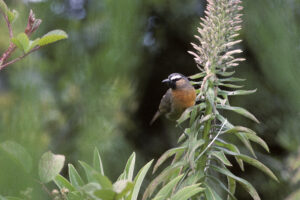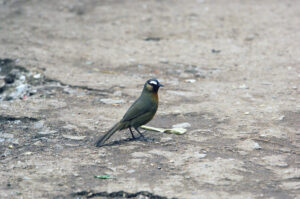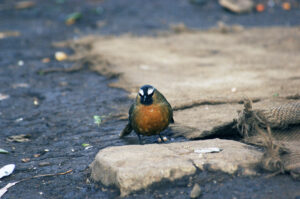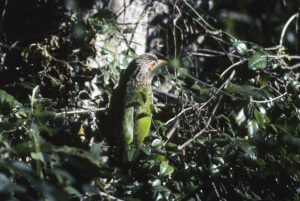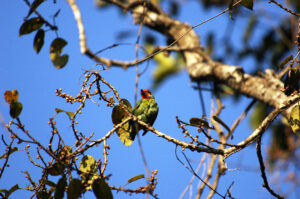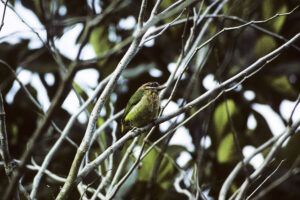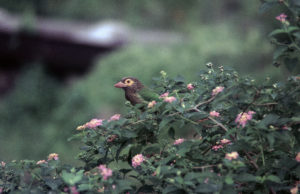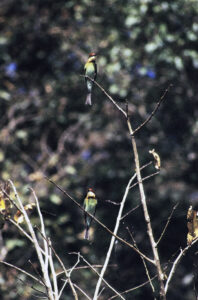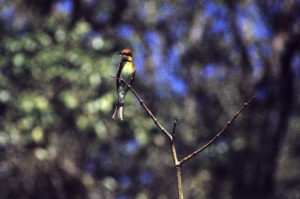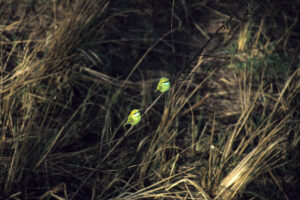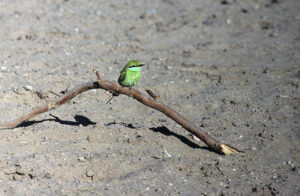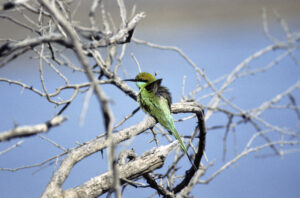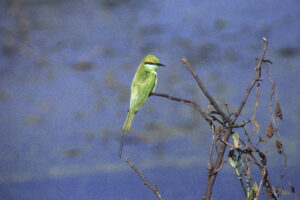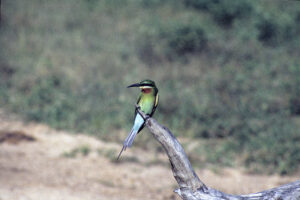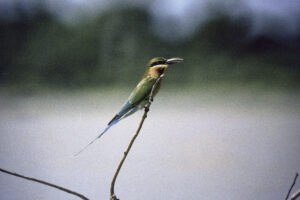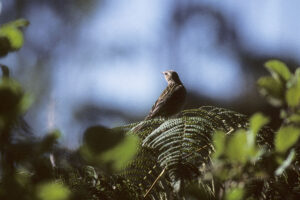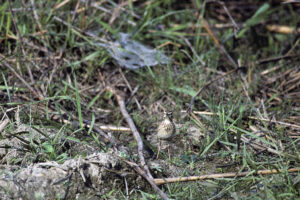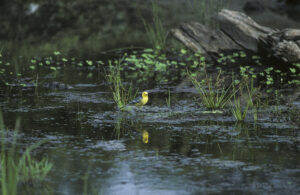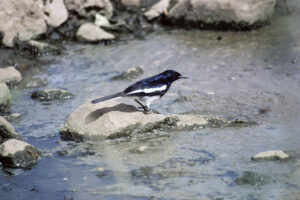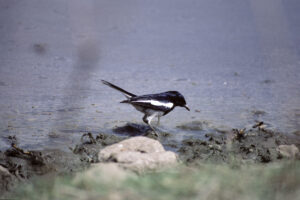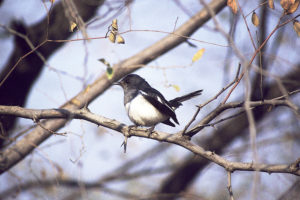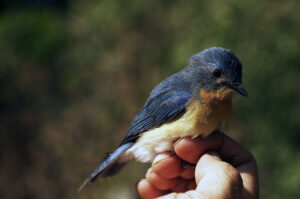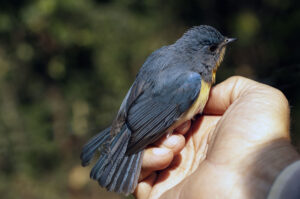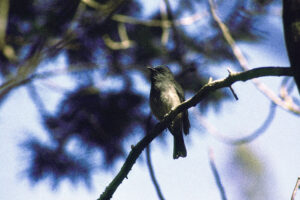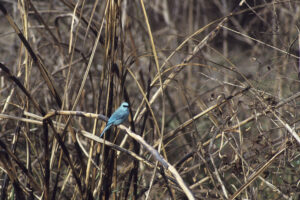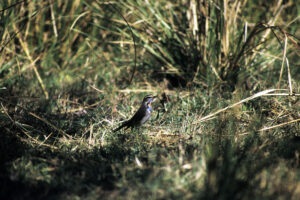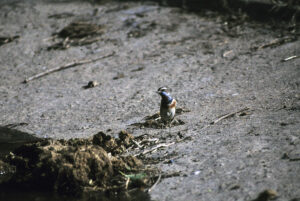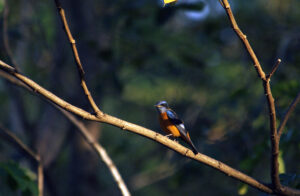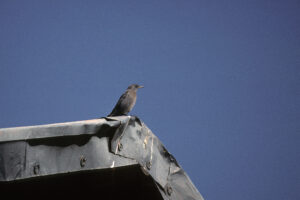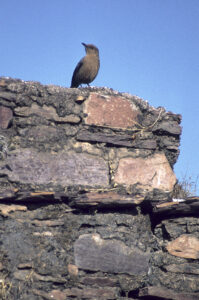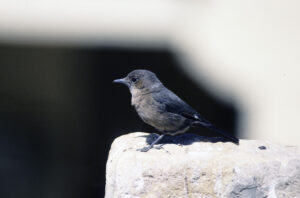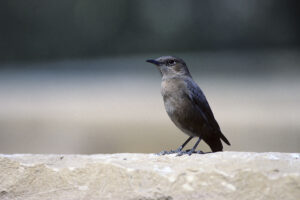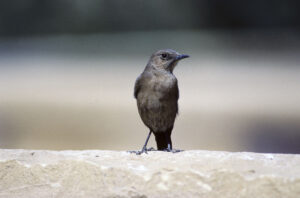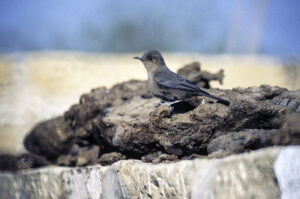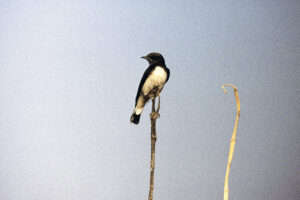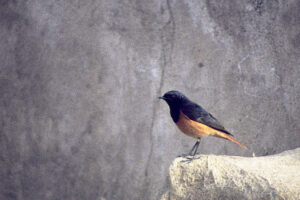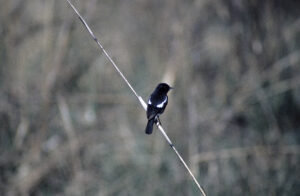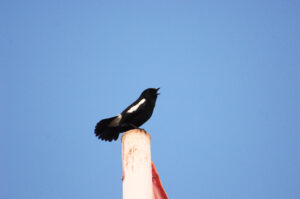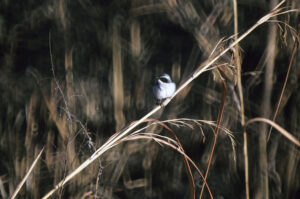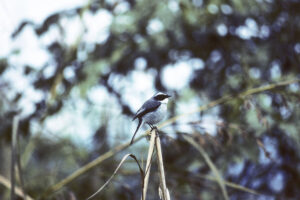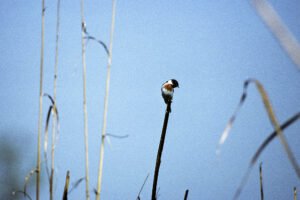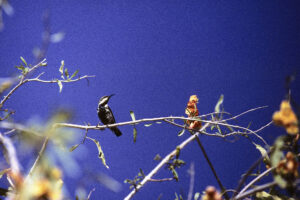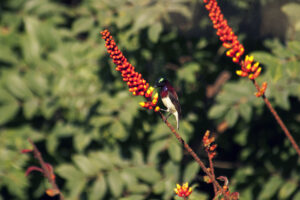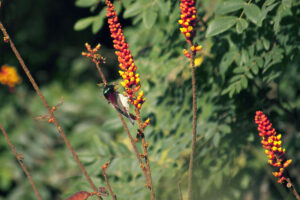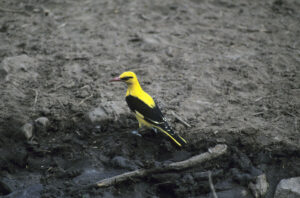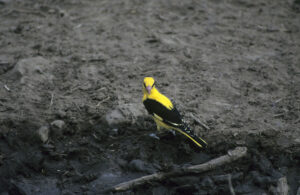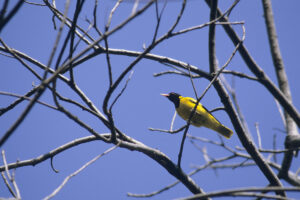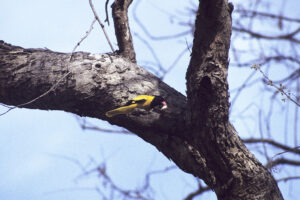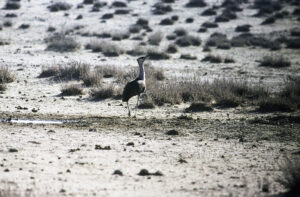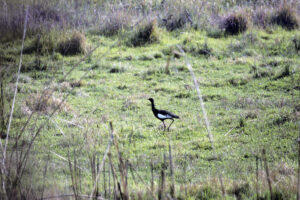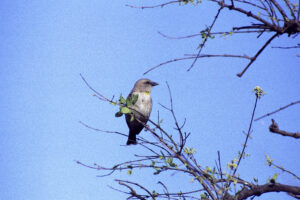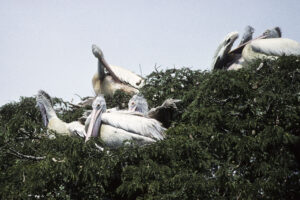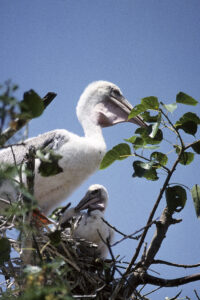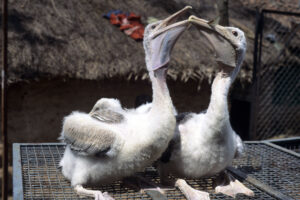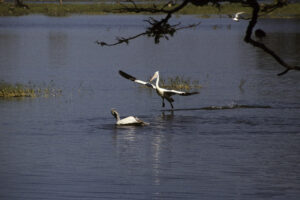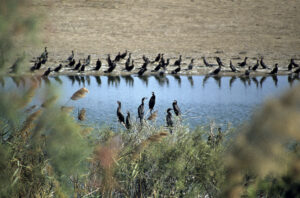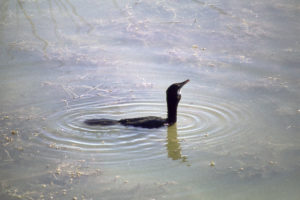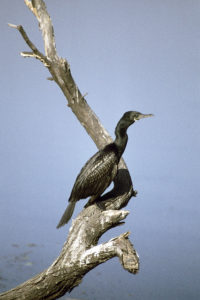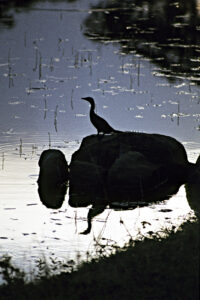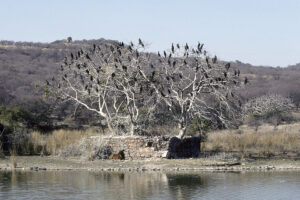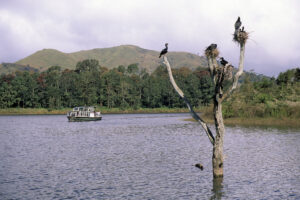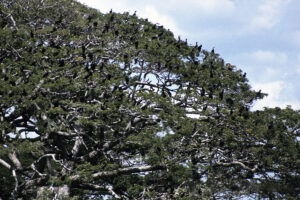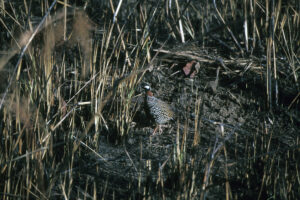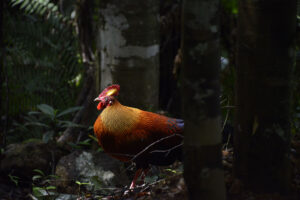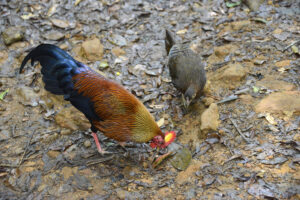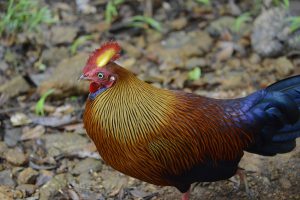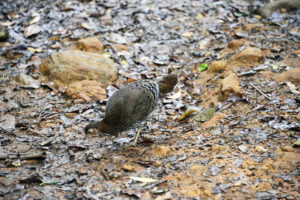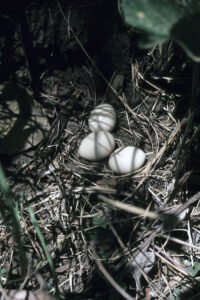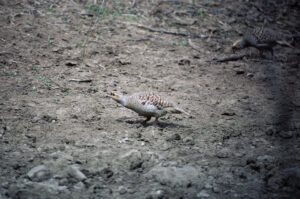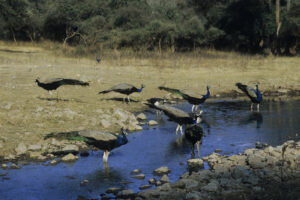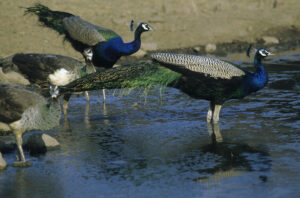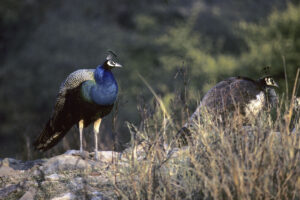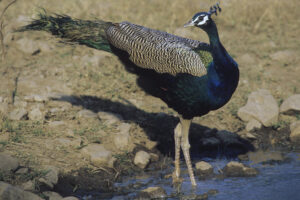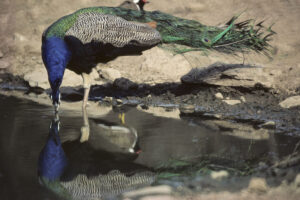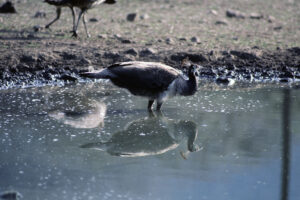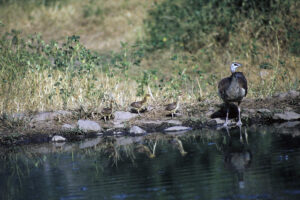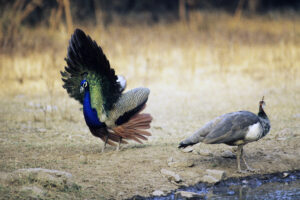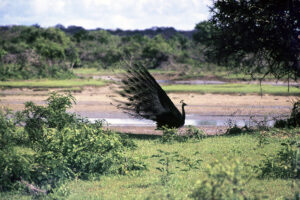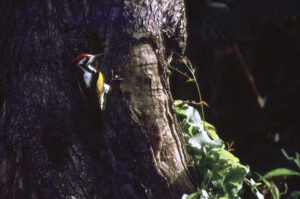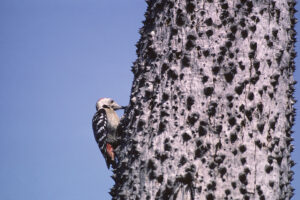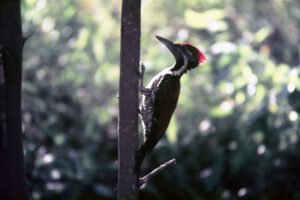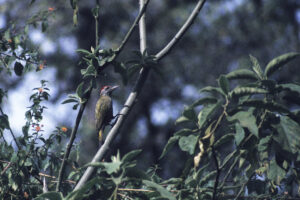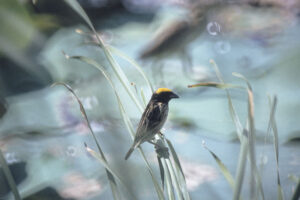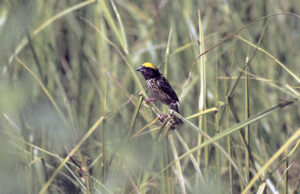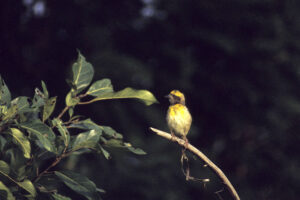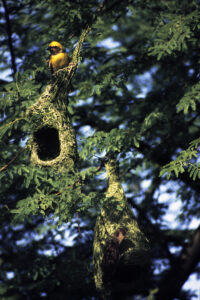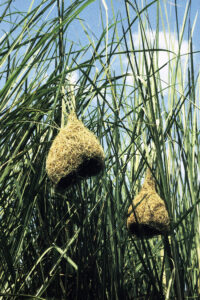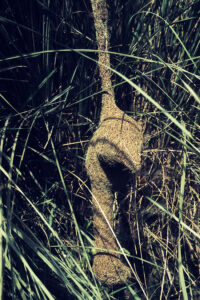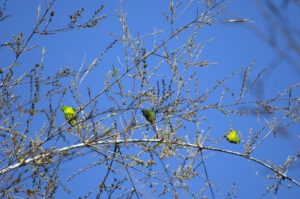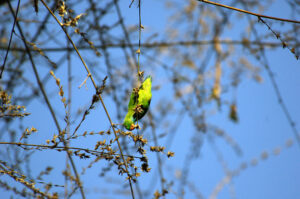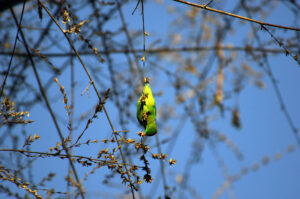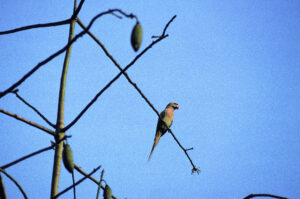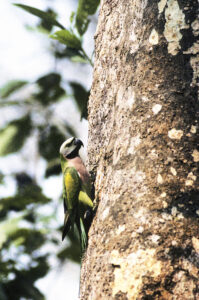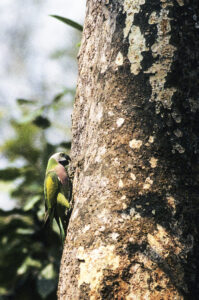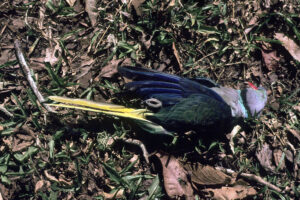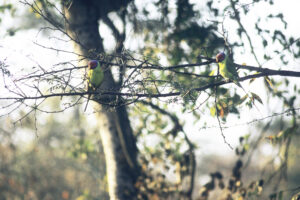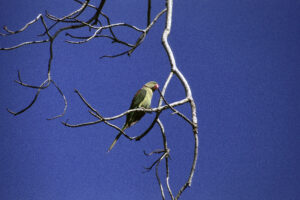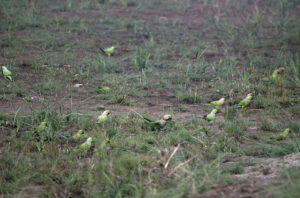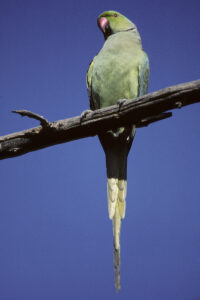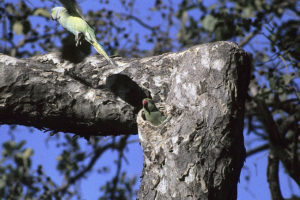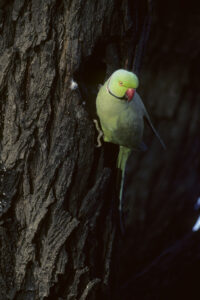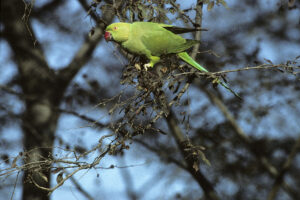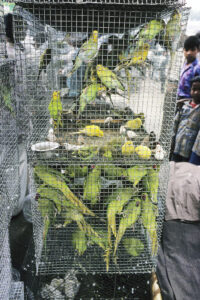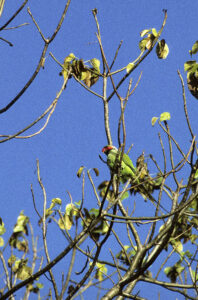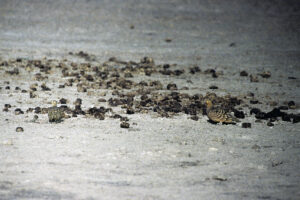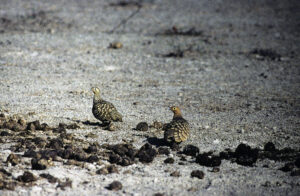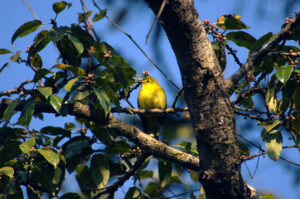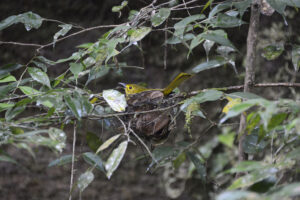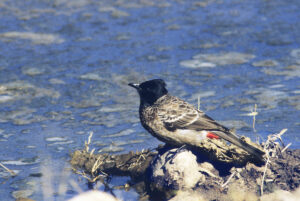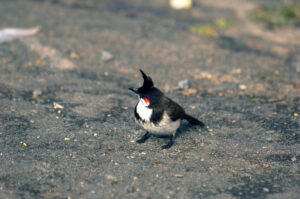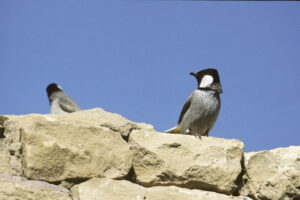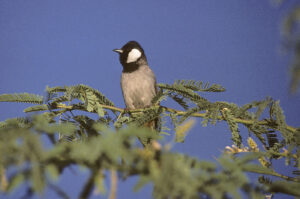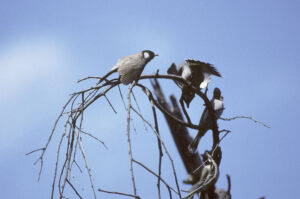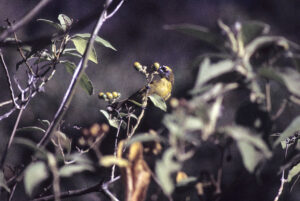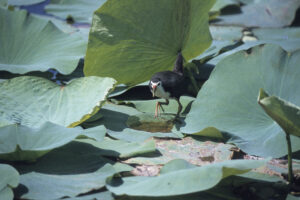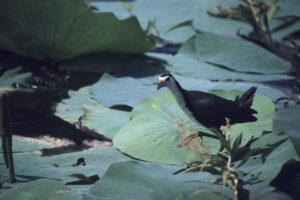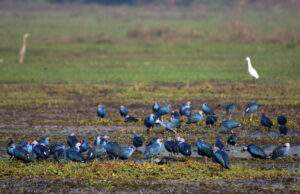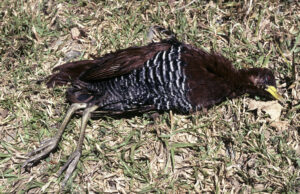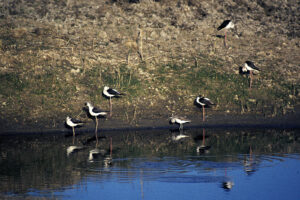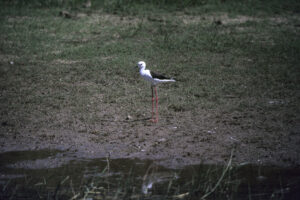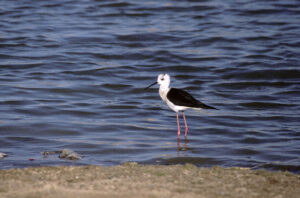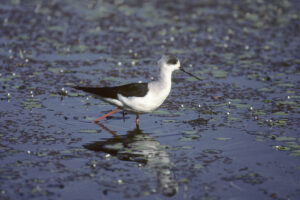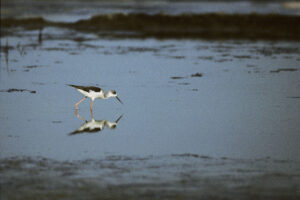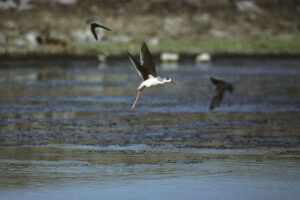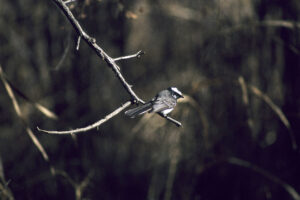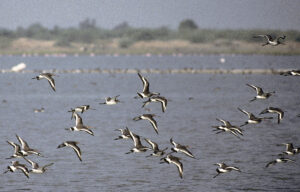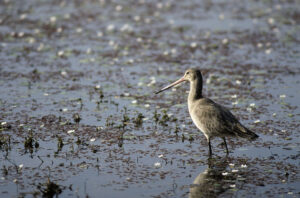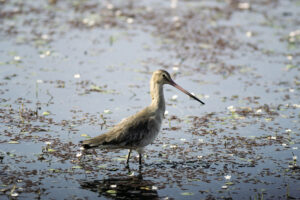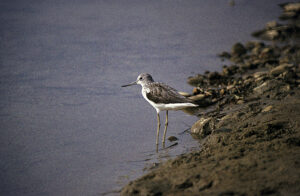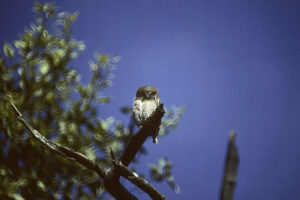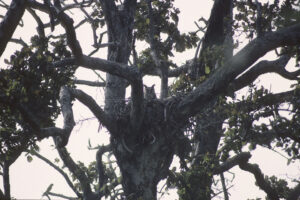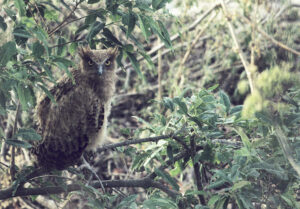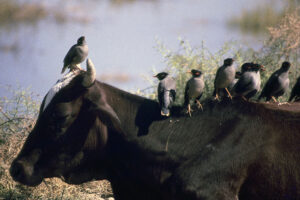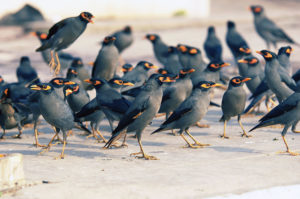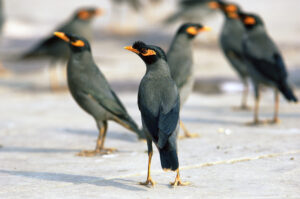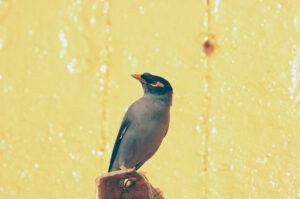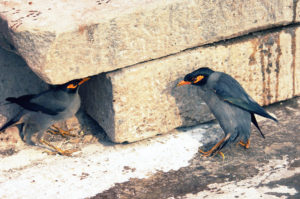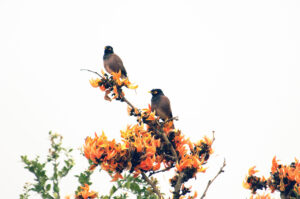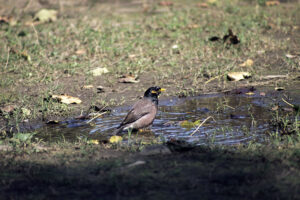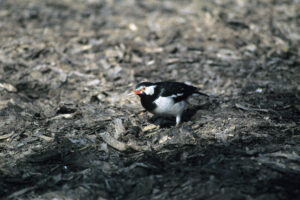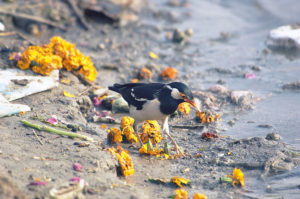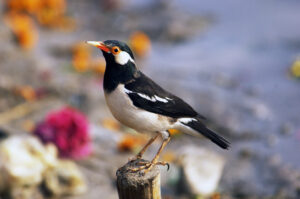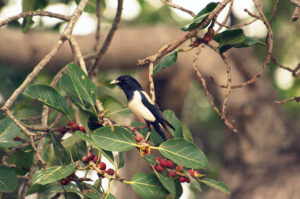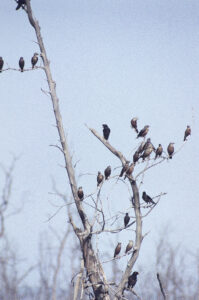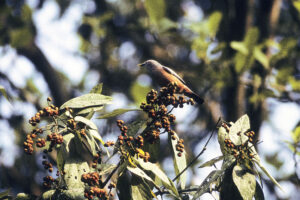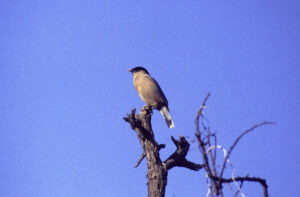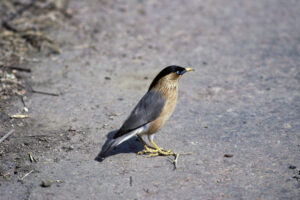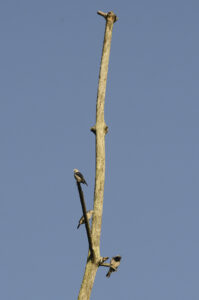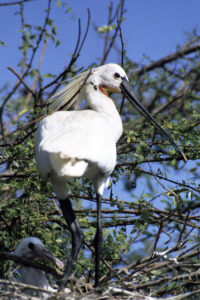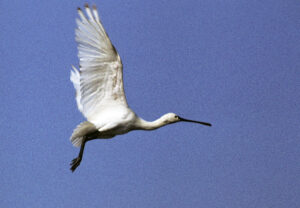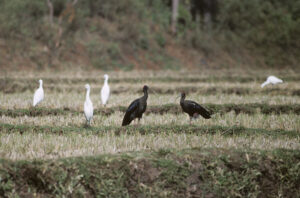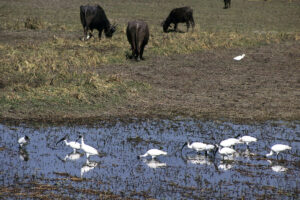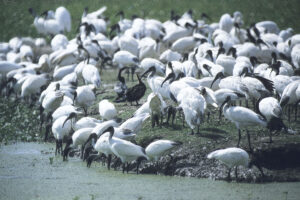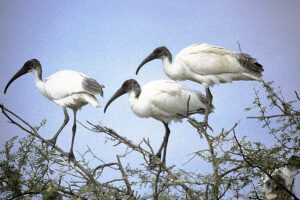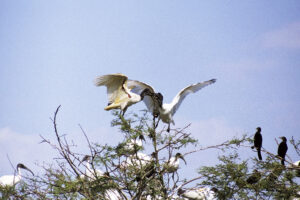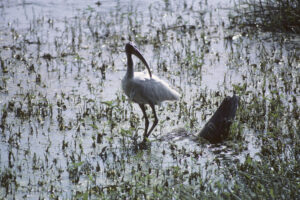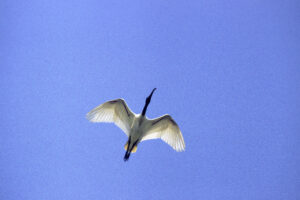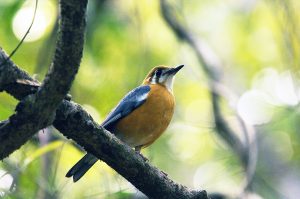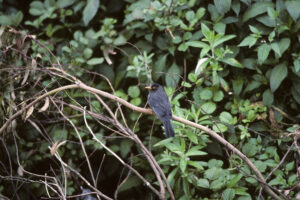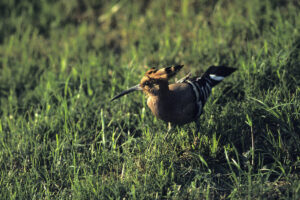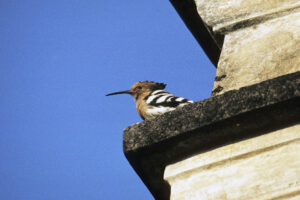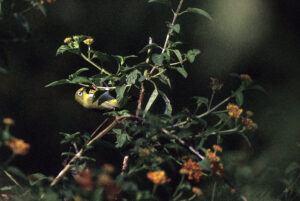Birds in the Indian Subcontinent
Sri Lanka blue magpie (Urocissa ornata), Sinharaja Forest Reserve, Sri Lanka. (Photo copyright © by Kaj Halberg)
Spot-billed pelicans (Pelecanus philippensis) at their nests in the village of Kokkare Belur, near Mysore, Karnataka. (Photo copyright © by Kaj Halberg)
On a hot spring day, a splendid peacock (Pavo cristatus) quenches his thirst at a waterhole, Sariska National Park, Rajasthan. The bird behind it is a red-wattled lapwing (Vanellus indicus). (Photo copyright © by Kaj Halberg)
A huge flock of demoiselle cranes (Grus virgo), resting in the Thar Desert, near Kichan, Rajasthan. (Photo copyright © by Kaj Halberg)
Sri Lanka junglefowl (Gallus lafayetii), Sinharaja Forest Reserve, Sri Lanka. (Photo copyright © by Kaj Halberg)
Feeding black-winged stilt (Himantopus himantopus) in evening light, near Jodhpur, Rajasthan. (Photo copyright © by Kaj Halberg)
White-rumped vultures (Gyps bengalensis), basking in the morning sun, Keoladeo National Park, Rajasthan. (Photo copyright © by Kaj Halberg)
“Almost any small animal will be attacked, and I have seen full-grown bulbuls and palm squirrels captured by it; eggs and nestlings are, of course, its delight.”
British ornithologist and entomologist George Morrison Henry (1891-1983) about the large-billed crow (Corvus macrorhynchos), in his book A guide to the Birds of Ceylon, first published 1955, 2nd ed. 1971.
This page deals with a selection of birds, which I have encountered during numerous visits to India, Pakistan, southern Nepal, and Sri Lanka, between 1974 and 2015. Birds observed in the Himalaya are presented on a separate page, see Animals – Birds: Birds in the Himalaya.
Families, genera and species are presented in alphabetical order. Nomenclature largely follows the IOC World Bird List (worldbirdnames.org), whereas information about etymology is often based on J.A. Jobling 2010. The Helm Dictionary of Scientific Bird Names, Christopher Helm, London.
As is obvious from most of the pictures below, I like to show the birds in their natural surroundings, or studies of their behaviour.
In case you find any errors on this page, I would be grateful to receive an email. You may use the address at the bottom of the page.
Map, showing Indian states and union territories. (Borrowed from www.mapsofindia.com)
Accipitridae Hawks, eagles, and allies
A huge family, comprising about 66 genera and c. 250 species of small to large raptors, distributed worldwide, with the exception of Antarctica.
Accipiter Sparrowhawks, goshawks
Comprising about 50 species, this is the largest genus in the family. In Europe, these birds are known as sparrowhawks (smaller species) or goshawks (larger species), in America simply as hawks. They are found on all continents, except Antarctica.
The generic name is the classical Latin word for hawks, derived from accipere (‘to grasp’), naturally alluding to the sharp talons.
Accipiter badius Shikra
This small raptor, divided into 6 subspecies, is distributed in open habitats in a vast area, from the Caucasus and southern Kazakhstan southwards to the Indian Peninsula, and thence eastwards to Indochina and the southernmost parts of China, and also from Senegal and Gambia eastwards across the Sahel zone to southern Sudan, Eritrea, south-western Saudi Arabia, and western Yemen, and thence southwards to central Namibia and northern South Africa, avoiding the rainforest area of the Congo Basin.
The specific name is Latin, meaning ‘chestnut-coloured’, alluding to the barring on the chest. The common name is Hindi, meaning ‘hunter’.
Shikra, Ranthambhor National Park, Rajasthan. (Photos copyright © by Kaj Halberg)
Evening light on a shikra, resting on a sandstone pole, Gudi, Rajasthan. (Photo copyright © by Kaj Halberg)
Aquila True eagles
A genus of 11 species, found in most parts of the world, except the polar regions, South America, and rainforest areas. The generic name is the classical Latin word for eagle, perhaps derived from aquilus (‘dark in colour’).
Aquila heliaca Imperial eagle
This species breeds from eastern Europe and Turkey across the Central Asian steppes to south-central Siberia, Mongolia, and northern China. It is migratory, spending the winter at scattered locations from Turkey and the Nile Delta eastwards to eastern China, Korea, and southern Japan, southwards to Kenya, northern India, and Indochina.
Previously, birds in southern Spain and Portugal were regarded as a subspecies of the imperial eagle, but are now generally considered a separate species, the Iberian imperial eagle (A. adalberti).
The specific name is derived from Ancient Greek heliakos (‘of the sun’), from helios (‘sun’), or heleios, a kind of hawk mentioned by Greek grammarian Hesychius of Alexandria (5th or 6th Century A.D.) in his work Lexicon.
Adult imperial eagle, Haleji Wildlife Sanctuary, Sindh, Pakistan. (Photo copyright © by Kaj Halberg)
Aquila nipalensis Steppe eagle
A large eagle, breeding from eastern Ukraine eastwards across the Asian steppes to northern China. It differs from other eagles in mainly nesting on the ground, and it has specialized in feeding on ground squirrels. It is migratory, spending the winter from Arabia eastwards to southern China, and in eastern and southern Africa.
The specific name was given by British naturalist and ethnologist Brian Houghton Hodgson (1801-1894), who described the bird in 1833 after collecting a specimen in Nepal. Presumably, he thought that it was a local species.
Immature steppe eagles, Keoladeo National Park, Rajasthan. (Photos copyright © by Kaj Halberg)
Aquila rapax Tawny eagle
Divided into 3 subspecies, this eagle is breeding in the Indian Subcontinent, in the major part of sub-Saharan Africa, and in scattered locations in north-western Africa, south-western Arabia, and Iran. The plumage is highly variable, with distinct pale and dark morphs, and various intermediate forms.
In some plumages, this species is very similar to the steppe eagle (above), but the yellow gape of that species extends to the back end of the eye, whereas the gape of a tawny only extends to the middle of the eye. However, you have to be rather close to the bird to observe the difference.
The specific name is derived from the Latin rapere (‘to seize’).
Tawny eagle, taking off from a tree, Geramki Dhani, Thar Desert, Rajasthan. (Photos copyright © by Kaj Halberg)
Buteo Buzzards
A genus of about 28 species, distributed on all continents, except Australia and Antarctica. In the Old World, these birds are known as buzzards, whereas the term hawk is often used in North America.
The generic name is the classical Latin name of the common buzzard (B. buteo). The English name is derived from Old French busard, which is a corruption of the classical Latin name.
Buteo rufinus Long-legged buzzard
This large buzzard breeds in a vast area, from eastern Europe eastwards to Xinjiang, southwards to Arabia, Iran, and Afghanistan, and also in northern Africa. Northern populations are migratory, spending the winter as far south as Bangla Desh, northern India, Iran, Sudan, South Sudan, Ethiopia, and Kenya.
The specific name is Latin, meaning ‘golden-reddish’, alluding to the mainly rufous plumage of the bird.
Long-legged buzzard, taking off from a sandstone pillar, Lathi, Rajasthan. (Photos copyright © by Kaj Halberg)
Circaetus Snake-eagles
As their name implies, these birds feed mainly on snakes. There are 7 species, all restricted to Africa with the exception of the short-toed eagle (below).
The generic name is derived from the Greek kirkos, a type of hawk, in this connection associated with harriers (Circus); and aetos (‘eagle’).
Circaetus gallicus Short-toed eagle
A widely distributed eagle, breeding from the Baltic States eastwards to western Mongolia and northern China, southwards to the entire Indian Peninsula, and thence westwards to the Middle East, Arabia, southern Europe, and north-western Africa. With the exception of the birds in Pakistan and India, all populations are migratory, mainly spending the winter in the Sahel Zone of Africa.
The specific name is Latin, meaning ‘from Gaul’, a term that in the Roman Era covered the major part of western Europe.
Short-toed eagle, Corbett National Park, Uttarakhand. (Photo copyright © by Kaj Halberg)
Clanga Spotted eagles
A small genus with 3 species, distributed from eastern Europe across the boreal zone of Siberia to the Pacific Ocean, and one resident species in northern India. The two northern species are migratory. They were previously placed in the genus Aquila (above).
In Ancient Greek, klangos was an alternative form of plankos, the name of a kind of eagle. In classical Latin, clango had several meanings, including ‘I scream’. Thus, the generic name may be translated to ‘ the screaming eagle’.
Clanga clanga Greater spotted eagle
A uniform dark brown eagle with very broad wings and a short tail. A good field mark is a whitish ‘comma’ at the wrist of the underwing. Immatures have numerous prominent whitish spots on the back and upperwing.
It breeds from eastern Europe eastwards across the taiga belt to north-eastern China and Ussuriland (south-eastern Siberia). It is migratory, spending the winter in southern Europe, north-eastern Africa, Arabia, the Middle East, the northern part of the Indian Subcontinent, Indochina, and eastern China.
Greater spotted eagle, Haleji Wildlife Sanctuary, Sindh, Pakistan. Note the white ‘comma’ at the wrist of the underwing. (Photos copyright © by Kaj Halberg)
Elanus Small kites
Members of this genus, comprising 4 quite similar species of small white, grey, and black raptors, are distributed throughout almost the entire globe, although they avoid colder areas.
The generic name is a Latinized form of elanos, the Ancient Greek word for kite.
Elanus caeruleus Black-winged kite
This bird has a very wide distribution, found in all of sub-Saharan Africa, in north-western Africa, the Iberian Peninsula, France, the Nile Valley of Egypt, at several locations throughout the Middle East, from the entire Indian Subcontinent eastwards to southern China and Taiwan, and thence southwards through Indochina and the Philippines to Indonesia and New Guinea.
The specific name is derived from the Latin caelum (‘sky’), and a diminutive suffix, thus ‘small sky’, i.e. having the colour of the sky, thus ‘sky-blue’, alluding to the bluish sheen in the plumage.
Black-winged kite, Haleji Wildlife Sanctuary, Sindh, Pakistan. (Photo copyright © by Kaj Halberg)
Black-winged kite, Corbett National Park, Uttarakhand. (Photo copyright © by Kaj Halberg)
Gyps Griffon vultures
A genus of 8 species of carrion-eating raptors, distributed in Europe, Asia, and Africa. The generic name is the Ancient Greek term for vulture.
Since the 1980s, most populations of vultures in the Indian Subcontinent have diminished alarmingly due to poisoning from diclofenac, a veterinary drug widely used to treat diseases in livestock. Research has shown that when the vultures feed on cattle carcasses, diclofenac will destroy their kidneys. In 2006, the Indian government announced a ban on the usage of diclofenac. Another drug, meloxicam, which seems to be a good substitute for diclofenac, is harmless to vultures. However, it is more expensive than diclofenac, and the ban has not had much effect, as it is largely ignored, probably by corrupt officials who benefit economically from the distribution of diclofenac.
Since 2016, re-introduction programmes have been instigated, primarily in nature reserves, where diclofenac is not present.
The African griffon species have also decreased dramatically in numbers in recent years, described on the page Animals – Birds: Birds in Africa.
Gyps bengalensis White-rumped vulture
Formerly, this bird was abundant in Pakistan, the Indian Peninsula, and Indochina, and in the 1980s the global population was estimated at several million individuals, making it the most abundant large bird of prey in the world. However, in the 1990s the population in India plummeted due to the widespread usage of diclofenac (see genus above), and in Indochina it disappeared due to the the lack of available carcasses. In 2021, it was believed that the world population was less than 6,000 adults.
The specific name is Latin, meaning ‘of Bengal’. Strictly speaking, Bengal is the lowland around the Ganges-Brahmaputra delta, but in 1788, when German naturalist Johann Friedrich Gmelin (1748-1804) described the bird, the term ‘Bengal’ indicated a much larger portion of northern India.
White-rumped vulture, resting on the spire of a Hindu temple, Jaisalmer, Rajasthan. (Photo copyright © by Kaj Halberg)
White-rumped vultures take off from a tree, Sukkur, Pakistan. (Photo copyright © by Kaj Halberg)
White-rumped vultures and one slender-billed vulture (Gyps tenuirostris, the pale bird), basking in the morning sun, Keoladeo National Park, Rajasthan. (Photo copyright © by Kaj Halberg)
White-rumped vulture, just about to land, Ambala, Haryana. (Photo copyright © by Kaj Halberg)
White-rumped vultures and dogs, fighting over the remains of a cow, Lahore, Pakistan. In the foreground, house crows (Corvus splendens) are waiting for tidbits. (Photo copyright © by Kaj Halberg)
White-rumped vultures have eaten a dead water buffalo. Now workers of a certain cast are collecting the remains (bones and hide), taking them away on a bicycle. – Ambala, Haryana. (Photos copyright © by Kaj Halberg)
White-rumped vultures, digesting after eating from a dead buffalo, Ambala, Haryana. Note the swelled gizzards. (Photos copyright © by Kaj Halberg)
These white-rumped vultures are fighting over a dead dog, beating their great wings, raising a cloud of dust. Meanwhile, the other vultures take advantage to eat from the carcass. – Jaisalmer, Rajasthan. (Photo copyright © by Kaj Halberg)
Gyps indicus Indian vulture
This bird resembles the white-rumped vulture (above), but has paler upperwings, and the underwing coverts are not as white as in that species. It was formerly widely distributed in Peninsular India, but has largely disappeared due to the usage of diclofenac (see genus above).
Indian vultures, drinking from a waterhole, Sariska National Park, Rajasthan. (Photos copyright © by Kaj Halberg)
Haliaeetus Sea-eagles, fish-eagles
A genus of 10 species, widely distributed in Africa and Eurasia, with a single species in North America.
The generic name is derived from Ancient Greek hali (‘of the sea’) and aetos (‘eagle’). Despite the name ‘sea-eagle’, many of the species are living at freshwater areas inland. These species are termed ‘fish-eagles’.
Haliaeetus ichthyaetus Grey-headed fish-eagle
This species lives along rivers and lake shores, and in swamps. Adults are handsome birds, with brownish-grey head and breast, white belly, and a white tail with a broad black band at the tip.
The specific name is derived from Ancient Greek ikhthys (‘fish’) and aetos (‘eagle’).
Some authorities place this bird in the genus Ichthyophaga, together with the lesser fish-eagle (H. humilis).
Grey-headed fish-eagle, Rapti River, southern Nepal. (Photos copyright © by Kaj Halberg)
Haliaeetus leucogaster White-bellied sea-eagle
This beautiful eagle is widely distributed, found along coasts from western India eastwards to southern China and the Philippines, southwards to Sri Lanka and Australia. It has declined in later years, but is still fairly common in many places.
The specific name is derived from Ancient Greek leukos (‘white’) and gaster (‘belly’).
Adult white-bellied sea-eagle, Bundala, near Hambantota, Sri Lanka. (Photo copyright © by Kaj Halberg)
Immature white-bellied sea-eagle, Yala National Park, Sri Lanka. (Photo copyright © by Kaj Halberg)
Haliaeetus leucoryphus Pallas’s fish-eagle
This eagle breeds from Russia and Turkmenistan eastwards to northern China, southwards to India and Myanmar. It has declined drastically during the last 50 years, mainly due to increased usage of pesticides. It is listed as ‘endangered’ on the IUCN Red List of threatened species. Northern populations are migratory, wintering from northern India westwards to the Persian Gulf.
The specific name is derived from Ancient Greek leukos (‘white’) and koryphe (‘crown’).
The common name commemorates Prussian naturalist, ethnographer, and explorer Peter Simon Pallas (1741-1811), who, in 1767, was invited by Catherine II of Russia to become a professor at the St. Petersburg Academy of Sciences. Between 1768 and 1774, he led an expedition to the Caspian Sea, the Ural and Altai Mountains, Lake Baikal, and the upper Amur River. His work from this expedition was published in 3 volumes 1771-1776, titled Reise durch verschiedene Provinzen des Russischen Reichs (‘Journey through various provinces of the Russian Empire’).
In 1793 and 1794, Pallas led a second expedition to southern Russia, visiting the Crimea, the Black and Caspian Seas, and the Caucasus Mountains. His account of this expedition was published 1799-1801, titled Bemerkungen auf einer Reise in die Südlichen Statthalterschaften des Russischen Reichs (‘Notes from a trip to the southern lieutenancies of the Russian Empire’).
Nest of Pallas’s fish-eagle, Haleji Wildlife Sanctuary, Sindh, Pakistan. (Photo copyright © by Kaj Halberg)
Nests of Pallas’s fish-eagle, Keoladeo National Park, Rajasthan. A full-grown young is seen in the nest in the lower picture. (Photos copyright © by Kaj Halberg)
Pallas’s fish-eagle, Keoladeo National Park. (Photos copyright © by Kaj Halberg)
Haliastur Kites
A small genus with two species, the widespread Brahminy kite (below), and the whistling kite (H. sphenurus) of Australia, New Caledonia, and New Guinea.
The generic name is derived from Ancient Greek hali (‘of the sea’), and the Latin astur (‘hawk’).
Haliastur indus Brahminy kite
This common species is found at coasts and inland wetlands, from Pakistan eastwards to Vietnam and the Philippines, New Guinea, and the Solomon Islands, southwards to Sri Lanka and northern and eastern Australia.
The Brahminy kite is sacred to Hindus, reflected in the common name, which alludes to the highest Hindu cast, the Brahmins. In Hindu mythology, it is referred to as Garuda, the ‘king of birds’, and carrier of the mighty god Vishnu. In Tamil, it is known as Krishna parunthu (‘Krishna’s eagle’). Krishna is an avatar (incarnation) of Vishnu (more about this issue on the page Religion: Hinduism).
Brahminy kite, Minneriya Wewa Lake, near Sigiriya, Sri Lanka. (Photo copyright © by Kaj Halberg)
Brahminy kites, Wirawila Wewa Lake, near Hambantota, Sri Lanka. (Photo copyright © by Kaj Halberg)
Milvus Kites
A small genus of 3-4 species, erected in 1799 by French naturalist Bernard Germain de Lacépède (1756-1825). The generic name is the Latin name of the red kite (M. milvus).
Milvus migrans Black kite
A very widespread species, divided into 5 subspecies. It is found from central and southern Europe and northern Africa eastwards across Asia to Japan and Taiwan, and thence southwards to New Guinea and Australia.
The rather pale subspecies govinda is distributed from eastern Pakistan eastwards across warmer parts of India and Sri Lanka to Indochina and the Malay Peninsula. It is often observed in urban areas. In the higher parts of the Himalaya, it is replaced by subspecies lineatus, which is widespread in Central and East Asia.
The specific name is derived from the Latin migrare (‘to migrate’), alluding to the northernmost populations being migratory.
The subspecific name govinda alludes to the Hindu god Krishna, an avatar (incarnation) of the mighty god Vishnu. It is told that Krishna persuaded people who lived beneath the mountain Govardhana to worship the mountain instead of the rain god Indra, as he was of the opinion that the mountain, rather than the rain god, provided them with nourishment. Indra got furious, when the people no longer worshipped him and, as a punishment, sent torrential rain in order to drown people and cattle. However, Krishna protected them by raising the mountain, so that they could seek shelter beneath it. Indra acknowledged the superiority of Krishna, giving him the name Govinda, meaning ‘protector of cattle’.
Krishna and other Hindu gods are described in depth on the page Religion: Hinduism.
Black kite, ssp. govinda, and a feral pigeon (Columba livia), Udaipur, Rajasthan. (Photo copyright © by Kaj Halberg)
Black kite, ssp. govinda, Varanasi, Uttar Pradesh. (Photos copyright © by Kaj Halberg)
Neophron percnopterus Egyptian vulture
This small vulture, the only member of the genus, has a very wide distribution, found from the Mediterranean eastwards across the Middle East to Kazakhstan and the Indian Subcontinent, and in the Sahel Zone of Africa, southwards to northern Tanzania. It also once had a resident population in Angola, Namibia, and South Africa, which is now considered extinct.
Three subspecies are currently recognized, the nominate northern and African birds, which have a mainly grey bill, Indian birds of subspecies ginginianus with a yellow bill, and finally a separate, larger subspecies, majorensis, in the eastern Canary Islands.
It lives in open areas, nesting on cliffs, less frequently in trees. Besides feeding on carcasses, it is often encountered at rubbish dumps, and it will also prey on small mammals, birds, and reptiles. It is among the few bird species known to use tools. Eggs of other birds, which are too large to break open with the bill, are broken by tossing stones onto them, using the bill.
This species is in decline over much of its range due to habitat destruction, hunting, poisoning, and collision with power lines.
The generic name stems from the Greek mythology. Neophron and Aegypius were young men and close friends, but it upset Neophron that his mother Timandra was having a love affair with Aegypius. To punish Aegypius, Neophron made advances towards Aegypius’ mother, Bulis. He succeeded and enticed Bulis into entering the dark chamber where his mother and Aegypius were soon to meet. Neophron then distracted his mother, tricking Aegypius into entering the chamber and sleeping with his own mother. When Bulis discovered the deception, she gouged out the eyes of her son before killing herself. Aegypius prayed for revenge, but Zeus, instead of helping him, changed both young men into vultures as a punishment.
The specific name is derived from the Greek perknos (‘dark-coloured’) and pteron (‘wing’).
In ancient Egypt, the bird was held sacred to the Moon God Isis, and its protection by Pharaonic law made it common in the streets, giving rise to the name pharaoh’s chicken.
On a hot spring day, an Egyptian vulture quenches its thirst at a waterhole, Sariska National Park, Rajasthan. (Photo copyright © by Kaj Halberg)
Nisaetus Old World hawk-eagles
This genus of 10 species is found in tropical and subtropical Asia, from Pakistan eastwards to Japan and Taiwan, and thence southwards to the Philippines and Indonesia. They were earlier placed within the genus Spizaetus, which then consisted of Old World as well as New World eagles. However, genetic research has shown that the two groups are not closely related, and, consequently, the Old World species were moved to a separate genus.
The generic name is derived from Ancient Greek, from the name Nisos, and aetos (‘eagle’). Nisos was a king of Megara, who possessed a purple lock of hair, which would protect him and his kingdom. According to one version of the legend, when King Minos of Crete besieged Megara, he tempted Nisos’s daughter Scylla with a golden necklace to betray and kill her father. In another version, she fell in love with Minos from a distance, and after cutting off her father’s purple lock, she presented it to Minos. However, Minos was disgusted with her act, calling her a disgrace. As Minos’s ships set sail, Scylla attempted to climb up one of them, but Nisos, who had turned into a sea eagle, attacked her, and she fell into the water and drowned. She was changed into a bird, possibly a heron, constantly pursued by Nisos.
Nisaetus cirrhatus Crested hawk-eagle
Divided into at least 5 subspecies, this eagle, also known as changeable hawk-eagle, is widely distributed, found from Pakistan and southern Nepal eastwards to Vietnam and the Philippines, southwards to Sri Lanka and Indonesia.
The endemic Sri Lankan race ceylanensis has a proportionally longer crest than the other subspecies, to 10 cm long.
The specific name is derived from the Latin cirrus (‘tendril’), thus ‘having tendrils’, alluding to the long, wavy crest, which may sometimes look twisted.
Formerly, this species was regarded as two separate species, the crested hawk-eagle (subspecies cirrhatus and ceylanensis of southern India and Sri Lanka), and the crestless changeable hawk-eagle (subspecies limnaeetus, andamanensis, and vanheurni). Some authorities retain this split.
Immature crested hawk-eagle, ssp. limneatus, Rapti River, southern Nepal. (Photo copyright © by Kaj Halberg)
Crested hawk-eagle, ssp. ceylanensis, Yala National Park, Sri Lanka. (Photos copyright © by Kaj Halberg)
Pernis Honey-buzzards
A small genus with 4 species, the crested honey-buzzard (below), the European honey-buzzard (P. apivorus), the barred honey-buzzard (P. celebensis), which lives in Sulawesi, and the Philippine honey-buzzard (P. steerei), which is restricted to the Philippines.
The generic name is derived from Ancient Greek pernes, a word used by Greek scientist and philosopher Aristotle (384-322 B.C.) for a bird of prey. The common name refers to the fact that a significant part of the food of these birds consists of honey combs and wasp larvae.
Pernis ptilorhynchus Crested honey-buzzard
This bird is widely distributed in Asia, found from Kazakhstan and southern Siberia eastwards to north-eastern China and Japan, southwards to Sri Lanka, Indonesia, and the Philippines.
The specific name is Ancient Greek, meaning ‘feathered bill’, derived from ptilon (‘feather’) and rhynkhos (‘bill’).
Crested honey-buzzard, ssp. ruficollis, resting in a silk-cotton tree (Bombax ceiba), Rapti River, southern Nepal. (Photo copyright © by Kaj Halberg)
Sarcogyps calvus Red-headed vulture
This striking bird, previously known as king vulture, was once widespread in the Indian Peninsula and Indochina, but has declined drastically since the introduction of diclofenac in Indian cattle farming (see genus Gyps above). Today, it has a scattered occurrence in India, Myanmar, the Yunnan province, and Indochina.
It is the only member of the genus, but is quite closely related to the African lappet-faced vulture (Torgos tracheliotos), which is presented on the page Animals – Birds: Birds in Africa.
The generic name is derived from Ancient Greek sarx (‘flesh’) and gyps (‘vulture’), whereas the specific name is Latin, meaning ‘bald’, alluding to the naked red head of the bird.
Red-headed vulture, Keoladeo National Park, Rajasthan. (Photos copyright © by Kaj Halberg)
Red-headed vulture, Corbett National Park, Uttarakhand. (Photo copyright © by Kaj Halberg)
Spilornis Serpent-eagles
At least 6 species of these birds are found in forests of southern Asia. They often feed on snakes, hence their common name. The generic name is derived from Ancient Greek spilos (‘spot’) and ornis (‘bird’), given in allusion to the white spots on breast and wings of the crested serpent-eagle (below).
Spilornis cheela Crested serpent-eagle
This eagle, comprising a large number of subspecies, is distributed from the Indian Subcontinent eastwards to southern Japan and Taiwan, and thence southwards to the Philippines and Indonesia. It is very variable, and some authorities propose treating several of the subspecies as separate species.
The specific name is derived from the Hindi word cheel (‘hawk’ or ‘kite’).
A dead tree in Ranthambhor National Park, Rajasthan, serves as a lookout perch for this crested serpent-eagle. (Photos copyright © by Kaj Halberg)
This one is perched on a dead tree in Keoladeo National Park, Rajasthan. (Photo copyright © by Kaj Halberg)
Spilornis elgini Andaman serpent-eagle
As its common name implies, this bird is endemic to the Andaman Islands. It has declined in later years. An alternative name is dark serpent-eagle.
The specific name honours James Bruce, 8th Earl of Elgin (1811-1863), who was Governor-General of India 1860-1863.
Immature Andaman serpent-eagle, Chidiyatappu, Andaman Islands. (Photo copyright © by Kaj Halberg)
Alaudidae Larks
This family contains 21 genera with about 100 species, distributed in Africa and Eurasia, with a single species reaching the Americas, and Australia, respectively.
Alauda
A small genus of 4 species, distributed in Eurasia and northern Africa. The generic name is the classical Latin word for lark.
Alauda gulgula Oriental skylark
This bird, divided into about 13 subspecies, is widely distributed, from Iran and Turkmenistan eastwards to Qinghai, Gansu, and south-western Inner Mongolia, southwards across the Pamir Mountains, the Tibetan plateau, and China to south India and Sri Lanka, Indochina, and the Philippines.
The specific name probably refers to the fine song of this species, from the Latin gula (‘throat’).
Oriental skylark, Bundala, near Hambantota, Sri Lanka. (Photo copyright © by Kaj Halberg)
Ammomanes Desert larks
Following genetic research, this genus now contains only 3 species, whereas 4 others have been moved to other genera. The 3 remaining species are distributed from northern Africa eastwards to Kazakhstan and the Indian Peninsula.
The generic name is derived from the Greek ammos (‘sand’) and manes (‘passionately fond of’), from mania (‘passion’), alluding to the fact that these birds mainly live in sandy areas.
Ammomanes phoenicura Rufous-tailed lark
This species is endemic to Peninsular India. It has a scattered occurrence in Pakistan and southern Nepal, whereas it is widespread and common in India.
The specific name is derived from Ancient Greek phoinix (‘red’) and oura (‘tail’).
Rufous-tailed lark, Keoladeo National Park, Rajasthan. (Photo copyright © by Kaj Halberg)
Rufous-tailed lark, Ranthambhor National Park, Rajasthan. (Photo copyright © by Kaj Halberg)
Eremopterix Sparrow-larks
These small larks, comprising 8 species, were named due to their resemblance to sparrows. They are also known as finch-larks. The genus is found in Africa, Madagascar, the southern part of Arabia, southern Iran, and the Indian Subcontinent.
The generic name is derived from the Greek eremos (‘desert’) and pteron (‘wing’), i.e. ‘birds of the desert’.
Eremopterix griseus Ashy-crowned sparrow-lark
This bird, also called ashy-crowned finch-lark, is widespread in all countries of the Indian Subcontinent, but is found nowhere else. It lives along sandy rivers and in shrubberies, grasslands, and farmland, but avoids the harshest desert areas, where its close relative, the black-crowned sparrow-lark (E. nigriceps), is common.
The specific name is Latin, meaning ‘grey’, alluding to the dominant colour of the bird.
Ashy-crowned sparrow-lark, Koshi Barrage, southern Nepal. (Photos copyright © by Kaj Halberg)
Ashy-crowned sparrow-lark, Ranthambhor National Park, Rajasthan. (Photos copyright © by Kaj Halberg)
Mirafra Bush-larks
As of today, this genus contains about 24 species, distributed in sub-Saharan Africa, southern parts of Asia, and Australia. Following genetic studies, many other former members of the genus have been moved to other genera.
The etymology of the generic name is obscure.
Mirafra affinis Jerdon’s bush-lark
This bird is restricted to drier areas of Tamil Nadu, south-eastern India, and Sri Lanka. It is very similar to other Indian bush-larks, but generally has a more whitish underside. It was previously regarded as a subspecies of the Bengal bush-lark (M. assamica), reflected in the specific name, which is Latin, meaning ‘related to’ or ‘similar to’.
The common name commemorates British physician and naturalist Thomas Caverhill Jerdon (1811-1872), who described many birds species in India, several of which are named after him.
Singing Jerdon’s bush-lark, Polonnaruwa, Sri Lanka. (Photo copyright © by Kaj Halberg)
Alcedinidae Kingfishers
Kingfishers, comprising about 114 species of small to medium-sized, often brilliantly coloured birds, are characterized by having a large head, a long, sharp, pointed bill, and very short legs. As their name implies, most of these birds eat fish, although many species live away from water, eating mainly small invertebrates.
These birds are divided into 3 subfamilies: river kingfishers (Alcedininae), tree kingfishers (Halcyoninae), and water kingfishers (Cerylinae).
Alcedo
A small genus of 7 species of river kingfishers (Alcedininae), all feeding almost exclusively on fish. 4 species are restricted to warmer parts of Asia, 2 to sub-Saharan Africa. The seventh species is presented below.
The generic name is the classical Latin word for kingfisher.
Alcedo atthis Common kingfisher
This colourful bird has a very wide distribution, from western Europe across Asia to Sakhalin and Japan, and southwards to North Africa, Iraq, Sri Lanka, Indonesia, and New Guinea.
There are three possible explanations to the specific name, all from the Greek mythology. 1) A handsome, richly dressed Indian youth, son of Limniace, nymph of the Ganges. 2) A beautiful young woman of Lesbos, favourite of the female poet Sappho (c. 630-570 B.C.). 3) An Athenian princess, daughter of King Cranaus and his wife Pedias. Jobling (2010) favours the Indian youth.
Common kingfisher, ssp. bengalensis, Keoladeo National Park, Rajasthan. (Photo copyright © by Kaj Halberg)
Ceryle rudis Pied kingfisher
This species, the only member of the genus, belongs to the water kingfishers (Cerylinae). It has a very wide distribution, found in sub-Saharan Africa and Egypt, and in Asia, from Turkey eastwards across the Middle East, the Indian Subcontinent, and Indochina to south-eastern China.
The generic name is derived from the Greek kerylos, an unidentified bird mentioned by scientist and philosopher Aristotle (384-322 B.C.) and other authors. This bird was probably mythical, associated with the halkyon (see genus Halcyon below).
The specific name is Latin, meaning ‘rude’ or ‘uncultivated’. This strange name was applied by Swedish naturalist Fredrik Hasselquist (1722-1752) who probably confused the Latin word hispida (‘kingfisher’) with hispidus (‘rough’ or ‘rude’).
Pied kingfisher, Haleji Wildlife Sanctuary, Sindh, Pakistan. (Photo copyright © by Kaj Halberg)
Hovering pied kingfisher, Haleji Wildlife Sanctuary. (Photo copyright © by Kaj Halberg)
Halcyon
A genus with 11 medium-sized kingfishers, of the subfamily tree kingfishers (Halcyoninae). They are distributed in warmer areas of Africa and Asia.
The generic name is associated with a bird of Greek legend, called Halcyon, generally thought to be the common kingfisher (Alcedo atthis). The Ancients believed that this bird made a floating nest in the Aegean Sea and had the power to calm the waves while brooding her eggs. Two weeks of calm weather were to be expected when the Halcyon was nesting, which took place around winter solstice. These Halcyon days were generally regarded as beginning on the 14th or 15th of December.
This belief in the bird’s power to calm the sea originated in a myth recorded by Roman poet Publius Ovidius Naso (43 B.C. – c. 17 A.D.), known as Ovid. The story goes that Aeolus, ruler of the winds, had a daughter named Alcyone, who was married to Ceyx, the king of Thessaly. Ceyx drowned at sea, and in her grief, Alcyone threw herself into the waves. However, instead of drowning, she was transformed into a bird and carried to her husband by the wind. (Source: phrases.org.uk)
Halcyon pileata Black-capped kingfisher
A widespread species, found from India eastwards to China and Korea, southwards to Sri Lanka and Indonesia.
The specific name is Latin, meaning ‘capped’, derived from pileus (‘cap’).
Black-capped kingfisher, resting in a Casuarina tree, Bhitarkanika Wildlife Reserve, Maipura River delta, Odisha. (Photo copyright © by Kaj Halberg)
Halcyon smyrnensis White-breasted kingfisher, white-throated kingfisher
This common bird is widely distributed in Asia, from Turkey and northern Arabia eastwards to eastern China and the Philippines, southwards to Sri Lanka and the Malay Peninsula.
The specific name refers to the Ancient Greek city of Smyrna, now called Izmir, in what is today western Turkey. Initially, Swedish naturalist Carl Linnaeus (1707-1778) named this bird Alcedo smyrnensis, citing the work A natural history of birds : illustrated with a hundred and one copper plates, curiously engraven from the life (1731-1738), by English naturalist and illustrator Eleazar Albin (c. 1690-1742), which includes a description and an illustration of the Smirna kingfisher.
White-breasted kingfisher, Keoladeo National Park, Rajasthan. (Photo copyright © by Kaj Halberg)
White-breasted kingfisher, sitting on a stem of common reed (Phragmites australis), Haleji Wildlife Sanctuary, Sindh, Pakistan. (Photo copyright © by Kaj Halberg)
Todiramphus
This genus, comprising about 30 species of the subfamily tree kingfishers (Halcyoninae), is widely distributed, found from north-eastern Africa and the Arabian Peninsula eastwards across southern Asia and Australasia to Polynesia.
The generic name is derived from the genus name Todus (todies, small New World birds, resembling kingfishers), and Ancient Greek rhamphos (‘bill’), thus ‘with a bill like todies’.
Todiramphus chloris Collared kingfisher
Divided into about 14 subspecies, this bird is very widespread, found from the Red Sea and the Arabian Peninsula eastwards across southern Asia and Australasia to Micronesia. It lives in coastal areas and is partial to mangrove swamps.
The specific name is a Latinized version of Ancient Greek khloros (‘green’).
Collared kingfisher, subspecies davisoni, resting in a mangrove tree, Havelock Island, Andaman Islands. This subspecies is endemic to the Andamans and the Coco Islands, a little further north. (Photo copyright © by Kaj Halberg)
Anatidae Ducks, geese, and swans
At present, this large worldwide family contains 43 genera with about 146 species.
Anas
Following genetic studies, this formerly very large genus has been divided into 7 genera, and today it contains 31 species.
The generic name is the classical Latin word for duck.
Anas acuta Northern pintail
Avoiding the harshest areas of the Arctic, this handsome duck breeds across the northern hemisphere, from Iceland, Norway, and Denmark eastwards to the Pacific, and also from Alaska and Canada southwards to central United States. It is a scarce breeding bird in central and eastern Europe, and in Turkey.
The winter months are spent in the southern half of North America, in Central America and the Caribbean, in the major part of Europe and the Middle East, in northern and eastern Africa, and in the Indian Subcontinent, Indochina, southern China, Taiwan, and the northern Philippines.
The specific name is Latin, meaning ‘sharp-pointed’, like the common name alluding to the long, pointed tail.
A pair of northern pintail, Gadhi Sagar, Jaisalmer, Rajasthan. The birds in the background, from left: Red-wattled lapwing (Vanellus indicus), redshank (Tringa totanus), male pintail, white-tailed lapwing (Vanellus leucurus), and common teal (Anas crecca). (Photo copyright © by Kaj Halberg)
Silhouettes of feeding northern pintails, Ranthambhor National Park, Rajasthan. (Photo copyright © by Kaj Halberg)
Anas poecilorhyncha Indian spot-billed duck
This bird was named for the yellow point of the otherwise black bill. It is distributed in the Indian Subcontinent and Indochina. Previously, birds found from south-eastern Siberia southwards through China and Japan to northern Indochina were regarded as a race of the Indian spot-billed duck, but are now considered a separate species by most authorities, named eastern spot-billed duck (A. zonorhyncha). The two species overlap in southern China and north-eastern Indochina, but research has shown that interbreeding very rarely takes place.
The specific name is derived from Ancient Greek poikilos (‘pied’ or ‘spotted’) and rhynkhos (‘bill’).
The eastern spot-billed duck is described on the page Animals – Birds: Birds in Taiwan.
Indian spot-billed ducks, Surya Lake Reservoir, Rajkot, Gujarat. (Photo copyright © by Kaj Halberg)
Spot-billed ducks, Keoladeo National Park, Rajasthan. (Photos copyright © by Kaj Halberg)
Anser Grey geese
A genus of 11 species, distributed in arctic and temperate areas of the Northern Hemisphere.
The generic name is the classical Latin word for goose.
Anser anser Greylag goose
As a breeding bird, this species is widely distributed in northern Eurasia, from Iceland and Britain across northern Europe and Central Asia to northern China, with a scattered occurrence in south-eastern Europe, Turkey, Iraq, and Iran.
In many countries, it now breeds in city parks, where it often becomes remarkably confiding – sometimes even showing a threatening attitude towards people (more about this issue on the page Animals: Urban animal life).
In winter, it occurs in Europe, north-western Africa, the Middle East, and from Afghanistan in a belt across the northern part of the Indian Subcontinent and Indochina to eastern China.
Greylag geese, Keoladeo National Park, Rajasthan. (Photo copyright © by Kaj Halberg)
Aythya
A genus of 12 species, chiefly found in the Northern Hemisphere, with one species in New Guinea, Australia, New Zealand, and on some Pacific islands, another one in New Zealand, and one in Madagascar. Two species are critically endangered, the East Asian Baer’s pochard (A. baeri) and Madagascar pochard (A. innotata).
The generic name is derived from Ancient Greek aithyia, an unidentified seabird, mentioned by Greek grammarian Hesychius of Alexandria (5th or 6th Century A.D.), and also by Greek philosopher and scientist Aristotle (384-322 B.C.).
Aythya ferina Common pochard
This handsome duck is breeding in a vast area, from central and northern Europe eastwards across the taiga belt to south-eastern Siberia, Mongolia, and north-eastern China, southwards to Turkey and Kyrgyzstan. Most populations are migratory, wintering in Europe, northern Africa, the Middle East, and from Pakistan and northern India eastwards across northern Indochina to southern China, Korea, Japan, Taiwan, and the northern Philippines.
The specific name is Latin, meaning ‘wild game’, derived from ferus (‘wild’).
Male common pochard, Lake Pichola, Udaipur, Rajasthan. (Photo copyright © by Kaj Halberg)
Dendrocygna Whistling-ducks
A genus of 8 species, distributed worldwide in tropical and subtropical areas.
The generic name is derived from the Greek dendron (‘tree’) and kyknos (‘swan’), alluding to the fact that these ducks often breed in tree cavities, and to their fairly long neck. Several members have clear, whistling calls, which gave rise to the popular name.
Dendrocygna javanica Lesser whistling-duck
This species is widely distributed, fround from Pakistan eastwards to southern China, and thence southwards to Sri Lanka and Indonesia. The Chinese populations are migratory.
The specific name refers to the Indonesian island Java. Presumably, the type specimen was collected there.
Lesser whistling-ducks, Yala National Park, Sri Lanka. (Photo copyright © by Kaj Halberg)
Lesser whistling-ducks, Keoladeo National Park, Rajasthan. (Photo copyright © by Kaj Halberg)
Netta
A small genus with 3 species, found from central and southern Europe eastwards to central Asia, in Africa, and in South America.
The generic name is Ancient Greek, meaning ‘duck’.
Netta rufina Red-crested pochard
The main breeding area of this beautiful duck is extreme southern Russia, Kazakhstan, Turkmenistan, Uzbekistan, Kyrgyzstan, Xinjiang, and western Mongolia, with a spotty occurrence in central and southern Europe, and Turkey. The winter months are spent in southern Europe, northern Africa, the Middle East, the Indian Subcontinent, and the Yunnan Province.
The specific name is Latin, meaning ‘golden-red’, derived from rufus (‘rufous’), alluding to the striking colour of the male’s head.
Red-crested pochard, Keoladeo National Park, Rajasthan. The bird to the left is a northern shoveler (Spatula clypeata). (Photo copyright © by Kaj Halberg)
Nettapus Pygmy geese
A small genus of 3 species of tiny ducks, the cotton pygmy goose (below), the African pygmy goose (N. auritus), which is widespread in Africa, and finally the green pygmy goose (N. pulchellus) of northern Australia and southern New Guinea.
Traditionally, these birds are called pygmy geese, although genetic research indicates that they are more closely related to dabbling ducks than to geese. The name alludes to the short, goose-like bill.
The generic name is derived from Ancient Greek netta (‘duck’) and pous (‘foot’), Apparently, German naturalist Johann Friedrich von Brandt (1802-1879), who erected the genus in 1836, regarded these birds as a kind of small geese due to their short bill, but also found that they possessed the feet and body of a duck.
Nettapus coromandelianus Cotton pygmy goose
This tiny duck is found from the Indian Subcontinent eastwards to southern China, in Indochina and Malaysia, a few places in Indonesia, and in New Guinea and north-eastern Australia. It is mainly sedentary, but disperses in winter.
The specific name refers to the Coromandel Coast, in present-day Karnataka. Presumably, the type specimen was collected there. The common name alludes to the dominant colour of the male.
Cotton pygmy goose, male and female, Keoladeo National Park, Rajasthan. (Photo copyright © by Kaj Halberg)
Sarkidiornis melanotos Knob-billed duck
This peculiar duck, with a large protuberance on the bill, is widely distributed in tropical wetlands in the Indian Subcontinent, Indochina, sub-Saharan Africa, and Madagascar. Previously, the very similar American comb duck, which lives in South America, was included in this species, but today many authorities regard it as a separate species, named S. sylvicola.
The generic name is probably derived from Ancient Greek sarx (‘meat’, or ‘body’) and ornis (‘bird’), maybe alluding to the compact body of the bird. The specific name is also from the Greek, from melas (‘black’) and noton (‘back’).
Knob-billed ducks, resting in a tree, Keoladeo National Park, Rajasthan. A bird is on its way up to the branch. (Photo copyright © by Kaj Halberg)
Spatula Shovelers and allies
The ducks of this genus, comprising 10 species of shovelers and teals, were formerly placed in the genus Anas. The genus Spatula had originally been proposed in 1822 by German zoologist and lawyer Friedrich Boie (1789-1870), who described many new species and several new genera of birds. He and his brother Heinrich also described about 50 new species of reptiles.
The generic name is the Latin word for ‘spoon’ or ‘spatula’, alluding to the spatulate bill of shovelers.
Spatula clypeata Northern shoveler
As a breeding bird, this species is widely distributed across the northern hemisphere, avoiding the harshest areas of the Arctic. It is found from Iceland, the British Isles, Spain, and Morocco eastwards across the taiga belt to the Pacific, and also in Alaska and western North America, southwards almost to the Mexican border.
The winter months are spent in the southern half of North America, in Central America and the Caribbean, in the major part of Europe and the Middle East, in northern and eastern Africa, and in the Indian Subcontinent, Southeast Asia, southern China, Korea, Japan, Taiwan, and the northern Philippines.
The specific name is Latin, meaning ‘shield-bearing’, alluding to the broad and flat bill.
A huge gathering of northern shovelers, wigeons (Mareca penelope), and common teals (Anas crecca), Lake Chilka, Odisha. (Photos copyright © by Kaj Halberg)
Feeding male northern shoveler, Keoladeo National Park, Rajasthan. (Photo copyright © by Kaj Halberg)
Tadorna Shelducks
A small genus of 6 species of large ducks, distributed in Eurasia, Africa, Australia, and New Zealand. One species, the crested shelduck (T. cristata) of Korea, may have gone extinct.
The generic name is from tadorne, the French name of the common shelduck (T. tadorna). It may have Celtic roots, meaning ‘pied waterfowl’. The English name, originally sheld duck, dates from around 1700, with a similar meaning.
Tadorna ferruginea Ruddy shelduck, Brahminy duck
The specific name of this colourful bird is Latin for ‘rusty’, referring to the plumage, which is mainly orange-brown. The head is paler, and tail and flight feathers are black, contrasting with the white wing-coverts. In India, this bird is known as Brahminy duck, likewise alluding to its colour, which resembles that of the robe of certain Brahmins (the uppermost caste of Hinduism).
This is essentially a Central Asian species, with breeding populations extending across the Middle East as far as south-eastern Europe, with isolated populations in north-western Africa and the highlands of Ethiopia. It is very common on the Tibetan Plateau.
It spends the winter months in the lowlands of northern Africa, Ethiopia, the Middle East, the Indian Subcontinent, northern Indochina, and southern China.
Ruddy shelducks, resting on sand bars in the Rapti River, southern Nepal. (Photos copyright © by Kaj Halberg)
Ruddy shelducks, Rapti River. (Photo copyright © by Kaj Halberg)
A pair of ruddy shelduck, Ranthambhor National Park, Rajasthan. A redshank (Tringa totanus) and other birds are seen in the background. (Photo copyright © by Kaj Halberg)
Anhingidae Darters
Darters, also called snakebirds due to their long, thin, flexible neck, are large water birds, comprising two or four species in the genus Anhinga, the sole genus of the family.
One or three species are found in the Old World. If only one species is acknowledged, it is called A. melanogaster. Most authorities, however, recognize three full species: Oriental (below), African (A. rufa), and Australasian (A. novaehollandiae). The American darter (A. anhinga) lives in the New World.
The generic name means ‘little head’ in the Tupi language of Brazil, referring to an evil spirit of the forests, the devil bird. (Source: G. Marcgrave 1648. Historiae rerum naturalium Brasiliae. Liber V)
Anhinga melanogaster Oriental darter
This species is resident in the Indian Subcontinent, Indochina, Indonesia, and the Philippines.
The specific name is derived from Ancient Greek melas (‘black’) and gaster (‘belly’).
Oriental darters, Keoladeo National Park, Rajasthan. (Photos copyright © by Kaj Halberg)
Oriental darters, drying their wings in the evening sun, Keoladeo National Park. (Photo copyright © by Kaj Halberg)
Swimming oriental darter, Keoladeo National Park. (Photo copyright © by Kaj Halberg)
This darter has just emerged from diving, creating concentric circles on the surface, Keoladeo National Park. (Photo copyright © by Kaj Halberg)
Ardeidae Herons, egrets, and bitterns
Herons, comprising 18 genera with about 64 species, are long-legged and long-beaked, fish-eating water birds, distributed worldwide with the exception of the polar regions. Some species are called egrets, mainly birds with ornate plumes during the breeding season, whereas birds of the genera Botaurus, Ixobrychus, and Zebrilus are called bitterns.
Many members of the family are presented on the page Fishing.
Ardea
A genus with about 13 species of mainly large herons, distributed almost worldwide. The generic name is the classical Latin word for herons.
Ardea cinerea Grey heron
The grey heron is widely distributed, found in the major part of Eurasia, Africa, and Madagascar.
The specific name is Latin, meaning ‘ash-coloured’.
Other pictures, depicting this bird, are shown on the pages Fishing, Animals – Birds: Birds in Taiwan, and Animals: Urban animal life.
In America, it is replaced by the similar, slightly larger great blue heron (A. herodias), presented on the page Animals – Birds: Birds in the United States and Canada.
Grey heron, reflected in a pond, Ranthambhor National Park, Rajasthan. An oriental darter (Anhinga melanogaster) and a little cormorant (Microcarbo niger) are also seen. (Photo copyright © by Kaj Halberg)
Grey heron in evening light, Keoladeo National Park, Rajasthan. (Photo copyright © by Kaj Halberg)
Grey heron, blurred by morning fog, Keoladeo National Park. (Photo copyright © by Kaj Halberg)
Ardea intermedia Yellow-billed egret, intermediate egret
This bird has a very wide distribution, found in sub-Saharan Africa, the Indian Subcontinent, East and Southeast Asia, and Australia. In East Asia, it breeds as far north as South Korea and southern Japan. These northern birds are migratory, spending the winter in Taiwan, the Philippines, Indochina, and Indonesia.
The specific name refers to its size, intermediate between the great white egret (Ardea alba) and the little egret (Egretta garzetta, below), both of which are also white.
Some authorities place this bird in a separate genus, Mesophoyx.
Yellow-billed egrets, taking off from a swamp, Ambala, Haryana. The bird with black bill is a little egret (Egretta garzetta), and the large bird in the background is a great white egret (Ardea alba). (Photo copyright © by Kaj Halberg)
Yellow-billed egrets, Keoladeo National Park, Rajasthan. (Photos copyright © by Kaj Halberg)
Ardea purpurea Purple heron
This species is very widely distributed, breeding in Africa south of the Sahara, on Madagascar, in central and southern Europe, around the Mediterranean eastwards to Kazakhstan, from Pakistan eastwards to China and Siberian Ussuriland, and thence southwards to the Philippines and Indonesia.
Purple heron, Keoladeo National Park, Rajasthan. (Photo copyright © by Kaj Halberg)
Ardeola Pond herons
A genus of 6 species of small herons, most of which are found in tropical areas of Asia and Africa. One species, the squacco heron (A. ralloides), breeds in southern Europe and the Middle East, migrating to Africa in autumn.
Most of the year, the plumage of these birds is buff or brownish, making them extremely well camouflaged among various types of vegetation. When they take to flight, however, they are transformed as if by magic, when their brilliant white wings are displayed.
The generic name is from the Latin ardea (‘heron’) and –ola, a suffix denoting something diminutive, thus ‘small heron’.
Ardeola grayii Indian pond heron, paddy bird
This bird breeds from southern Iran eastwards to the Indian Subcontinent and Myanmar. It is a very common resident in the lowlands, but is easily overlooked in its drab winter plumage when standing at the edge of lakes, ponds, or paddy fields. It relies on its camouflage to a degree that it can be approached closely before taking to flight. This behaviour gave rise to the Hindi name andha bagla (‘blind heron’), as well as the Sri Lankan name kana koka (‘half-blind heron’).
Formerly, this bird was shot for meat. In his book A New Account of the East Indies, from 1744, Alexander Hamilton writes the following: “They have also store of wild fowl; but who have a mind to eat them must shoot them. Flamingoes are large and good meat. The paddy-bird is also good in their season.”
The specific name honours British zoologist John Edward Gray (1800-1875), who was keeper of zoology at the British Museum in London 1840-1874, until the natural history department was re-named the Natural History Museum.
Indian pond heron in morning light, walking on floating leaves of red waterlily (Nymphaea rubra), east of Colva, Goa. (Photo copyright © by Kaj Halberg)
Indian pond heron, Haleji Wildlife Sanctuary, Sindh, Pakistan. (Photo copyright © by Kaj Halberg)
Indian pond heron, resting on a rock in a river, Anshi National Park, Karnataka. (Photo copyright © by Kaj Halberg)
Bubulcus ibis Cattle egret
This species is very widely distributed, found in most warmer areas of the world, only avoiding rain forests and desert areas. Originally, it was native to southern Spain and Portugal, the northern half of Africa, and across the Middle East and the Indian Subcontinent eastwards to Japan, and thence southwards to northern and eastern Australia.
However, in the late 1800s it began expanding its range into southern Africa, and in 1877 it was observed in northern South America, having apparently flown across the Atlantic Ocean. By the 1930s, it had become established as a breeding bird in this area, rapidly spreading to North America, where it is now found as far north as southern Canada. In later years, it has also spread northwards in Europe.
As its name implies, it often follows cattle to snap grasshoppers and other small animals, flushed by the grazers. It is also often observed in newly ploughed fields. The generic name is Latin, meaning ‘cowherd’. The specific name is the Ancient Greek term for ibises. Why it was applied to the cattle egret is not clear.
Today, some authorities split the cattle egret into two species, the western (B. ibis) and the eastern (B. coromandus). Apart from minor differences, they are identical, so why this split was made, is incomprehensible. I prefer to regard all cattle egrets as a single species.
Many other pictures, depicting this bird, are shown on the pages Animals – Birds: Birds in Taiwan, and Birds in the Himalaya.
Tree with breeding cattle egrets and little cormorants (Microcarbo niger), Aliwetawela, east of Badulla, Sri Lanka. (Photo copyright © by Kaj Halberg)
Cattle egrets, illuminated by morning sunlight, Keoladeo National Park, Rajasthan. (Photo copyright © by Kaj Halberg)
Cattle egret, using the back of a water buffalo (Bubalus bubalis) as a lookout post, Keoladeo National Park. (Photo copyright © by Kaj Halberg)
Egretta Egrets
A genus of 12 small to medium-sized herons, the major part breeding in warmer areas around the globe. Most members have black legs with bright yellow toes, and many develop ornate plumes during the breeding season.
The generic name is derived from Provençal French aigrette, a diminutive of aigron (‘heron’).
Egretta garzetta Little egret
The little egret is found in most tropical and subtropical areas of Europe, Africa, Asia, and Australia. In 1994, a small population was established on the Caribbean island Barbados, and the species has since spread to other Caribbean islands and to the Atlantic coast of the United States.
The specific name is the Italian name for the bird.
Little egret, feeding in the Rapti River, southern Nepal, and then taking off. (Photos copyright © by Kaj Halberg)
Feeding little egret, Keoladeo National Park, Rajasthan. (Photo copyright © by Kaj Halberg)
Nycticorax Night-herons
Today, this genus contains only two species, the black-crowned night-heron (below), which is distributed almost worldwide in warmer areas, and the Nankeen, or rufous, night-heron (N. caledonicus), which is distributed in Australia, New Zealand, Java, the Philippines, Papua New Guinea, New Caledonia, Palau, and the Solomon and Caroline Islands.
In historic times, 4 other species of the genus, which were all restricted to small islands in the Atlantic and Indian Oceans, have gone extinct.
The generic name is derived from the Greek nyktos (‘night’) and korax (‘raven’), referring to the mainly nocturnal feeding habits of these birds, and to their hoarse, raven-like call.
Nycticorax nycticorax Black-crowned night-heron
This smallish heron is common, found in most warmer parts of the world.
It figures in Japanese classical folklore, where it is called Goi-sagi, from goi (‘fifth rank’) and sagi (‘heron’). According to legend, the all-powerful Emperor Daigo (reigned 897-930 A.D.) ordered a vassal to capture a black-crowned night-heron. Upon hearing the imperial command, the heron submitted itself to capture. The emperor was pleased that the heron had confirmed his omnipotence over nature as well as man, whereupon he granted it the title ‘king of the herons’ and the position of fifth rank in his court, and released it unharmed. (Source: Jobling, 2010)
Black-crowned night-herons, resting in trees, Keoladeo National Park, Rajasthan. The speckled individuals are immature birds. (Photos copyright © by Kaj Halberg)
Black-crowned night-herons, Haleji Wildlife Sanctuary, Sindh, Pakistan. (Photo copyright © by Kaj Halberg)
Bucerotidae True hornbills
These peculiar birds, comprising about 54-58 species, are distributed in tropical Asia and Africa. They vary greatly in size, from the small West African black dwarf hornbill (Horizocerus hartlaubi), which is 30 cm long and weighs only c. 100 grams, to the huge rhinoceros hornbill (Buceros rhinoceros) in Malaysia and Indonesia, growing to about 1.2 m long and weighing up to 5.9 kg.
The family name and the name of the type genus, Buceros, are derived from the Greek bous (‘cow’) and keras (‘horn’), referring to a peculiar protuberance, or casque, on the bill of most species. Hornbills are very noisy, and the casque is probably a means to increase the volume of their call, which carries a long distance. The casque of males is larger than that of females.
A number of species are presented on the page Animals – Birds: Hornbills.
Ocyceros
This genus was established in 1873 by English naturalist Allan Octavian Hume (1829-1912), comprising 3 smaller hornbills in the Indian Subcontinent. Later, they were transferred to the genus Tockus, but have recently been moved back to Ocyceros.
The generic name is derived from Ancient Greek oxys (‘sharp’ or ‘pointed’) and keras (‘horn’).
Ocyceros birostris Indian grey hornbill
This bird is widely distributed, from north-eastern Pakistan (around Lahore) eastwards along the Himalaya to western Bangladesh, southwards through almost the entire Indian Peninsula. It lives from the lowlands up to an elevation of about 700 m. The male has a dark bill with a yellowish lower mandible, whereas that of the female is more yellow.
The specific name is derived from the Latin bi (two) and rostrum (‘bill’), alluding to the small protuberance on top of the bill, which, with a bit of imagination, looks like an extra bill.
Female Indian grey hornbill, Keoladeo National Park, Rajasthan. (Photo copyright © by Kaj Halberg)
Ocyceros griseus Malabar grey hornbill
An Indian endemic, found along the entire Western Ghats, from north of Mumbai to the southern tip of the peninsula. This species has no casque. The male has a reddish bill with a yellow tip, whereas that of the female is yellowish with black at the base of the lower mandible.
The specific name is Latin, meaning ‘grey’.
Male Malabar grey hornbill in morning light, Mahaveer Wildlife Sanctuary, Goa. (Photo copyright © by Kaj Halberg)
Burhinidae Thick-knees, stone-curlews
These birds comprise about 10 species in two genera, Burhinus and Esacus.
Esacus Stone-plovers
A small genus with only 2 species, distributed from southern Pakistan eastwards to Hainan, southwards to Sri Lanka, Indonesia, New Guinea, and northern Australia.
The generic name is derived from Ancient Greek aisakos. In Greek mythology, Aesacus was a prince of Troy, who was transformed into an unidentified bird. There are two versions of the myth. In one, Aesacus caused the death of the nymph Hesperie. He then committed suicide to share her days in eternity and was transformed into a long-necked, long-legged shorebird. In another version, he married Sterope. Mourning her premature death, he threw himself into the sea and was transformed into a cormorant. (Source: Jobling, 2010)
Esacus recurvirostris Great stone-plover
This large bird breeds along coasts, rivers, and lake shores, from Pakistan across the Indian Subcontinent and northern Indochina to Hainan.
The specific name is derived from the Latin recurvus (‘bent backwards’) and rostrum (‘bill’). The upper mandible is straight, whereas the lower one is curved, giving the impression that the bill is upturned.
Great stone-plover, Ramganga River, Corbett National Park, Uttarakhand. (Photo copyright © by Kaj Halberg)
Campephagidae Cuckooshrikes and allies
Members of this family are small to medium-sized passerines, found in subtropical and tropical regions of Africa, Asia, and New Guinea. The family has about 93 species, divided into 11 genera.
These birds are not closely related to cuckoos or shrikes. The name may refer to the grey colour of many cuckooshrikes, which makes them superficially resemble cuckoos.
Pericrocotus Minivets
A genus with about 15 species, found in forests from eastern Iran and Afghanistan eastwards across the Indian Subcontinent to China and Ussuriland in south-eastern Siberia, and thence southwards through Japan, Taiwan, Indochina and the Philippines to Indonesia.
Several of the species are very colourful, the males being predominantly red and black, the females yellow and black. Some members of the genus are presented on the pages Animals – Birds: Birds in Taiwan, and Birds in Bagan.
The generic name is derived from Ancient Greek peri (‘very’ or ‘all around’) and krokotos (‘golden-yellow’). The type specimen must have been a female!
The word minivet is of unknown origin.
Pericrocotus cinnamomeus Small minivet
This pretty bird is found in the Indian Subcontinent and Indochina, with a disjunct population in Java and Bali.
The specific name is derived from Ancient Greek kinnamon (‘cinnamon’), thus ‘cinnamon-coloured’.
Male small minivet, Ranthambhor National Park, Rajasthan. (Photo copyright © by Kaj Halberg)
Pericrocotus flammeus Orange minivet
This brilliantly coloured bird lives in dense forests, from western India and Sri Lanka eastwards to southern China, and thence southwards through Southeast Asia to Indonesia.
Formerly, it was regarded as a subspecies of the scarlet minivet, which is now called P. speciosus.
Male orange minivet, Anshi National Park, Karnataka. (Photo copyright © by Kaj Halberg)
Caprimulgidae Nightjars and nighthawks
This family of nocturnal or crepuscular birds is found on all continents except Antarctica. It is divided into 3 subfamilies, Caprimulginae (typical nightjars) with 14 genera and about 79 species, Eurostopodinae (eared nightjars) with 2 genera and 9 species, and Chordeilinae (nighthawks) with 3 genera and 10 species.
Caprimulgus Typical nightjars
A large genus with about 37 species, found in Eurasia, Africa, and Australia.
In the old days, these birds were often called goatsuckers, as it was believed that they would suck milk from goats at night. This belief dates back to Roman philosopher and naturalist Pliny the Elder (c. 23-79 A.D.), who called these birds caprimulgus, derived from capra (‘she-goat’) and mulgere (‘to milk’). He wrote: “Those called goat-suckers, which resemble a rather large blackbird, are night thieves. They enter the shepherds’ stalls and fly to the goats’ udders in order to suck their milk, which injures the udder and makes it perish, and the goats they have milked in this way gradually go blind.”
In 1758, the name caprimulgus was adopted by Swedish naturalist Carl Linnaeus (1707-1778), when he named the European nightjar Caprimulgus europaeus. In German, nightjars are still called Ziegenmelker (‘goat-milkers’).
Caprimulgus mahrattensis Sykes’s nightjar
This bird has a rather limited distribution, found in eastern Iran, southern Afghanistan, Pakistan, and north-western India.
The specific name refers to Mahratta, today called Maharashtra, in central India. This is odd, as the species is not supposed to occur so far south. The common name commemorates British colonel and naturalist William Henry Sykes (1790-1872), who served in India.
Dead Sykes’s nightjar, Haleji Wildlife Sanctuary, Sindh, Pakistan. (Photo copyright © by Kaj Halberg)
Charadriidae Plovers and lapwings
This family of small to medium-sized waders comprise about 10 genera with about 65 species. They are distributed almost worldwide, the vast majority near wetlands.
Pluvialis Golden plovers
Formerly, it was believed that there was only a single species of golden plover, P. apricaria, which was divided into three subspecies. However, these subspecies have since been upgraded to separate species, the Eurasian golden plover (P. apricaria), which breeds in tundra from Iceland eastwards to central Siberia, the Pacific golden plover (below), and the American golden plover (P. dominica), which breeds in the northernmost regions of North America.
The only other member of the genus, the grey plover (P. squatarola), is presented on the page Animals – Birds: Birds in Africa.
The generic name is from the Latin pluvia (‘rain’). An old word said that when golden plovers flocked, it would mean imminent rain.
Pluvialis fulva Pacific golden plover
This species is found along the Siberian coast, from the Jamal Peninsula eastwards to the Chukotka Peninsula and extreme western Alaska.
The specific name is Latin, meaning ‘tawny’ or ‘yellowish-brown’, referring to the breeding plumage.
Pacific golden plover, Long Wheeler Island, Bhitarkanika Wildlife Reserve, Maipura River delta, Odisha. The plants are young mangrove trees. (Photo copyright © by Kaj Halberg)
Vanellus Lapwings
This genus contains 24 species of medium-sized waders, distributed in most parts of the globe. The generic name is Latin, diminutive of vannus (‘winnowing fan’), referring to the whirring sound, produced by the wings of the northern lapwing (V. vanellus) during courtship display.
The common name is from Old English hleapewince, of hleapan (‘to leap’) and wince (‘move rapidly’), likewise alluding to the courtship display of the northern lapwing, when the male twists and turns at a tremendous speed over the meadows.
Vanellus duvaucelii River lapwing
As its name implies, this bird lives along rivers, stony as well as sandy, in the northern half of India and in Indochina.
The specific name commemorates French naturalist and explorer Alfred Duvaucel (1793-1824), who died in India, only 31 years old. Rumours had it that he was killed by a tiger.
River lapwing, Ramganga River, Corbett National Park, Uttarakhand. (Photo copyright © by Kaj Halberg)
Vanellus indicus Red-wattled lapwing
This common bird was named for the red wattles of bare skin, stretching from the eyes to the base of the bill. Its distinctive call is rendered as Did-he-do-it?, or, when the bird is excited: Did-did-did-he-do-it?
It is distributed from south-eastern Turkey through Iraq and Iran to the Indian Subcontinent and Indochina.
In Sinhalese, the bird is called kirala. It figures in the title of a novel, Call of the kirala, by Sri Lankan author James Shedden-Goonewardene (1921-1997), Hansa Publishers Limited, Colombo, 1971. Incidentally, his name is spelled Goonawardene on the cover of the book.
Red-wattled lapwing, Polonnaruwa, Sri Lanka. (Photos copyright © by Kaj Halberg)
Red-wattled lapwings in courtship display, Ranthambhor National Park, Rajasthan. (Photos copyright © by Kaj Halberg)
This red-wattled lapwing is feeding along the shore of a stony waterhole, Sariska National Park, Rajasthan. (Photos copyright © by Kaj Halberg)
Vanellus malabaricus Yellow-wattled lapwing
This bird is easily identified by the hanging yellow wattles around the bill. It is endemic to the Indian Subcontinent, living in rather dry, grassy plains.
The specific name refers to the Malabar Coast of south-western India, where the type specimen was collected.
Yellow-wattled lapwing, Zainabad, Gujarat. (Photos copyright © by Kaj Halberg)
Chloropseidae Leafbirds
This family consists of a single genus, Chloropsis, with 13 species of attractive bright green or turquoise passerines, distributed from the Indian Subcontinent eastwards to southern China, and thence southwards through Indochina and the Philippines to Indonesia.
The family and generic names are derived from Ancient Greek khloros (‘green’) and opsis (‘appearance’).
Chloropsis jerdoni Jerdon’s leafbird
This colourful bird is widely distributed in the Indian Subcontinent. The male differs from the female by having a black throat and a blue moustachial stripe.
Previously, Jerdon’s leafbird was regarded as a subspecies of the more widespread blue-winged leafbird (then called C. cochinchinensis). However, it differs in morphology, lacking the blue flight feathers of that species. Following recent genetic research, C. cochinchinensis has been split into 3 separate species.
The specific name commemorates British physician and naturalist Thomas Caverhill Jerdon (1811-1872), who described many birds species in India, several of which are named after him.
This male Jerdon’s leafbird was caught in a mistnet to be ringed, near Mysore, Karnataka. (Photo copyright © by Kaj Halberg)
Ciconiidae Storks
These large birds, comprising 6 genera with 19 species, are found in most parts of the world, being absent from the polar regions and the major parts of North America and Australia.
The word stork originates in Ancient Germanic sturkoz.
Anastomus Open-billed storks
A small genus with only two species of striking birds, characterized by their gaping bill, an adaptation to feed on their preferred food, molluscs. The black African openbill (A. lamelligerus) is restricted to Africa south of the Sahara, and Madagascar, whereas the predominantly grey Asian openbill (below) is found in Asia.
The generic name is derived from Ancient Greek anastomoo (‘to furnish with a mouth’), in this connection meaning ‘with mouth wide open’.
Anastomus oscitans Asian open-billed stork
This species is restricted to wetlands in the Indian Subcontinent and the southern part of Indochina. Outside the breeding season, these birds move much around in response to newly formed wetlands after rain.
When the British were ruling in India, hunters often shot the openbill for meat, calling it the ‘beef-steak bird’, a term that was also used for the woolly-necked stork (below).
The specific name is Latin, meaning ‘yawning’, derived from oscitare (‘to yawn’), naturally alluding to the beak.
Breeding colony of Asian open-billed stork, Keoladeo National Park, Rajasthan. Adult birds have reddish legs. Immature birds have grey legs, and, at this age, their bill is not yet gaping. (Photos copyright © by Kaj Halberg)
Young open-billed stork, spreading its wings, Keoladeo National Park. To the left black-headed ibises (Threskiornis melanocephalus) and little cormorants (Microcarbo niger). (Photo copyright © by Kaj Halberg)
One adult open-billed stork and several immature birds in a breeding colony, Maipura River, Bhitarkanika Wildlife Reserve, Odisha. (Photo copyright © by Kaj Halberg)
Feeding adult open-billed stork, Keoladeo National Park. (Photo copyright © by Kaj Halberg)
This open-billed stork is scratching its face, Keoladeo National Park. (Photo copyright © by Kaj Halberg)
Open-billed stork, taking off, Keoladeo National Park. (Photo copyright © by Kaj Halberg)
Ciconia Typical storks
A genus of 7 species, distributed in Africa, Eurasia, and South America.
The generic name is the classical Latin word for storks.
Ciconia episcopus Asian woolly-necked stork
Today, this bird, previously known as white-necked stork, is restricted to Asian wetlands, found from the Indian Subcontinent eastwards across Indochina to the Philippines, and thence southwards to Indonesia.
Formerly, birds in Africa were regarded as a subspecies, microscelis, but today a number of authorities consider these birds a separate species, the African woolly-necked stork (C. microscelis), based entirely on geographical separation, which is odd, as many other bird species are found in tropical areas of the two continents, without being regarded as separate species.
When the British were ruling in India, hunters often shot this species for meat, calling it the ‘beef-steak bird’, a term that was also used for the open-billed stork (above). The specific name is Latin, meaning ‘bishop’, referring to the white ‘collar’, contrasting with the otherwise dark plumage, similar to a bishop’s attire.
Woolly-necked stork, Ranthambhor National Park, Rajasthan. (Photo copyright © by Kaj Halberg)
Woolly-necked storks, taking off, Aliwetawela, east of Badulla, Sri Lanka. (Photo copyright © by Kaj Halberg)
Woolly-necked stork with nesting material, Periyar National Park, Kerala. (Photo copyright © by Kaj Halberg)
Ephippiorhynchus
This small genus contains two huge stork species, the black-necked stork (below) and the saddle-billed stork (E. senegalensis), which is widespread in Africa. The latter is presented on the page Animals – Birds: Birds in Africa.
These birds are characterized by sexual dimorphism in iris colour. The female has yellow iris, whereas that of the male is black or dark brown.
The generic name is derived from the Greek ephippios (‘saddle’) and rhynkhos (‘bill’), alluding to the yellow saddle-shaped shield on the bill of the saddle-billed stork.
Ephippiorhynchus asiaticus Black-necked stork
This impressive bird is widely distributed, found in the Indian Subcontinent, Indochina, and northern Australia. The population density is only reasonably high in Uttar Pradesh and Australia, elsewhere it is scattered and uncommon, and in Indochina it has declined drastically due to draining of wetlands and illegal hunting.
The pictures below are all from Keoladeo National Park, Rajasthan, where 5 to 6 pairs of this species are usually present, except in very dry periods.
Male and female black-necked stork. (Photos copyright © by Kaj Halberg)
Feeding male. (Photo copyright © by Kaj Halberg)
This male is just about to take off. (Photo copyright © by Kaj Halberg)
Leptoptilos
A genus of 3 large and ungainly birds, the marabou (L. crumeniferus), which is found in Africa south of the Sahara, and two species of adjutant (below).
The generic name is derived from Ancient Greek leptos (‘thin’ or ‘slender’) and ptilon (‘feather’), alluding to the scarcity of feathers on the head of these birds.
The marabou is presented on the page Animals – Birds: Birds in Africa.
Leptoptilos dubius Greater adjutant
In former days, this huge stork was widely distributed across northern India and Indochina. Its main food seems to have been carcasses and offal from butchering, and it has declined drastically in later years, presumably due to improved sanitation. Today, there is probably fewer than 1,000 mature individuals, in only three breeding colonies, the largest one in Assam, a smaller one around Bhagalpur, in Bihar, and one in Cambodia. Today, it is classified as ‘critically endangered’ on the Red List of Endangered Species by IUCN.
In Assamese, the bird is called hargila, derived from har (‘bone’) and gila (‘swallower’). As it often feeds in garbage dumps, it is regarded as an unclean bird and is generally left in peace, although it is sometimes hunted for the usage of its meat in local folk medicine.
In his book A General Synopsis of Birds (1781-1802), English physician and naturalist John Latham (1740-1837) included this bird, calling it the ‘giant crane’, and remarked that “the bird here quoted seems to be of the Heron tribe, and is a very large species.” Latham based his description on that given by British surgeon Edward Ives (1719-1786) in his A Voyage from England to India (1773). In his Supplement to the General Synopsis of Birds (1787), Latham included a coloured plate of the bird, based on a drawing in the collection of British naturalist Lady Mary Impey, wife of Sir Elijah Impey (1732-1809), who was chief justice of the Supreme Court at Fort William, the first settlement of the British East India Company in Bengal.
Based on Latham’s description, the bird was named Ardea dubia (‘doubtful heron’) in 1789 by German naturalist Johann Friedrich Gmelin (1748-1804), who apparently had his doubts that it really was a heron.
Two greater adjutants, Kaziranga National Park, Assam. In the background 3 lesser adjutants (see below), and a single black stork (Ciconia nigra). (Photo copyright © by Kaj Halberg)
Greater adjutant, Kaziranga National Park. (Photo copyright © by Kaj Halberg)
Greater adjutant, Keoladeo National Park, Rajasthan. It is a very rare visitor to this park. (Photos copyright © by Kaj Halberg)
Leptoptilos javanicus Lesser adjutant
This smaller relative of the greater adjutant grows to about 1.2 m tall, with a weight up to 5.5 kg. It has a naked white crown, naked pink and bluish skin around he eyes, and a yellow neck with a few ‘punky’ tufts of feathers.
It is distributed from the Indian Subcontinent eastwards to Vietnam, and thence southwards to Indonesia, with the largest population in Cambodia. It is partial to wetlands, and, unlike the the greater adjutant and the marabou, it is not often seen near villages.
A portrait of this bird is shown on the page Portraits. It is also seen in a picture above of the greater adjutant.
A lesser adjutant is attacked by a black-necked stork (Ephippiorhynchus asiaticus), Kaziranga National Park, Assam. (Photo copyright © by Kaj Halberg)
Mycteria Wood storks
A small genus of 4 species, distributed in most tropical areas of the world.
The generic name is derived from Ancient Greek mykterizo (‘to turn up the nose’), from mykter (‘snout’). Presumably, it refers to the large bill of these birds, causing them to raise their ‘nose’.
Mycteria leucocephala Painted stork
In former days, this stork had a wide distribution in Asia, found in the Indus Valley in Pakistan, in India, Sri Lanka, Indochina, the Malay Peninsula, and southern China. Today, however, it is only common locally in India and Sri Lanka, elsewhere it is either very rare, or has disappeared entirely.
The specific name is derived from Ancient Greek leukos (‘white’) and kephale (‘head’). The common name alludes to the bright pink tertials.
Breeding colony of painted stork, Keoladeo National Park, Rajasthan. (Photos copyright © by Kaj Halberg)
Painted stork near its nest, Keoladeo National Park. In the background little cormorants (Microcarbo niger). (Photo copyright © by Kaj Halberg)
Painted stork in evening light, Keoladeo National Park. (Photo copyright © by Kaj Halberg)
Portrait of a painted stork, Kokkare Belur, near Mysore, Karnataka. (Photo copyright © by Kaj Halberg)
Feeding painted stork and a black-headed ibis (Threskiornis melanocephalus), Yala National Park, Sri Lanka. (Photo copyright © by Kaj Halberg)
Feeding painted stork and spoonbills (Platalea leucorodia), Yala National Park. (Photo copyright © by Kaj Halberg)
Immature and a few adult painted storks in morning mist, Keoladeo National Park. To the left 3 cattle egrets (Bubulcus ibis). (Photo copyright © by Kaj Halberg)
Cisticolidae Cisticolas, prinias, and allies
Members of this family of tiny passerines, comprising about 26 genera with c. 160 species, were formerly placed in the large family Sylviidae, but have since been moved to a separate family.
Orthotomus Tailorbirds
A genus of 13 tiny birds, distributed from the Indian Subcontinent eastwards to southern China, and thence southwards through Indochina and the Philippines to Indonesia, with the largest diversity in the Philippines. Two species, which were formerly included in this genus, have been moved to the genus Phyllergates in the family Cettiidae.
The generic name is derived from Ancient Greek orthotomeo (‘to cut straight’), which, like the common name, alludes to the way the nest of these birds is constructed. The edges of a large leaf are pierced with the bill and then ‘sewn’ together with plant fibre or spider silk, forming a ‘sack’, in which the actual grass nest is built.
Orthotomus sutorius Common tailorbird
This common bird is distributed from the Indian Subcontinent eastwards to southern China, and thence southwards through Indochina to the Malay Peninsula, with a disjunct population in Java.
The specific name is Latin, meaning ‘of a shoemaker’, derived from suere (‘to stitch’ or ‘to sew’).
The tailorbird plays a significant role in the delightful short story Rikki-Tikki-Tavi, which relates how a valiant young grey mongoose (Urva edwardsii) rids a garden of dangerous cobras (Naja naja). This story is included in the famous The Jungle Book (1894), by English author Rudyard Kipling (1865-1936). In the story, the tailorbird is named Darzee, which refers to one of the calls of the bird, rendered as whee-whee.
Common tailorbird in a coral tree (Erythrina stricta), Periyar National Park, Kerala. (Photo copyright © by Kaj Halberg)
Prinia Prinias
About 30 species of the long-tailed prinias, also known as wren-warblers, are distributed across Africa and Asia. The word prinia is the Javan name of the bar-winged prinia (P. familiaris).
Prinia cinereocapilla Grey-crowned prinia
This bird has a restricted range, found in grasslands, shrubberies, and forest edges in the Himalayan foothills, from Uttarakhand eastwards to Bhutan. It has a grey crown with a prominent buffy eyebrow, warm brown upperparts, and pale underparts.
The specific name is derived from the Latin cinereus (‘ash-coloured’) and capillus (‘hair on the head’).
Grey-crowned prinia, Chitwan National Park, southern Nepal. (Photo copyright © by Kaj Halberg)
Prinia inornata Plain prinia
A widely distributed species, found in the Indian Subcontinent, Indochina, central and southern China, and Taiwan, with an isolated population on Java.
The specific name is derived from the Latin in (‘not’) and ornatus (‘adorned’), alluding to the plain plumage of this bird.
Singing plain prinia, perched on a wheat plant, Rajkot, Gujarat. (Photo copyright © by Kaj Halberg)
Plain prinia, Keoladeo National Park, Rajasthan. (Photo copyright © by Kaj Halberg)
Plain prinia, ssp. insularis, Elephant Pass, near Jaffna, Sri Lanka. This subspecies is endemic to the island. (Photo copyright © by Kaj Halberg)
Columbidae Pigeons and doves
A large family with about 50 genera and c. 345 species. The word pigeon generally denotes larger species, dove smaller species. These birds are found on all continents except Antarctica.
Chalcophaps Emerald doves
A small genus with 3 colourful species, the widespread Asian emerald dove (below), the Pacific emerald dove (C. longirostris) of Australia, New Guinea, New Caledonia, and a number of Pacific islands, and Stephan’s emerald dove (C. stephani) of Sulawesi, New Guinea, and the Solomon Islands.
The generic name is derived from Ancient Greek khalkos (‘bronze’) and phaps (‘pigeon’), alluding to all 3 species having more or less bronze-green wings.
Chalcophaps indica Asian emerald dove
This bird lives in various types of forest, including mangrove, from India eastwards to southern China, Indochina, the Philippines, and Indonesia. It is the state bird of the South Indian state of Tamil Nadu.
Emerald dove, ssp. robinsoni, Sinharaja Forest Reserve, Sri Lanka. This subspecies is endemic on the island. (Photos copyright © by Kaj Halberg)
Columba
A rather large genus with about 35 species, widely distributed in the Old World. Previously, a number of American pigeons were placed in this genus, but they have been moved to a separate genus, Patagioenas.
The generic name is Latin, meaning ‘dove’, the feminine form of columbus (‘male dove’), a Latinized version of the Greek kolumbos (‘diver’). This name was applied by Greek comic-writer Aristophanes (c. 446-386 B.C.) to the rock pigeon (below), due to the ‘swimming’ motion made by its wings in flight.
Columba livia Rock pigeon
It is believed that in the wild, this species was originally found in southern Europe, northern Africa, and from the Middle East eastwards to Afghanistan and India, with isolated populations in Ireland, Scotland, the Faroe Islands, the Azores, Madeira, the Canary Islands, and the Cape Verde Islands.
However, the bird was domesticated at a very early stage and has since been brought to almost every corner of the world. Over time, more than a thousand breeds have evolved. In numerous cities around the world, birds have escaped to form huge feral populations. Feeding these birds is often a very popular occupation, despite the fact that they are a nuisance, dropping their guano everywhere, and maybe also spreading contagious diseases.
The specific name stems from Theodore Gaza’s work from 1476, Aristotelis de natura animalium, in which he translates the Greek word for dove, peleia (probably derived from pellos = ‘dark-coloured’), into livia, derived from the Latin livens (‘lead-coloured’), ultimately from livere (‘being bluish’).
Wild rock pigeon, resting on the wall of a ruined fort, Ranthambhor National Park, Rajasthan. (Photo copyright © by Kaj Halberg)
Rock pigeons at a well, probably wild birds, Sariska National Park, Rajasthan. (Photo copyright © by Kaj Halberg)
Numerous feral pigeons, competing with cows to eat offerings to Hindu gods, Pushkar, Rajasthan. (Photo copyright © by Kaj Halberg)
Feral pigeons, resting on a dome in the Jama Mashid (Friday Mosque), Delhi. (Photo copyright © by Kaj Halberg)
Preening feral pigeon, Varanasi, Uttar Pradesh. (Photo copyright © by Kaj Halberg)
Feral pigeons, quenching their thirst at a waterhole, Gadhi Sagar, Jaisalmer, Rajasthan. (Photo copyright © by Kaj Halberg)
Ducula Imperial pigeons
A genus of 34-36 species of large pigeons, distributed from the Indian Subcontinent eastwards to southern China, and thence southwards to Australia, and also a large number of species on Pacific islands.
The generic name is derived from the Latin dux, genitive ducis, meaning ‘leader’, like the common name presumably alluding to the large size of these birds.
Ducula aenea Green imperial pigeon
This species, comprising 11 subspecies, lives in forests, from northern India and Nepal eastwards to southern China and the Philippines, southwards to Sri Lanka and Indonesia.
The specific name is Latin, meaning ‘coppery’, presumably referring to the green wings.
Green imperial pigeon, Sinharaja Forest Reserve, Sri Lanka. (Photo copyright © by Kaj Halberg)
Spilopelia
Formerly, members of this genus were included in the genus Streptopelia (below), but studies on vocalization, together with genetic analyses, led to the conclusion, that two birds of that genus, spotted dove and laughing dove (both below), differed sufficiently from the other members of Streptopelia to constitute a separate genus.
The generic name is derived from Ancient Greek spilos (‘spot’) and peleia (‘dove’), referring to the white spots on the neck of the spotted dove.
Spilopelia chinensis Spotted dove
This pretty bird is also called pearl-necked dove, distinguished by the pearl-like white spots on black background, forming a semi-collar.
It is widely distributed in Asia, from the Indian Subcontinent eastwards to China and Taiwan, and thence southwards through Indochina and the Philippines to Indonesia. 5 subspecies have been described.
The specific name is an alternative form of the Latin sinensis, meaning ‘Chinese’ or ‘from China’. Presumably, the type specimen was collected there.
Some authorities split this species into eastern spotted dove (S. chinensis) and western spotted dove (S. suratensis).
Spotted dove at a waterhole, Sariska National Park, Rajasthan. (Photo copyright © by Kaj Halberg)
Spilopelia senegalensis Laughing dove
This small dove is widely distributed, found in most of Africa, the Arabian Peninsula, and the Middle East, eastwards to India. It is also found in Cyprus. In 1889, it was introduced to western Australia, where populations have been established in several locations. It lives in a variety of habitats, including semi-desert, scrubland, agricultural areas, and cities.
Alternative names include palm dove and Senegal dove, and in India it is known as little brown dove. The name laughing dove stems from its characteristic cooing, a low, drawn-out croo-doo-doo-doo-doo, somewhat reminiscent of a laughter.
Other pictures, dipicting this species, are shown on the pages Animals – Birds: Birds in Africa, and Animals: Urban animal life.
Laughing dove, Delhi. (Photo copyright © by Kaj Halberg)
Streptopelia Turtle doves
A genus of about 13 species of small to medium-sized doves, most of which are found in Africa, with several species in tropical and subtropical Asia, one of which, the oriental turtle dove (S. orientalis), is also found in temperate areas of Asia, whereas another, the collared dove (S. decaocto), has expanded its distribution area to the Middle East and the entire Europe. This expansion is described on the page Animals: Urban animal life.
The generic name is derived from Ancient Greek streptos, which literally means ‘twisted’, but in this connection ‘wearing a torque’ (a twisted necklace), alluding to the semi-collar of many members of the genus; and peleia (‘dove’).
Other species, which were formerly placed in this genus, have been moved to the genera Spilopelia (above) and Nesoenas.
Streptopelia tranquebarica Red turtle dove
This tiny dove is found from Pakistan eastwards to eastern China and Taiwan, and thence southwards to Indochina and the Philippines.
The male is quite distinct, having grey head, black collar on the hind neck, red wings, and reddish breast, which has given rise to the name of the species. The female is brownish, also with a black collar.
The specific name means ‘from Tranquebar’, a former Danish colony on the east coast of South India, in present-day Tamil Nadu. Presumably, the type specimen of the red turtle dove was collected there. This area is presented on the page Culture: Entrances.
Red turtle doves, Keoladeo National Park, Rajasthan. (Photos copyright © by Kaj Halberg)
Treron Green pigeons
A genus of 30 species of mainly green pigeons, distributed in tropical and subtropical Africa and Asia. Their food is fruit, nuts, and seeds, mainly figs (Ficus), and when feeding they often clamber about clumsily, resembling parrots.
The generic name is Ancient Greek, meaning ‘shy’ or ‘timid’, a term often used about doves by classical poet Homer (c. 750 B.C.).
Treron affinis Grey-fronted green pigeon
A handsome species, restricted to forests of the Western Ghats, from around Mumbai southwards to Kanyakumari.
The specific name is Latin, meaning ‘related to’ or ‘similar to’, presumably another Treron species.
Grey-fronted green pigeons, feeding in a fig tree (Ficus), Anshi National Park, Karnataka. (Photos copyright © by Kaj Halberg)
Treron phoenicoptera Yellow-footed green pigeon
This bird is widespread in the Indian Subcontinent and Indochina, living in lowland forests, forest edges, parks, and gardens, often encountered in cities.
The specific name is derived from Ancient Greek phoinix (‘crimson’) and pteron (‘wing’) – an odd name for this bird, which shows no red in the wing.
Yellow-footed green pigeons, Ranthambhor Nationalpark, Rajasthan. (Photo copyright © by Kaj Halberg)
Coraciidae Rollers
This family contains 12-13 species in two genera, Coracias and Eurystomus, both distributed in Africa and Asia. A single species breeds in southern Europe.
The name roller was given in allusion to the aerial acrobatics that some of these birds perform during courtship display.
Coracias True rollers
A group of 9 species of colourful birds, which display bright blue or turquoise on various parts of their body. They are often perched on a prominent branch, or a fence post, scanning the surrounding landscape for prey, which includes various invertebrates, and small vertebrates like lizards, snakes, frogs, rodents, and young birds.
The majority of these birds live in sub-Saharan Africa, with one species in Europe and western Asia, two widespread Asian species, and one species restricted to Sulawesi and surrounding islands.
The generic name is a Latinized form of the Greek korakias (‘crow-like’), from korax (‘raven’). When he named the genus in 1758, Swedish naturalist Carl Linnaeus (1707-1778) presumably regarded rollers as closely related to crows.
A number of species are presented on the page In praise of the colour blue.
Coracias benghalensis Indian roller
This gorgeous bird has a wide distribution, from Iraq and the Arab Emirates, eastwards along coastal Iran and the entire Indian Subcontinent, including Sri Lanka and the Maldive Islands. It is very common in India, where several states have chosen it as their state bird.
The specific name is Latin, meaning ‘of Bengal’. Strictly speaking, Bengal is the lowland around the Ganges-Brahmaputra delta, but in 1758, when Linnaeus described the bird, the term ‘Bengal’ indicated a much larger portion of northern India.
Indian roller, Keoladeo National Park, Rajasthan. (Photo copyright © by Kaj Halberg)
Indian roller, taking off from a thicket, Yala National Park, Sri Lanka. (Photos copyright © by Kaj Halberg)
Corvidae Crows and allies
This almost cosmopolitan family, which constitute the largest passerines, contains 24 genera with more than 120 species of ravens, crows, rooks, jackdaws, jays, magpies, treepies, choughs, nutcrackers, and many others.
Numerous members of the family are presented on the page Animals – Birds: Corvids.
Corvus Ravens, crows, rooks
This genus with about 45 members occurs in virtually all temperate areas of the globe, with the exception of South America. The word raven generally applies to the largest species, although some smaller species are also named raven, including the fan-tailed raven (C. rhipidurus). The words crow and rook apply to slightly smaller species. Members of this genus are among the most intelligent birds.
The generic name is the classical Latin name of the common raven (C. corax).
Corvus macrorhynchos Large-billed crow
In former days, this species was called jungle crow, a name that also included two other crows, which are today treated as separate species, the Indian jungle crow (C. culminatus) and the eastern jungle crow (C. levaillantii). They are extremely similar, so why these splits were made, is a mystery to me. Here, I make no attempt to distinguish between the three ‘species’.
In its widest sense, including the two splits, this bird is found from Afghanistan and the entire Indian Subcontinent eastwards to south-eastern Siberia (Ussuriland) and Japan, and thence southwards through Indochina and the Philippines to Indonesia. It lives in a wide variety of habitats, including forests, rocky areas, cultivated land, and along rivers.
The large-billed crow is quite similar to the common raven (C. corax), but, besides its smaller size, it may be identified by the slimmer bill and the steeper ‘forehead’.
The specific name is derived from Ancient Greek macros (‘long’) and rhynkhos (‘bill’).
Calling large-billed crow, Corbett National Park, Uttarakhand. (Photo copyright © by Kaj Halberg)
Large-billed crows, feeding on a drowned animal, Keoladeo National Park, Rajasthan. (Photo copyright © by Kaj Halberg)
Corvus splendens House crow
“It understands well the advantages of team-work, and it is amusing to watch the gangster methods that are adopted by two or more of these birds in tackling any animal too formidable to be destroyed by one alone.”
British ornithologist and entomologist George Morrison Henry (1891-1983), in his book A guide to the Birds of Ceylon, first published 1955, 2nd ed. 1971.
In its native area, which includes the Indian Subcontinent, southern Iran, Myanmar, and western Thailand, the house crow is an extremely common bird. It resembles the hooded crow (C. corone), but is smaller, with a bluish sheen in the black parts of its plumage.
During the last hundred years or so, this species has spread to many cities in Asia and Africa, arriving as ‘blind passenger’ on board ships. It is also found in a few coastal towns of Europe and North America.
The specific name is Latin, meaning ‘brilliant’ or ‘glittering’, derived from splendere (‘to shine’). From certain angles, the wings of this species are shining.
House crows, gathered on a Chinese fishing net, Kochi, Kerala. (Photo copyright © by Kaj Halberg)
House crows, eating small fish, which have been discarded by fishermen, Colva Beach, Goa. (Photo copyright © by Kaj Halberg)
A house crow and and a three-striped palm squirrel (Funambulus palmarum), feeding on offerings, brought to the Minakshi Hindu Temple, Madurai, Tamil Nadu. (Photo copyright © by Kaj Halberg)
House crows, feeding on the remains of a cow, together with a dog, Jaisalmer, Rajasthan. (Photos copyright © by Kaj Halberg)
This house crow is teasing a white-rumped vulture (Gyps bengalensis) by pulling its feathers, Jaisalmer. (Photos copyright © by Kaj Halberg)
Dendrocitta Treepies
Members of this genus of long-tailed corvids, comprising 7 species, are resident in tropical and subtropical areas, from the Indian Subcontinent eastwards to southern China and Taiwan, and thence southwards through Indochina to Sumatra and Borneo.
The generic name is derived from the Greek dendron (‘tree’) and kissa, which was the classical Greek name of the common jay (Garrulus glandarius), but also refers to magpies in general. The word pie is of Indo-European origin, meaning ‘pointed’, referring to the long, pointed tail of these birds.
Dendrocitta leucogastra White-bellied treepie
This bird is restricted to forests of the Western Ghats, from Goa southwards, and it is also found in a few other mountain ranges in Tamil Nadu.
The specific name is derived from Ancient Greek leukos (‘white’) and gaster (‘belly’).
White-bellied treepie, Periyar National Park, Kerala. (Photo copyright © by Kaj Halberg)
Dendrocitta vagabunda Rufous treepie
This pretty and noisy bird, formerly called Indian treepie, is very common, distributed in India, Pakistan, Nepal, Bangladesh, and the major part of Indochina, living in open scrub forest, plantations, gardens, and villages.
The specific name means ‘wanderer’ in the Latin. It is not known what it refers to. A local name of this bird in India is taka chor (‘coin thief’), alluding to its habit of picking up shiny objects, similar to the Eurasian magpie (Pica pica).
Rufous treepies, drinking from a waterhole, Sariska National Park, Rajasthan. (Photos copyright © by Kaj Halberg)
This rufous treepie is investigating a web in search of spiders or insects, Ranthambhor National Park, Rajasthan. (Photo copyright © by Kaj Halberg)
Confiding rufous treepies, Sariska National Park. (Photo copyright © by Kaj Halberg)
Urocissa Blue magpies
This genus contains 5 species of gorgeously coloured birds, distributed in the Indian Subcontinent, Indochina, southern China, and Taiwan. One species is described below, two others on the page Animals – Birds: Corvids.
These birds feed mainly on large insects and other invertebrates, and on various fruits, but are also notorious plunderers of eggs and young from smaller birds’ nests.
The generic name is derived from Ancient Greek oura (‘tail’) and kissa, which, originally, was the name of the jay (Garrulus glandarius), but also refers to magpies in general.
Urocissa ornata Sri Lanka blue magpie
“Wet weather seems to have a tonic effect on this bird; at any rate, it is always more noisy in rainy weather.”
British ornithologist and entomologist George Morrison Henry (1891-1983), in his book A guide to the Birds of Ceylon, first published 1955, 2nd ed. 1971.
As its name implies, this gorgeous bird, previously known as Ceylon blue magpie, is endemic to Sri Lanka. It is partial to tall, undisturbed, primary forest in the south-western wet zone of the island, from the lowlands up to an altitude of about 2,100 m. Occasionally, it will visit secondary forest or other disturbed areas, but is still continuously declining due to loss of suitable habitat.
Its food mainly consists of frogs, lizards, insects and other invertebrates, and to some degree it also eats fruit.
The pictures below were all taken in Sinharaja Forest Reserve. Blue magpies arrive every morning at a forest lodge to eat dead or injured moths beneath the lamps.
(Photos copyright © by Kaj Halberg)
This one is eating a large insect. (Photo copyright © by Kaj Halberg)
This one is eating the red outer layer of a palm fruit. (Photos copyright © by Kaj Halberg)
Cuculidae Cuckoos
Members of this family, which contains 6 subfamilies with 147 species in 33 genera, are found on all continents, except Antarctica. The majority lives in tropical or subtropical environments, whereas those living in temperate areas migrate in winter. Most members of the family are nest parasites, laying eggs in nests of other birds.
Centropus Coucals, crow-pheasants
A genus of about 30 species, widely distributed across tropical and subtropical regions of Africa, Madagascar, Asia, and Australasia. Unlike most Old World cuckoos, coucals are not brood parasites, but raise their young themselves.
The generic name is derived from Ancient Greek kentron (‘spur’ or ‘spike’) and pous (‘foot’), alluding to the spur of these birds.
Centropus sinensis Greater coucal
This large bird, growing to almost 50 cm long, is widely distributed in Asia. Divided into 6 subspecies, it is found from the Indian Subcontinent eastwards to southern China, and thence southwards through Indochina and the Philippines to Indonesia.
In India, the deep call of this bird was associated with spirits and ill omens. In traditional medicine, it was believed that the meat of the bird could cure pulmonary diseases.
When the British were ruling in India, newly arrived soldiers often mistook it for a pheasant and shot it for the pot. However, it has a bad taste, and was therefore given the nickname ‘Griff’s pheasant’. I have not been able to find out who this Griff was.
The specific name is Latin, meaning ‘from China’. Presumably, the type specimen was collected there.
Greater coucal, ssp. sinensis, basking in the sun, Keoladeo National Park, Rajasthan. (Photo copyright © by Kaj Halberg)
This greater coucal, ssp. parroti, was caught in a net to be ringed, south of Mysore, Karnataka. (Photos copyright © by Kaj Halberg)
Clamator
A genus with 4 species, found in Africa, southern Europe, and the Middle East, and from the Indian Subcontinent eastwards across Indochina to eastern China, and thence southwards to Java.
The generic name is derived from the Latin clamare (‘to shout’), alluding to the loud mating call of the type species of the genus, the great spotted cuckoo (C. glandarius).
Clamator jacobinus Jacobin cuckoo, pied cuckoo
This bird is found in India, Nepal, Sri Lanka, and Myanmar, and it is also widespread in Africa south of the Sahara. Many of the populations are migratory, and in India the bird was previously regarded as a harbinger of the monsoon rains due to the timing of its arrival. (Source: Khachar, S. 1989. Pied Crested Cuckoo Clamator jacobinus – the harbinger of the monsoon. J. Bombay Nat. Hist. Soc. 86 (3): 448-449)
According to the Hindu epic Mahabharata, Book 12, the Jacobin cuckoo is associated with a mythological bird, known as the chataka, which had a beak on top of its head and was waiting for rain to quench its thirst.
The specific and English names refer to the plumage of this bird, which resembles the black and white garments of Dominican monks, who, in French, were known as Jacobins.
Jacobin cuckoo, Keoladeo National Park, Rajasthan. (Photo copyright © by Kaj Halberg)
Phaenicophaeus Malkohas
A genus of 6 non-parasitic cuckoos, found from the Indian Subcontinent eastwards to the Philippines, and thence southwards to Indonesia.
The generic name is derived from Ancient Greek phoinix (‘crimson’) and phao (‘to shine’), like the Sinhalese name malkoha (‘flower-cuckoo’) alluding to the red-faced malkoha (P. pyrrhocephalus), which is endemic to the highlands of Sri Lanka.
Phaenicophaeus viridirostris Blue-faced malkoha
This bird is found in the plains of India, from Gujarat and Odisha southwards, and in drier areas of Sri Lanka, living in various types of open forest.
The specific name is derived from the Latin viridis (‘green’) and rostrum (‘bill’). The common name alludes to a patch of bare blue skin around the eyes.
Blue-faced malkoha, Polonnaruwa, Sri Lanka. (Photo copyright © by Kaj Halberg)
Dicruridae Drongos
This family contains only a single genus, Dicrurus, with altogether 25 species. The plumage of most species is black, often with a sheen.
The generic name is from the Greek dikros (‘forked’) and oura (‘tail’), referring to the forked tail of these birds.
In Australia, the common name is slang for foolish or stupid people. It stems back from the 1920s, when an Australian racehorse, which was apparently named after the bird, never won a race during its active 5 years, and the word was transferred to any slow-witted or clumsy person. This can by no means apply to the clever and agile drongos!
Dicrurus caerulescens White-bellied drongo
This bird lives in drier lowland forests, from southern Nepal southwards through the entire Indian Peninsula to Sri Lanka.
The specific name is Latin, meaning ‘bluish’, alluding to the bluish sheen on the crown and wing coverts.
White-bellied drongo, Sariska National Park, Rajasthan. (Photo copyright © by Kaj Halberg)
Dicrurus leucophaeus Ashy drongo, grey drongo
Comprising about 15 subspecies, this species is widely distributed, found from the Indian Subcontinent eastwards to China and Taiwan, and thence southwards to Indonesia and Palawan.
Several of the subspecies resemble the black drongo (below), but are greyer. At close quarters, you notice the red iris, whereas the black drongo has black iris. The latter often has a small white dot below the eye.
The specific name is derived from Ancient Greek leukos (‘white’) and phaios (‘dusky’), thus, strictly speaking, it means ‘dusky-white’. However, it is mostly used to indicate ‘ash-coloured’.
Ashy drongo, Anshi National Park, Karnataka. (Photo copyright © by Kaj Halberg)
Ashy drongo, feeding on stamens of a silk-cotton tree (Bombax ceiba), Anshi National Park. (Photo copyright © by Kaj Halberg)
Dicrurus macrocercus Black drongo
This is a common resident in tropical and some subtropical areas of Asia, from southern Iran through the Indian Subcontinent to southern China and Taiwan, and thence southwards to Indonesia. It has also been introduced to certain Pacific islands, where it constitutes a threat to native bird species.
The black drongo lives in open areas, where it catches flying insects from a prominent perch, such as an electric wire or a bare branch.
As its name implies, the plumage of this species is jet-black, with very little sheen. The specific name is derived from Ancient Greek macros (‘long’) and kerkos (‘tail’). It often has a small white dot below the eye (see picture below).
Previously, it was regarded as conspecific with the African fork-tailed drongo, which is today treated as a separate species, D. adsimilis.
Black drongo, Keoladeo National Park, Rajasthan. (Photo copyright © by Kaj Halberg)
Black drongo, drinking from a waterhole, Sariska National Park, Rajasthan. In the background a rufous treepie (Dendrocitta vagabunda) and a red-vented bulbul (Pycnonotus cafer). (Photos copyright © by Kaj Halberg)
Dicrurus paradiseus Greater racket-tailed drongo
This bird has a fantastic tail, in which the two outer feathers are greatly elongated and needle-thin, only widened at the tip. Thus, they somewhat resemble rackets, reflected in the common name.
It is widely distributed, living in forests of the Indian Subcontinent, Indochina, Malaysia, and Indonesia. It often follows mixed flocks of feeding birds and is an expert in stealing their food. An example of this behaviour is described on the page Quotes on Nature.
Greater racket-tailed drongo, feeding on stamens of a coral tree (Erythrina stricta), Periyar National Park, Kerala. (Photos copyright © by Kaj Halberg)
Falconidae Falcons and caracaras
This family, counting about 60 species, is divided into 3 subfamilies, Herpetotherinae (laughing falcon and forest falcons), Polyborinae (caracaras and Spiziapteryx), and Falconinae (typical falcons and falconets).
Falco Typical falcons
The largest genus of the family, comprising about 40 species. It is widely distributed on all continents, except Antarctica.
The generic name is derived from the Latin falx, or falcis (‘sickle’), referring to the claws.
Falco chicquera Red-necked falcon
This small falcon is found in two separate areas, the nominate race in the Indian Subcontinent, and race ruficollis in Africa south of the Sahara, except in rainforest and deserts.
The species was described by French naturalist and explorer François Levaillant (1753-1824), based on a specimen from Bengal. According to his notes, he was told that its local name was chicquera, but what he probably heard was the Hindi word shikari (‘hunter’).
A pair of red-necked falcon on their nest, Tal Chapar Wildlife Sanctuary, Rajasthan. (Photo copyright © by Kaj Halberg)
Falco peregrinus Peregrine falcon
This spectacular falcon is a cosmopolitan species, divided into at least 18 subspecies. It breeds on all continents, except Antarctica, but is absent from rainforests, deserts, and the coldest areas of the Arctic. Northern populations are migratory. After a long period of decline due to widespread usage of pesticides, it is now recovering in many areas.
When diving for prey, this bird is the fastest of all animals, sometimes reaching speeds of more than 300 km/h.
The specific name is Latin, meaning ‘wanderer’.
Peregrine falcons, resting on an observation tower, Lake Chilka, Odisha. (Photo copyright © by Kaj Halberg)
Fringillidae Typical finches
A large family with c. 228 species, divided into about 50 genera. These birds are distributed worldwide, except for Australia and the polar regions. Most species have stout conical bills, adapted for eating seeds and nuts.
Bucanetes
A small genus with only 2 species, distributed on the Canary Islands, in most of northern Africa, and from Egypt across the Middle East to Central Asia and north-western India.
The generic name is a Latinized version of Ancient Greek bukanetes (‘trumpeter’), alluding to the call of the trumpeter finch (below).
Bucanetes githagineus Trumpeter finch
This small bird is widely distributed, found on the Canary Islands, in northern Africa as far south as Mauritania, Mali, and Chad, with isolated populations in Sudan, Ethiopia, and Djibouti, also from Turkey and the Arabian Peninsula eastwards to Kazakhstan and north-western India. Since 1971, it has colonized a small area in southern Spain.
The specific name refers to the corn-cockle (Agrostemma githago). The connection is obscure.
Trumpeter finch, near Jaisalmer, Rajasthan. (Photo copyright © by Kaj Halberg)
Glareolidae Pratincoles and coursers
This family contains two distinct groups, the pratincoles with 8 species in two genera, and the coursers with 9 species in two genera.
Glareola Pratincoles
These birds occur in most warmer parts of the Old World. They live in open country, often near water where they hunt for insects.
The generic name is a diminutive of the Latin glarea (‘gravel’), thus ‘the one found in small gravel’, alluding to the preferred nesting place of these birds.
Glareola lactea Small pratincole
A small species, found in the Indian Subcontinent and Indochina, living along rocky or sandy rivers and lake shores.
The specific name is Latin, meaning ‘milky-white’, derived from lactis (‘milk’), presumably alluding to its underside.
Small pratincole, Rapti River, southern Nepal. (Photo copyright © by Kaj Halberg)
Glareola maldivarum Oriental pratincole
This bird is breeding in a huge area, from south-eastern Siberia and eastern Mongolia southwards through eastern China, Japan, and Taiwan to Indochina and the Philippines, and also on scattered locations in the Indian Subcontinent. The major part of the population is migratory, spending the winter in Sri Lanka, Malaysia, Indonesia, and northern Australia.
The specific name refers to the Maldive Islands. In his book A General Synopsis of Birds (1781-1802), English physician and naturalist John Latham (1740-1837) writes: “This (bird) was taken at open sea, in the latitude of the Maldivia Isles. It lived a month on flies, and bread soaked in water.”
Oriental pratincoles, resting among dung of Indian wild ass (Equus hemionus ssp. khur), Little Rann of Kutch, Gujarat. (Photo copyright © by Kaj Halberg)
Gruidae Cranes
Cranes are medium-sized to large birds, comprising 15 species, divided into two subfamilies, Balearicinae with two species of crowned cranes in one genus, Balearica, and Gruinae with 13 species, which were once all placed in one genus, Grus, while the latest genetic studies divide them into three genera: Leucogeranus (1 species), Grus (8 species), and Antigone (4 species). The crowned cranes split out from true cranes at a very early stage, about 10 million years ago.
Antigone
Besides the sarus crane (below), this genus contains 3 species, which were formerly placed in the genus Grus, the white-naped crane (A. vipio) in eastern Asia, the brolga crane (A. rubicunda) in Australia, and the sandhill crane (A. canadensis) in North America, the latter described on the page Animals – Birds: Sandhill cranes – a threat to breeding birds.
In Greek mythology, Antigone was the daughter of Oedipus, who unwittingly killed his father Laius, king of Thebes, and married the widow, his mother Jocasta. When Jocasta learned the truth of their relationship, she hanged herself, and Oedipus, according to one version of the story, went into exile after blinding himself, accompanied by his daughters Antigone and Ismene.
Antigone antigone Sarus crane
Occasionally reaching a height of 175 cm, this is the tallest flying bird in the world. It is divided into 3 subspecies: antigone on the plains of northern India and south-western Nepal; sharpii in Myanmar, Laos, Cambodia, and Vietnam; and gilli in northern Australia. It is extinct in Thailand, Malaysia, and the Philippines.
Even though the Indians for religious reasons leave the large birds alone, it declined drastically here for a number of years due to draining, increased cultivation, urban development, induatrial pollution, and increased usage of pesticides. In Indochina, it is threatened by draining, building of dams, overgrazing, poaching, and illegal collecting of eggs. The prolonged wars in Vietnam, Laos, and Cambodia also took its toll of cranes. In Australia, threats include draining and grazing by cattle.
Today, it is estimated that the total global population is 15-20,000, of which 8-10,000 are found in northern India, where it is now slowly recovering due to increased protection.
It is resident, but outside the breeding season it disperses to areas with abundant rainfall. The two eastern subspecies are found in wetlands, and outside the breeding season also in grasslands and farmland. The Indian subspecies is used to people and may nest in very small wetlands in agricultural areas.
In India, it is said that when the sarus cranes flock, it is a sign of the imminent monsoon rains. As cranes pair for life, the sarus crane is also a symbol of a happy marriage. In Hindu mythology, the goddess Baglamukhi has the head of a crane. She is a master of black magic and all sorts of killing with poisons.
The common name is the Hindi name for the bird.
The pictures below are all from Keoladeo National Park, Rajasthan, where this species is rather common.
(Photos copyright © by Kaj Halberg)
The call of the sarus crane can be heard several kilometres away. Male and female always call in unison. (Photo copyright © by Kaj Halberg)
A pair with an immature (with brownish head). (Photo copyright © by Kaj Halberg)
Grus grus Common or Eurasian crane
This is the most widely distributed crane species in the world, found from England eastwards across the entire Siberian taiga to northern Mongolia and China, with small isolated populations in southern Europe, Turkey, the Caucasus, and Tibet. Subspecies archibaldi from Turkey and the Caucasus was described scientifically as late as 2008. Formerly, eastern Asian populations were considered a separate subspecies, lilfordi, but today most authorities regard these birds as belonging to the nominate race.
The common crane usually breeds in larger wetlands, but in Europe it has adapted to smaller marshes. The western populations spend the winter in the Iberian Peninsula, France, north-western Africa, Egypt, Sudan, Ethiopia, Iraq, and Iran, whereas eastern populations winter in northern India and eastern China. In winter, it forms flocks counting several thousand, feeding in meadows and farmland, and along rivers. Birds in the Iberian Peninsula may also be encountered in woods of holm oak (Quercus ilex), whose acorns they eat.
With a total population of nearly 700,000, the Eurasian crane is one of the most numerous crane species, only surpassed by the sandhill crane (G. canadensis). In western Europe, breeding numbers have increased dramatically in several countries, including Sweden with 15,000 to 20,000 pairs, Germany with about 8.000 pairs, and Denmark with about 500 pairs. In 1998, the total number in Europe was estimated at 45,000 pairs, but this number has since increased significantly.
The rise in numbers in Europe is probably due to the fact that hunting has decreased significantly, and that waste maize, which is very nutritious, now constitutes a significant part of its food. In the other parts of its distribution area, it is slightly decreasing due to draining, building of dams, increased cultivation, mercury pollution, oil drilling, hunting, and persecution due to crop damage. The relict population of subspecies archibaldi in Turkey and the Caucasus counts less than 100 pairs and is thus severely threatened.
Pair of common crane with an immature, Little Rann of Kutch, Gujarat. (Photo copyright © by Kaj Halberg)
Grus virgo Demoiselle crane
In Europe, this bird was first brought to France, where Queen Marie Antoinette (1755-93) found it so graceful that she dubbed it grue demoiselle (‘the crane that resembles a young lady’). This name was later adopted by the English.
The demoiselle crane lives on steppes with scattered wetlands, but may also be found in stony plains and deserts, as long as it has access to water. Occasionally, it breeds in farmland. It is distributed in a belt from Ukraine through Kazakhstan to Mongolia and north-eastern China. There is a tiny population in Turkey, and previously it was also found in Morocco where it is now extinct. It has also formerly bred in Romania.
It is a migrant, western populations wintering in north-eastern Africa, from Sudan and Ethiopia westwards to Chad and eastern Nigeria, whereas the East Asian populations migrate along the valleys of the Himalaya in autumn, spending the winter in India, where it occurs in flocks counting thousands. In the winter quarters, it often feeds in farmland.
The demoiselle crane is a common species, altogether counting around 250,000. Overall, it is increasing, even though some populations decline a little due to draining, overgrazing, increased farming, urban development, poisoning by pesticides, and hunting. About 5000 demoiselle cranes and common cranes are shot every year for human consumption during the migration through Afghanistan and Pakistan. In the wintering areas, some birds are shot due to crop damage. The species is classified as vulnerable, and populations in Ukraine and Turkey are threatened.
In Gujarat and Rajasthan, demoiselle cranes are fed with corn, donated by rich Jain traders. The pictures below are from the village of Kichan, Rajasthan, where 5-6000 demoiselle cranes that winter in the area, are traditionally fed. Every morning at dawn, the birds arrive to a certain place in the village, where corn is spread out for them. After feeding they fly out to a nearby dune area to rest.
Demoiselle cranes, Kichan. (Photos copyright © by Kaj Halberg)
Leucogeranus leucogeranus Siberian crane
The Siberian crane is placed in a separate genus due to its short trachea, causing the bird to have a call that is completely different from other cranes, a jingling trill.
This bird, which is restricted to wetlands, was formerly widely distributed in northern Siberia, but has been declining drastically since the 1800s. The eastern population, counting 3500-3800 individuals, predominantly breeds in the Yakutia Republic and a little further eastwards. It is wintering at the Yangtze River in China, 98% in Lake Poyang. A part of this lake is protected, but is threatened by a collection of huge dams, Three Gorges, which now control the annual inundations of the lake area. Other threats include mercury poisoning and oil drilling in Siberia.
The central and western Siberian populations, whionce bred along the Ob River, are now practically extinct. The western population spent the winter around the Caspian Sea. In the 1990s, up to 10 birds could still be seen there, but the number dwindled to 4 in 2002, and just a single bird since 2010.
The central population spent the winter in northern India. In Keoladeo National Park, up to around 200 birds were still found here until the 1960s, but the number was declining alarmingly, and in the 1970s only about 75 birds remained.
The International Crane Foundation attempted to try to save this population by placing eggs of Siberian cranes in nests of common cranes, which would then rear the young. But numbers still declined in Keoladeo to count just 4 individuals in 1996, and the last observation was in 2002. The birds were shot for human consumption during the migration through Afghanistan and Pakistan. In Keoladeo, attempts have been made to hatch eggs of Siberian cranes in nests of sarus cranes, but the young were imprinted on their foster parents and stayed with them year-round in the area.
In Ancient times, the Siberian crane was wintering as far west as Egypt. A relief from Saqqara, which is now in the Ny Carlsberg Glyptotek in Copenhagen, depicts 6 Siberian cranes, and there is also a picture depicting a Siberian crane in Senet’s grave from the 12th dynasty (1991-1785 B.C.). A Siberian crane is also mentioned in a text, written by Egyptian author an-Nuwayri (1279-1332 A.D.).
The pictures below are all from Keoladeo National Park, Rajasthan, taken in the 1970s and 1980s. At that time, a few Siberian cranes still spent the winter here, but the species has now been absent for about 20 years.
(Photos copyright © by Kaj Halberg)
A pair with an immature (the brownish bird). (Photo copyright © by Kaj Halberg)
The Siberian crane is snow-white with black primaries. (Photo copyright © by Kaj Halberg)
Hirundinidae Swallows and martins
A large family with 19 genera and about 90 species, distributed around the world on all continents, including Antarctica, where the barn swallow (Hirundo rustica) is an occasional visitor. The greatest diversity is found in Africa.
In Europe, the term swallow is mainly used for species with forked tails, martin mainly for species with squarish tails. In America, however, the term martin is reserved for members of the genus Progne.
Cecropis
A small genus of 9 species, distributed in warmer areas of Africa and Asia, with a single species, the red-rumped swallow (below), also occurring in southern Europe. Some authorities include these birds in the genus Hirundo (below).
The genus may be named for Kekropia, a mythical king of Athens. Jobling (2010) mentions Kekropis, a woman from Athens, without further explanation.
Cecropis daurica Red-rumped swallow
This species, previously known as Hirundo daurica, is widely distributed, found in Africa southwards to the Sahel zone and Zambia, and from southern Europe eastwards across Kazakhstan and Mongolia to south-eastern Siberia and Japan, and thence southwards to central India and northern Indochina.
Some subspecies of this bird are extremely similar to the striated swallow (C. striolata), which breeds in north-eastern India, southern China, Taiwan, Indochina, and the Philippines, with disjunct populations from Java eastwards to Timor. Striated tends to be a little larger and with less rufous on crown and cheeks, but the two species are very difficult to separate in the field. To me, it is a bit of a mystery why they are not regarded as a single species.
The specific name refers to Dauria, a landscape in south-eastern Siberia, in which a nomadic Mongolian tribe, the Dauuri or Daguuri, once lived. Presumably the type specimen was collected there.
Close-ups photos of the bird are shown on the page Animals – Birds: Birds in the Himalaya.
Red-rumped swallows, 3 adult and a single immature, Corbett National Park, Uttarakhand. (Photo copyright © by Kaj Halberg)
Hirundo
This genus contains about 16 species, all except one restricted to the Old World. The barn swallow (H. rustica) also occurs in the Americas. The generic name is the classical Latin name of these birds.
Hirundo smithii Wire-tailed swallow
This bird, named for its very long, thin outermost tail feathers, is found in the Indian Subcontinent and Indochina, and is also widespread in Africa south of the Sahara, avoiding deserts and dense rainforest.
The underside is almost snow-white, the upperparts dark blue, and the cap is chestnut. The female has shorter ‘wires’ on the tail than the male.
The specific name commemorates Norwegian physician, botanist, and geologist Christen Smith (1785-1816). He participated in an expedition to the Canary Islands and Madeira, collecting more than 600 species of plants, of which about 50 were new to science. Later, he joined a scientific expedition, the aim of which was to travel up the Congo River to determine whether it had any connection to the Niger basins further west. The expedition ship HMS Congo was so heavy that it could only negotiate the lower part of the river, and the lighter vessel Dorothy was stopped by rapids 160 km inland. The expedition members continued on foot along the river, but lack of food, hostile natives, and disease soon took their toll, and the expedition members had to turn back. Altogether, 18 of the 56 participants perished, including Smith.
Wire-tailed swallows and a single grey-throated martin (Riparia chinensis), Keoladeo National Park, Rajasthan. (Photo copyright © by Kaj Halberg)
Wire-tailed swallow, Keoladeo National Park. (Photo copyright © by Kaj Halberg)
Petrochelidon Cliff swallows
A genus of 10 species, found on all continents except Europe and Antarctica.
The generic name is derived from Ancient Greek petros (‘rock’) and khelidon (‘swallow’), alluding to a type of swallow building its nest on rocks.
Petrochelidon fluvicola Streak-throated swallow
This bird breeds in eastern Afghanistan and the Indian Subcontinent, except Sri Lanka. The northernmost populations are migratory, spending the winter further south. The nests are built very close together on rocks, or sometimes on buildings.
The specific name is derived from the Latin fluvius (‘river’) and colere (‘to inhabit’).
Streak-throated swallows, gathered on a wire, Mahaveer Wildlife Sanctuary, Goa. (Photo copyright © by Kaj Halberg)
Riparia Sand martins
A genus of 6 small, brown and white martins, widely distributed in the Old World. The sand martin (R. riparia) also breeds in North America, where it is known as bank swallow.
The generic name is derived from the Latin ripa (‘riverbank’), alluding to the preferred breeding habitat of these birds.
Riparia chinensis Grey-throated martin
This small martin, also named Asian plain martin, is found in open habitats, usually near water. It is distributed from Tajikistan eastwards in a belt across the northern part of the Indian Subcontinent to northern Indochina and south-western China, with disjunct populations in Taiwan and northern Philippines.
Previously, it was regarded as a subspecies of the plain martin (R. paludicola), today called brown-throated martin, which is now restricted to Africa.
The specific name is an alternative form of the Latin sinensis, meaning ‘Chinese’ or ‘from China’. Presumably, the type specimen was collected there.
Grey-throated martins at their breeding site, a bank along the Rapti River, southern Nepal. (Photo copyright © by Kaj Halberg)
Jacanidae Jacanas
A family of 8 species in 6 genera, distributed in tropical wetlands around the globe. These birds are characterized by having very long toes, an adaptation to walking on floating vegetation.
Jacana was the spelling that Swedish naturalist Carl Linnaeus (1707-1778) used when he named the wattled jacana Parra jacana in 1766 (today Jacana jacana). The original Portuguese spelling was jaçana (pronounced approximately zasana), which was derived from a local Tupi name of the bird, ñahana.
Hydrophasianus chirurgus Pheasant-tailed jacana
This gorgeous bird, the only member of the genus, is widely distributed, breeding from Pakistan eastwards to southern China, Taiwan, and the Philippines, southwards to Sri Lanka and Bali. Northern populations are migratory, spending the winter among the resident birds further south, and also in coastal swamps of Oman and eastern Yemen.
The generic name is Latin, meaning ‘water-pheasant’, alluding to its long tail in the breeding plumage.
The specific name takes some explanation. It is derived from Ancient Greek kheirourgos (‘surgeon’). French naturalist, colonial administrator, and explorer Pierre Sonnerat (1748-1814) travelled widely in Asia for many years, where he described numerous species of plants and animals. In his book Voyage à la Nouvelle Guinée (1776), he included an illustration of a bird, which he called Le Chirurgien de l’Isle de Luzon (‘The surgeon of the island of Luzon’), alluding to its long toes and the spine on its wing, which he likened to a surgeon’s scalpel. Based on his description, Italian physician and naturalist Giovanni Scopoli (1723-1788), in his book Deliciae Florae et Faunae Insubricae (1786), named the bird Tringa chirurgus.
Pheasant-tailed jacana, Polonnaruwa, Sri Lanka. (Photo copyright © by Kaj Halberg)
Pheasant-tailed jacana, walking on leaves of waterlily (Nymphaea), Polonnaruwa. A chick is seen in the lower picture. (Photos copyright © by Kaj Halberg)
Metopidius indicus Bronze-winged jacana
This striking bird, the only member of the genus, is resident in the Indian Subcontinent, except Sri Lanka, and also in Indochina, the Malay Peninsula, Sumatra, and Java.
The generic name is Ancient Greek, meaning ‘on the forehead’, derived from metopon (‘forehead’ or ‘brow’), alluding to the clear white eyebrow, stretching from the eye to the hindneck.
Bronze-winged jacana, Ranthambhor National Park, Rajasthan. (Photo copyright © by Kaj Halberg)
Laniidae Shrikes
Shrikes are a group of striking passerines, which perch on trees, bushes, poles, or wires, scanning the surroundings for small prey, such as beetles, dragonflies, bees, lizards, and mice. They constitute a small family with 34 species in 2 genera, mainly distributed in Eurasia and Africa, with one species reaching New Guinea, and 2 in North America.
Previously, the family was much larger, including bushshrikes, puffbacks, tchagras, boubous, and helmetshrikes. However, genetic research has shown that these groups are not closely related to shrikes. As a consequence, bushshrikes, puffbacks, tchagras, and boubous have been moved to the family Malaconotidae, helmetshrikes to the family Vangidae.
Lanius Typical shrikes
The major part of the 32 species in this genus occur in Eurasia and Africa, with one species in New Guinea, and 2 in North America.
The generic name is derived from the Latin lanio (‘butcher’), derived from laniare (‘tearing to pieces’). Shrikes were formerly known as ‘butcher-birds’, referring to their habit of storing prey by impaling it on thorns and sharp twigs, thus resembling a butcher’s slaughterhouse. The name shrike stems from Old English scric, alluding to their call.
Lanius cristatus Brown shrike
Altogether 4 subspecies of this bird have been described, breeding in much of eastern Asia, including the major part of Siberia, Mongolia, China, Korea, and Japan. Further west, it is replaced by two sister species, the red-backed shrike (L. collurio) and the isabelline shrike (L. isabellinus).
The brown shrike spends the winter in warmer parts of Asia.
The specific name is Latin, meaning ‘crested’ – not an appropriate name for this bird.
Brown shrike in evening sun, Sauraha, southern Nepal. (Photo copyright © by Kaj Halberg)
Lanius excubitor Great grey shrike
This species is distributed in a vast area, from Norway eastwards to western Siberia, southwards to Mauritania, and thence eastwards to Sudan, Ethiopia, Somalia, Arabia, Central Asia, and the Indian Subcontinent, eastwards to southern Mongolia and Bangladesh. However, there are several gaps in the distribution area, including southern Europe and Turkey. The northenmost populations are migratory.
The specific name is Latin, meaning ‘sentinel’. Swedish naturalist Carl Linnaeus (1707-1778) notes that this bird watches for the approach of hawks and warns other small birds, hence the Swedish name varfågel, derived from varna (‘to warn’) and fågel (‘bird’). However, according to A dictionary of birds, by A. Newton & H. Gadow (1893-1896), the name stems from the usage of the bird as a sentinel by falconers when catching wild hawks. (Source: Jobling, 2010)
Great grey shrike, perched in a thor spurge (Euphorbia caduca), Thar Desert, Rajasthan. (Photo copyright © by Kaj Halberg)
Great grey shrike, Keoladeo National Park, Rajasthan. (Photo copyright © by Kaj Halberg)
Lanius schach Long-tailed shrike
This species is distributed from Uzbekistan southwards to the Indian Subcontinent, and from the southern half of China and Taiwan southwards through Southeast Asia to Indonesia and the Philippines, with an isolated population in Papua New Guinea.
The distribution area of two subspecies overlap in northern India and central Nepal, erythronotus, sometimes called rufous-backed shrike, in the western part, and tricolor, often called black-headed shrike, in the eastern part. Occasionally, mixed breeding pairs of the two races occur.
The specific name is onomatopoeic, applied to the long-tailed shrike in 1757 by Swedish explorer and naturalist Pehr Osbeck (1723-1805), who was an apostle of the famous Carl Linnaeus (1707-1778). In 1750-1752, he travelled on board the Prins Carl to Asia, where he spent four months studying flora, fauna, and culture in the Canton region of southern China. Returning home, he contributed more than 600 plant species to Linnaeus’ Species Plantarum, published in 1753. In 1757, he published an account of his work in China, called Dagbok öfwer en Ostindisk resa åren 1750, 1751, 1752: Med anmärkningar uti naturkunnigheten, främmande folkslags språk, seder, hushållning, m. m. (‘Diary of a Journey to the East Indies 1750, 1751, 1752: with comments on natural history, and language, customs, household etc. of foreign peoples’).
Long-tailed shrike, ssp. erythronotus, Keoladeo National Park, Rajasthan. (Photo copyright © by Kaj Halberg)
Long-tailed shrike, ssp. tricolor, Chitwan National Park, southern Nepal. (Photo copyright © by Kaj Halberg)
Long-tailed shrike, ssp. caniceps, Munnar, Kerala. (Photo copyright © by Kaj Halberg)
Lanius vittatus Bay-backed shrike
This rather small shrike is found in Afghanistan and the Indian Subcontinent.
The specific name is Latin, meaning ‘banded’, presumably alluding to the striking black face mask.
Bay-backed shrike in evening light, Keoladeo National Park, Rajasthan. (Photo copyright © by Kaj Halberg)
Bay-backed shrike, Keoladeo National Park. (Photo copyright © by Kaj Halberg)
Bay-backed shrike, Ranthambhor National Park, Rajasthan. (Photo copyright © by Kaj Halberg)
Laridae Gulls, terns, and skimmers
This large cosmopolitan family constitutes 22 genera with about 100 species.
Chlidonias Marsh terns
This small genus, comprising 4-6 species, is found on all continents, except Antarctica.
The generic name is from the Greek khelidonios (‘swallow-like’), from khelidon (‘swallow’), referring to the elegant flying style of these terns.
Chlidonias hybrida Whiskered tern
This bird has a very wide, but spotty distribution as a breeding bird, found in southern and eastern Europe, west-central Asia, East Asia, northern India, Indonesia, Australia, and the southern part of Africa. In winter, it occurs in most of Africa, Tropical Asia, and Australia.
The specific name, meaning ‘hybrid’ in Latin, was applied by Prussian naturalist Peter Simon Pallas (1741-1811), who presumed that the bird he shot was a hybrid between white-winged tern (C. leucoptera) and common tern (Sterna hirundo). Pallas’s travels are described above under Haliaeetus leucoryphus.
Whiskered terns and little cormorants (Microcarbo niger), resting in a dead tree, Giritale Wewa Lake, near Polonnaruwa, Sri Lanka. (Photo copyright © by Kaj Halberg)
Whiskered tern, Tissa Wewa Lake, near Tissamaharama, Sri Lanka. (Photo copyright © by Kaj Halberg)
Chlidonias leucopterus White-winged tern
This small tern, which mainly feeds on insects, breeds in freshwater marshes in large parts of temperate Eurasia, from Poland and Romania eastwards to eastern Siberia and north-eastern China. An isolated population is found in the marshes of southern Iraq. In winter, it migrates to the major part of Africa, South and Southeast Asia, and Australia.
The specific name is derived from Ancient Greek leukos (‘white’) and pteron (‘wing’).
White-winged terns and whiskered terns, resting on poles, which support fishing nets, Backwaters, Kerala. (Photo copyright © by Kaj Halberg)
Chroicocephalus
This genus with 11 species of small to medium-sized gulls is found almost worldwide. Until recently, they were included in the genus Larus.
The generic name is derived from Ancient Greek khroizo (‘to colour’) and kephale (‘head’), alluding to the dark head of many of the species in the breeding season.
Chroicocephalus brunnicephalus Brown-headed gull
This smallish gull breeds in the highlands of central Asia, from Kyrgyzstan and western Xinjiang southwards to the Tibetan Plateau. In winter, it disperses to coastal waters of the Indian Subcontinent, Indochina, southern China, the Malay Peninsula, and Sumatra, but may also be encountered at large inland lakes.
It resembles the widespread black-headed gull (C. ridibundus), but has a pale, ‘staring’ eye.
The specific name is derived from the Latin brunneus (‘brown’) and Ancient Greek kephale (‘head’), alluding to the brown head in the breeding plumage.
Brown-headed gulls in winter plumage, Kochi, Kerala. (Photo copyright © by Kaj Halberg)
Ichthyaetus
A genus of 6 gulls, found from Europe, north-eastern Africa, and the Middle East eastwards across Central Asia to north-eastern China. They were formerly placed in the genus Larus.
The generic name stems from German naturalist and explorer Peter Simon Pallas (1741-1811). During his travels in Siberia and Kyrgyzstan in 1773, he collected a large gull, naming it Larus ichthyaetus, derived from Ancient Greek ikhthys (‘fish’) and aetos (‘eagle’), loosely translated as ‘the fish-eating gull that resembles an eagle’, presumably alluding to its large size. Thus the generic name means ‘fish-eagle’ – a very unfortunate name for a genus of gulls!
Ichthyaetus ichthyaetus Great black-headed gull, Pallas’s gull
This large species breeds in marshes and lakes, from Crimea eastwards across Kazakhstan to Mongolia and northern China (Gansu, Qinghai, and Inner Mongolia). It is migratory, wintering in the eastern Mediterranean, north-eastern Africa, Arabia, Iran, Pakistan, and India.
As explained above, the scientific name of this species means ‘fish-eagle fish-eagle’ – a ridiculous name for a gull.
A large flock of great black-headed gulls, resting on a large sand bar in the Maipura River delta, Bhitarkanika Wildlife Reserve, Odisha. (Photo copyright © by Kaj Halberg)
Sterna Typical terns
This genus, comprising 11-13 species, occurs almost worldwide, mainly in coastal regions. Previously, 4 other terns were included in the genus, but have now been transferred to the genus Onychoprion.
The generic name is derived from Old English stearn, which appears in the poem The Seafarer, from the 10th Century. A similar word was used for these birds by the Frisians, whereas the Scandinavians used, and still use, the word terne (Danish and Norwegian) or tärna (Swedish).
Sterna acuticauda Black-bellied tern
This elegant tern is easily identified by the black belly in the breeding plumage, and the long, forked tail. It lives along sandy rivers at scattered locations in the Indian Subcontinent and Myanmar. Previously, it was widespread and common, also found in Indochina and southern China, but has declined drastically and is now listed as endangered by IUCN.
The specific name is derived from the Latin acutus (‘sharp-pointed’) and cauda (‘tail’).
Black-bellied tern, Jullundur, Punjab. (Photo copyright © by Kaj Halberg)
Sterna aurantia River tern
This species is resident along rivers in the Indian Subcontinent, Indochina, and south-western China. It is declining and has been listed as vulnerable on the IUCN Red List.
The specific name is derived from the Latin aurantia (‘orange’), which refers to the colour of the bill.
River tern and a whiskered tern (Chlidonias hybrida), Lake Chilka, Odisha. (Photo copyright © by Kaj Halberg)
Leiothrichidae Babblers and allies
Most larger babblers are now placed in this family, together with laughing-thrushes of the genera Garrulax, Trochalopteron, Pterorhinus, and Grammatoptila, sibias (Heterophasia), liocichlas (Liocichla), minlas (Minla), barwings (Actinodura), leiothrixes (Leiothrix), and others. In the past, these genera all belonged to the family Timaliidae, which constituted a true ‘waste-bin of systematics’, in which hundreds of bird species were placed. Today, most species have been moved to other families.
The Asian members of the family live in a wide range of habitats, from humid tropical rainforests to rather cold areas in China, Taiwan, and the Himalaya.
Argya
A genus of 16 species, distributed across Africa and southern Asia. The majority are medium-sized, long-tailed birds, which forage in noisy groups. They were formerly placed in the genera Turdoides or Garrulax (below), but following a phylogenetic study in 2018, they were moved to the resurrected genus Argya, which was instigated in 1831 by French surgeon and naturalist René Lesson (1794-1849).
The generic name is derived from the Latin argutus (‘noisy’).
Argya affinis Yellow-billed babbler
This bird, which lives in shrubland, farmland, and larger gardens, is a common resident in South India and Sri Lanka. Nominate subspecies affinis is found in South India, subspecies taprobanus in Sri Lanka.
The specific name is Latin, meaning ‘related to’ or ‘similar to’, presumably another Argya species.
Yellow-billed babbler, subspecies affinis, south of Mysore, Karnataka. (Photo copyright © by Kaj Halberg)
Argya caudata Common babbler
This small babbler is widespread, living in drier areas of Pakistan, the major part of India, and Bangladesh. A distinctive feature is the heavily streaked crown and back.
The specific name is derived from the Latin cauda (‘tail’), referring to its very long tail.
Common babbler, Gudi, Rajasthan. (Photo copyright © by Kaj Halberg)
Common babbler and house sparrows (Passer domesticus), Sudasari, Desert National Park, Rajasthan. (Photo copyright © by Kaj Halberg)
Argya malcolmi Large grey babbler
A large, long-tailed species, found from south-western Nepal southwards through western India to Tamil Nadu. It lives in drier forests, shrubberies, and gardens, avoiding the humid Western Ghats. It may be identified by the whitish outer tail feathers, and by the upper mandible being dark brown, whereas the lower one is yellowish.
The specific name honours Major-General John Malcolm (1769-1833), who was administrator and diplomat in the British East India Company, and governor of Bombay 1826-1830.
Large grey babbler, Shivpuri National Park, Madhya Pradesh. (Photo copyright © by Kaj Halberg)
Argya striata Jungle babbler
This bird is widespread and common in the Indian Subcontinent, except Sri Lanka, living in various habitats, including open forest, shrubberies, farmland, and gardens. It is gregarious, often feeding in groups of six to ten birds, a habit which has given rise to the popular name ‘Seven Sisters.’
It is often confiding. In his novel Kim (1901), English author Rudyard Kipling (1865-1936) writes: “By this time, the sun was driving broad golden spokes through the lower branches of the mango trees; the parakeets and doves were coming home in their hundreds; the chattering, grey-backed Seven Sisters, talking over the day’s adventures, walked back and forth in twos and threes almost under the feet of the travelers.”
The specific name is Latin, meaning ‘striated’ – not a descriptive name, as this bird is not heavily streaked. The name would have been more appropriate for the common babbler (above).
Jungle babbler, Sariska National Park, Rajasthan. (Photo copyright © by Kaj Halberg)
Jungle babbler in evening light, Keoladeo National Park, Rajasthan. (Photos copyright © by Kaj Halberg)
Garrulax Laughing-thrushes
Today, this genus contains 14 species, found from the western Himalayan foothills eastwards to central China and Taiwan, and thence southwards through Indochina to Java. Previously, many more species were included in the genus, but following genetic research they have been moved to other genera.
The generic name is derived from the Latin garrire (‘to chatter’), referring to the intense noise that many of these birds create when travelling around in groups.
Garrulax leucolophus White-crested laughing-thrush
This bird occurs in lowland forests, from Himachal Pradesh eastwards along the foothills of the Himalaya to south-western China, and in Indochina and the Malay Peninsula.
The specific name is derived from Ancient Greek leukos (‘white’) and lophos (‘crest’).
White-crested laughing-thrushes, drinking from a waterhole, Corbett National Park, Uttarakhand. The dung is from elephants (Elephas maximus). (Photo copyright © by Kaj Halberg)
Montecincla Laughing-thrushes
A small genus of 4 species, restricted to highland forests in the southernmost part of the Western Ghats. They were previously included in the genus Garrulax (above).
The generic name is derived from the Latin mons (‘mountain’), and Ancient Greek kinklos, which denotes a small unidentified bird, possibly a trush.
Montecincla cachinnans Nilgiri laughing-thrush
As its name implies, this bird, also known as Nilgiri chilappan, is found in the Nilgiri Mountains of Tamil Nadu and Kerala, and it also occurs in some nearby mountains.
The specific name is derived from the Latin cachinnare (‘to laugh’).
Nilgiri laughing-thrushes, photographed atop Dodabetta, at 2,637 m the highest peak in the Nilgiri Mountains, Tamil Nadu. (Photos copyright © by Kaj Halberg)
Megalaimidae Asian barbets
A family with altogether 35 species, distributed in forests and shrubland, from Pakistan eastwards to southern China and Taiwan, southwards to Sri Lanka and Indonesia. Previously, they were all named Megalaima, with the exception of two species of Caloramphus. Today, Megalaima has been replaced by Psilopogon, but the family name Megalaimidae has been retained.
These colourful, small to medium-sized birds were formerly placed in the family Capitonidae, which also included New World barbets and African barbets, but the Asian species have been found to be distinctive and now constitute a separate family, with African barbets (Lybiidae) and toucans (Ramphastidae) as sister groups.
Psilopogon
The generic name is derived from Ancient Greek psilos (‘naked’) and pogon (‘beard’). The last part refers to the bristles around the bill of these birds, but what the first part alludes to is hard to see. The name barbet stems from French barbe (‘beard’), also referring to the bristles.
Fruits of various fig species (Ficus) constitute a significant part of the diet of these birds.
Psilopogon haemacephalus Coppersmith barbet
This small, colourful bird, also known as crimson-breasted barbet, is found in a vast area, covering the Indian Subcontinent, Indochina, the Malay Peninsula, Sumatra, Java, and the Philippines.
The specific name is derived from Ancient Greek haema (‘blood’) and kephale (‘head’), referring to the bright red forehead. The monotonous call of the bird has been likened to the sound produced by a hammering coppersmith, hence the common name.
Coppersmith barbet, Keoladeo National Park, Rajasthan. (Photo copyright © by Kaj Halberg)
Psilopogon lineatus Lineated barbet
This species occurs in lowland forests, from Himachal Pradesh eastwards along the foothills of the Himalaya to Assam, and from Jharkhand eastwards to Indochina, and thence southwards to the Malay Peninsula, with an isolated population on Java and Bali.
It resembles the brown-headed barbet (below), but crown and neck are paler and more heavily streaked.
Lineated barbet, Corbett National Park, Uttarakhand. (Photo copyright © by Kaj Halberg)
Psilopogon malabaricus Malabar barbet
This species is restricted to the Western Ghats, from Goa southwards, living in evergreen forests and plantations, mainly below an elevation of 1,200 m.
The specific name refers to the Malabar Coast of south-western India.
Malabar barbet, feeding in a fig tree, Anshi National Park, Karnataka. (Photo copyright © by Kaj Halberg)
Psilopogon viridis White-cheeked barbet
This bird resembles a smaller edition of the widespread brown-headed barbet (below), but may at once be identified by a broad white streak below the eye and a white eyebrow. It is restricted to montane areas of western and south-western India, from Gujarat southwards.
The specific name is Latin, meaning ‘green’ – a rather non-descriptive name, as all members of the genus are mainly green.
White-cheeked barbet, Periyar National Park, Kerala. (Photo copyright © by Kaj Halberg)
Psilopogon zeylanicus Brown-headed barbet
This bird is quite common, found from northern India and the lowlands of Nepal southwards through the entire Indian Peninsula to Sri Lanka.
It resembles the lineated barbet (above), but crown and neck are darker brown and less heavily streaked.
The specific name refers to Sri Lanka, called Ceylon in the British colonial time. Presumably, the type specimen was collected there.
Brown-headed barbet in a Lantana bush, Anuradhapura, Sri Lanka. (Photo copyright © by Kaj Halberg)
Meropidae Bee-eaters
This family contains 3 genera and about 27 species of medium-sized, insect-eating birds, most of which are found in Africa and Asia, with a few in southern Europe, Australia, and New Guinea. They are characterised by having a curved bill, a slender body, and usually a long tail, and many are gorgeously coloured.
Merops
The vast majority of bee-eaters, about 24 species, are placed in this genus.
The generic name is the classical Greek name of the European bee-eater (M. apiaster). Originally it meant ‘endowed with speech’, used in poetry to describe articulated people who ‘divided voices’, from meros (‘portion’) and ops (‘voice’).
Merops leschenaulti Chestnut-headed bee-eater
This bird is widely distributed, from the Indian Subcontinent eastwards to southern China, and thence southwards through Indochina and Malaysia to Indonesia. It is mainly found in highlands at moderate elevations, breeding in open woodland.
The specific name was given in honour of French botanist and ornithologist Jean Baptiste Leschenault de la Tour (1773-1826), who travelled widely in Java, India, and South America, bringing large collections of plants and birds back to France.
Chestnut-headed bee-eaters, Periyar National Park, Kerala. (Photos copyright © by Kaj Halberg)
Merops orientalis Asian green bee-eater, little green bee-eater
A bright green bird, resident from southern Iran eastwards through the Indian Subcontinent and Indochina to southern China. Previously, similar birds in Africa and the Arabian Peninsula were included in this species, but a now regarded as separate species, named African green bee-eater (M. viridissimus) and Arabian green bee-eater (M. cyanophrys).
Asian green bee-eaters, illuminated by the morning sun, Corbett National Park, Uttarakhand. (Photo copyright © by Kaj Halberg)
Asian green bee-eater, Thar Desert, Rajasthan. (Photo copyright © by Kaj Halberg)
Asian green bee-eater, Ranthambhor National Park, Rajasthan. A gust of wind ruffles its plumage. (Photo copyright © by Kaj Halberg)
Asian green bee-eater, Keoladeo National Park, Rajasthan. (Photo copyright © by Kaj Halberg)
Merops philippinus Blue-tailed bee-eater
This species is distributed from the Indian Subcontinent eastwards to southern China and the Philippines, and thence southwards to Indonesia and New Guinea. As a breeding bird, it has a patchy distribution, and in a large part of the area it is a non-breeding visitor.
The specific name refers to the Philippines. Presumably, the type specimen was collected there.
Blue-tailed bee-eater, Yala National Park, Sri Lanka. Small populations breed in the southern and eastern coastal belt, from Bundala to Pottuvil. Outside the breeding season, it may be observed all over the island. (Photo copyright © by Kaj Halberg)
Blue-tailed bee-eater, Wirawila Wewa Lake, near Hambantota, Sri Lanka. (Photo copyright © by Kaj Halberg)
Motacillidae Wagtails, pipits, and longclaws
This family contains 6 or 7 genera with altogether c. 65 species. Wagtails and pipits are found in most parts of the planet, whereas the colourful longclaws are restricted to Tropical Africa.
Anthus Pipits
Most pipits have a rather drab plumage, mainly brown with darker stripes, an adaptation to their feeding among grass or on bare soil. They constitute a rather large genus, comprising between 34 and 46 species, distributed in most parts of the globe, except Antarctica.
Greek scientist and philosopher Aristotle (384-322 B.C.) mentions anthos, a small, brightly coloured bird, and Roman naturalist Pliny the Elder (23-79 A.D.) mentions anthus, both maybe referring to the yellow wagtail (Motacilla flava).
In Greek mythology, Anthos, son of Antinous and Hippodamia, was trampled to death by his father’s horses. The gods transformed him into a bird, which would imitate the neighing of a horse, but always flee from the sight of horses. Perhaps Aristotle had noticed wagtails taking off because of horses.
Anthus nilghiriensis Nilgiri pipit
This bird is partial to montane grasslands, marshes, and streams above elevations of 1,000 m in the Nilgiri and Anamalai Mountains in Tamil Nadu and Kerala. Previously, it was reported from the Palani Hills, but seems to have died out there.
Nilgiri pipit, Anaimudi, Eravikulam National Park, Kerala. (Photo copyright © by Kaj Halberg)
Anthus rufulus Paddyfield pipit
At 15 cm, the paddyfield pipit, also known as oriental pipit, is among the largest of pipits. It is resident in open grassland, shrubland, and cultivation, from Afghanistan and the Indian Subcontinent eastwards to Indochina, the Philippines, and the major part of Indonesia.
The specific name is Latin, meaning ‘reddish’ or ‘rufous’.
The taxonomy of this species is complex. Some of the presently 6 recognized subspecies were formerly treated as subspecies of the Australasian pipit (A. novaeseelandiae), and some authorities regard it as a subspecies of Richard’s pipit (A. richardi).
Paddyfield pipit, Chitwan National Park, southern Nepal. A web of a species of hammock-weaver (Linyphiidae) is seen in the background. (Photo copyright © by Kaj Halberg)
Motacilla Wagtails
These birds, comprising about 13 species, were named for their long, wagging tail. They are widely distributed in Europe, Africa, and Asia, with 2 species also encountered in Alaska.
The generic name is the classical Latin name of the white wagtail (below). It is derived from motare (‘to move’ or ‘to shake’), and the diminutive suffix illa, thus ‘the little shaker’, alluding to the tail of the white wagtail always bobbing up and down. However, some time during the Middle Ages the erroneous belief arose that cilla meant ‘tail’.
Motacilla citreola Citrine wagtail
This bird is very widely distributed, breeding from Finland and eastern Europe eastwards to central Siberia, and from the Arctic coast southwards through Central Asia to the northern outskirts of the Himalaya. Scattered breeding is also taking place in Turkey and central Europe. Wintering areas include Iran, the Indian Subcontinent, northern Indochina, and southern China.
The specific name is Latin, like the common name meaning ‘lemon-coloured’.
Male citrine wagtail, Sauraha, southern Nepal. (Photo copyright © by Kaj Halberg)
Male citrine wagtail, Manas National Park, Assam. The stone has been painted as a marker by the national park staff. (Photo copyright © by Kaj Halberg)
Muscicapidae Old World flycatchers
Genetic research has revealed that many smaller birds, which were formerly regarded as belonging to the thrush family (Turdidae), are in fact flycatchers. Today, the family includes about 51 genera with c. 324 species, widely distributed in Africa and Eurasia. The family name is derived from the Latin musca (‘a fly’) and capere (‘to catch’).
Copsychus Magpie-robins, shamas
Members of this genus, comprising 12 medium-sized, insectivorous and fructivorous passerines, are mainly distributed in warmer areas of Asia, with one species in Madagascar and one in the Seychelles.
The generic name is derived from Ancient Greek kopsykhos, meaning ‘blackbird’ (Turdus merula).
Copsychus saularis Oriental magpie-robin
The male is a striking black-and-white bird, whereas the female has greyish head and breast, and immature birds are rather speckled.
It lives in open forest, secondary growth, and gardens, found in the major part of the Indian Subcontinent, from Indochina eastwards to central and eastern China, and thence southwards to Indonesia. It is the national bird of Bangladesh.
In his 3-volume work A natural history of birds : illustrated with a hundred and one copper plates, curiously engraven from the life (1731-1738), English naturalist and illustrator Eleazar Albin (c. 1690-1742) calls this bird Dial Bird or Bengall Magpie. The former name alludes to the Hindi name of the bird, dayal. Some authorities have suggested that when Swedish naturalist Carl Linnaeus (1707-1778) included it in his Systema Naturæ in 1758, he named it Gracula saularis, misunderstanding Albin’s name, thinking it had something to do with a sun dial. He then meant to call it Gracula solaris (solaris, ‘of the sun’), but by mistake wrote saularis instead.
Male oriental magpie-robin, drinking from a waterhole, Sariska National Park, Rajasthan. (Photos copyright © by Kaj Halberg)
Female magpie-robin, Keoladeo National Park, Rajasthan. (Photo copyright © by Kaj Halberg)
Cyornis
A genus with about 32 species, distributed from north-western India eastwards to southern China, and thence southwards through Indochina and the Philippines to Indonesia.
The generic name is derived from Ancient Greek kyanos (‘dark blue’) and ornis (‘bird’), alluding to the fact that most members of the genus have partly blue plumages.
Cyornis tickelliae Tickell’s blue flycatcher
This bird breeds in dry forest, bamboo forest, shrubberies, and gardens, from Uttarakhand eastwards to Bangladesh, southwards to Sri Lanka. However, in a large part of this area, it is a non-breeding visitor.
The specific and common names commemorate British army officer and naturalist Samuel Richard Tickell (1811-1875), who collected birds, mammals, and other animals in India and Myanmar.
This female Tickell’s blue flycatcher was caught in a net to be ringed, south of Mysore, Karnataka. The female has slightly duller colours than the male. (Photos copyright © by Kaj Halberg)
Eumyias
A small Asian genus of 6 mainly bluish or slaty-blue flycatchers.
The generic name is derived from Ancient Greek eu (‘good’) and myia (‘fly’), implicit meaning ‘good at catching flies’.
Eumyias albicaudatus Nilgiri flycatcher
This species has a restricted range in the southern Western Ghats, from southern Karnataka southwards. It lives in evergreen forest, mainly at elevations above 1,200 m.
The specific name is derived from the Latin albus (‘white’) and cauda (‘tail’), referring to two small white patches at the base of the tail.
Male Nilgiri flycatcher, Eravikulam National Park, near Munnar, Kerala. (Photo copyright © by Kaj Halberg)
Eumyias sordidus Dull-blue flycatcher
The common name, as well as the specific name, which is Latin, meaning ‘dirty’, refer to the dull plumage of this bird.
It is endemic to the central hills of Sri Lanka, usually found above an elevation of 900 m.
Dull-blue flycatcher, Pattipola, Nuwara Eliya, Sri Lanka. (Photo copyright © by Kaj Halberg)
Eumyias thalassina Verditer flycatcher
This striking bird is distributed from northern Pakistan eastwards to southern China, and thence southwards through Indochina to Sumatra and Borneo. In the Himalaya, it is a common breeding bird at elevations between 1,200 and 2,600 m, occasionally up to 3,200 m. The vast majority migrates in autumn to Peninsular India, with a few birds remaining in the foothills.
The male is slightly more turquoise than the female.
The specific name is Latin, meaning ‘sea-green’, derived from Ancient Greek thalassios (‘sea-coloured’). Verditer is a word that indicates a light blue or turquoise colour.
Male verditer flycatcher, Corbett National Park, Uttarakhand. (Photo copyright © by Kaj Halberg)
Luscinia Nightingales and allies
Following genetic studies, this formerly large genus now contains only 4 species, two nightingales, the bluethroat (below), and the white-bellied redstart (L. phaenicuroides), an Asian species, which was previously the only member of the genus Hodgsonius.
The generic name is the classical Latin word for nightingales, probably derived from luscus (‘half-blind’), presumably in the meaning ‘well hidden’, alluding to the crepuscular habits of these birds, and cano (‘to sing’). Thus, it could be translated as ‘the little-seen songster’.
Luscinia svecica Bluethroat
Contrary to the nightingales, this colourful bird is very conspicuous, when it sings from the top of a bush. Divided into at least 10 subspecies, it is widely distributed in temperate areas of Eurasia, from Norway eastwards to the Pacific Ocean and north-western Alaska, southwards to Spain, the Caucasus, and the Pamir Mountains, breeding in willow shrubs, birch forests, and marshy areas. Northern populations are migratory, spending the winter further south, mainly in northern Africa and the Indian Subcontinent.
The specific name is Latin, meaning ‘Swedish’. Olof Rudbeck the Younger (1660-1740), Swedish naturalist and linguist, professor of medicine, and principal of the university of Uppsala, was a pioneer of botany and ornithology. He collected the bluethroat in Lapland in 1695. To him, the colours of the male resembled those of the Swedish flag (which is today blue with a yellow cross, but in those days the yellow had a more orange hue), and he named it Avis Carolina in honour of the Swedish king Carl XI.
However, by 1758, when Carl Linnaeus (1707-1778) renamed the bird, the absolute power of the monarchy had been abolished, and Linnaeus, who normally followed his mentor Rudbeck closely, had strong links with the political party Hattarna (so named due to the hats the members wore). For this reason, he probably considered Svecica to be more politically correct than Carolina.
Male bluethroat, Keoladeo National Park, Rajasthan. (Photo copyright © by Kaj Halberg)
Male bluethroat, drinking from a waterhole, Corbett National Park, Uttarakhand. The dung is from elephants. (Photo copyright © by Kaj Halberg)
Monticola Rock-thrushes
A genus of 13 species, distributed in large parts of Africa and on Madagascar, and from southern Europe eastwards across northern parts of the Middle East and Central Asia to the Pacific coast and Japan, and thence southwards to Sumatra. Most species live in montane or rocky areas, reflected in the generic name, which is derived from the Latin mons (‘mountain’) and colere (‘to dwell’).
Despite the thrush-like appearance of these birds, genetic research has shown that they are in fact ground-living flycatchers.
Monticola cinclorhynchus Blue-capped rock-thrush
The striking male has a blue crown and throat, bright reddish-chestnut underparts and rump, a broad black band from the bill through the eye to the cheek, and a white and a blue patch on the otherwise black wings. The female is brown with a pale underside, marked with thin, dark chevrons.
This bird breeds in forests and shrubberies at elevations between 1,200 and 2,200 m, from Afghanistan along the Himalaya eastwards to Arunachal Pradesh. In winter, it may be encountered in the entire Indian Peninsula and parts of Myanmar.
The specific name means ‘with a bill like a dipper (Cinclus)‘, derived from Ancient Greek kinklos, which denotes a small unidentified bird, possibly a trush, and rhynkhos (‘bill’), alluding to the long, thin bill of this species.
Male blue-capped rock-thrush, Mahaveer Wildlife Sanctuary, Goa. (Photo copyright © by Kaj Halberg)
Monticola solitarius Blue rock-thrush
This bird is widely distributed, breeding from the Iberian Peninsula and North Africa eastwards across the Middle East and parts of southern Central Asia and the Himalaya to China, Korea, Sakhalin, and Japan, with an isolated population on the Malay Peninsula and Sumatra.
In winter, it is found in a vast area, around the Mediterranean, in Ethiopia, from Arabia across southern Iran and the Indian Peninsula to southern and eastern China, Korea, and Japan, and thence southwards to the Philippines and Java.
The eastern subspecies philippensis differs quite a lot from the other races in that the belly of the male is chestnut-coloured. It may merit specific status.
The specific name dates back to English naturalist John Ray (1627-1705) who, in his work The ornithology of Francis Willughby of Middleton (1678), calls it the ‘Solitary Sparrow’, making this comment: “It is wont to sit alone on the tops of ancient Edifices and Roofs of Churches, singing most sweetly, especially in the Morning, whence it took its name.” (Source: Jobling, 2010)
Female blue rock-thrush, Eravikulam National Park, Kerala. (Photo copyright © by Kaj Halberg)
Oenanthe Wheatears
Following a number of genetic studies, this genus today contains about 32 species, as members of the former genus Cercomela are now included in Oenanthe.
These birds are widely distributed in Europe, Asia, and Africa, with a single species, the northern wheatear (O. oenanthe), also breeding in Greenland and eastern Canada, and in Alaska and western Canada.
The generic name is derived from the Greek oenos ‘wine’ and anthos (‘flower’), alluding to the northern wheatear returning from Africa to Greece in spring, when the grapevines blossom.
The common name is an old folk name of the northern wheatear, meaning ‘white arse’, referring to the conspicuous white rump of the bird.
Oenanthe fusca Brown rock chat
This small brown bird, previously known as Cercomela fusca, is quite common in rocky areas and on walls of old buildings. It is often very confiding. It is distributed in eastern Pakistan, southern Nepal, and northern and central India, mainly in drier areas.
The specific name is Latin, meaning ‘brown’.
Brown rock chat, perched on a wall in the ruined Ranthambhor Fort, Rajasthan. (Photo copyright © by Kaj Halberg)
Brown rock chats, Jaisalmer, Rajasthan. (Photos copyright © by Kaj Halberg)
Brown rock chat, sitting on dried cow dung, Jaisalmer. (Photo copyright © by Kaj Halberg)
Oenanthe picata Variable wheatear
This bird is partial to desert areas, breeding from Turkmenistan eastwards to Kyrgyzstan, southwards to Iran and northern and western Pakistan. Northern populations are migratory, spending the winter as far south as Madhya Pradesh and northern Maharashtra. In winter, it may be observed in various habitats, including desert, shrubberies, farmland, and villages.
As its name implies, the plumage is very variable. There are 3 distinct morphs. In the black-bellied morph, the male is jet-black with white rump, under tail-coverts, and base and sides of the tail. The female is similar, but sooty black. In the white-bellied morph, the male is similar to the black-bellied morph, but with a white belly. In the white-crowned morph, the male is similar to the white-bellied phase, but crown and nape are white. Females of the last two morphs are brownish instead of black.
Strictly speaking, the Latin word picatus means ‘smeared with tar’, but the common meaning is ‘pied’, i.e. black-and-white.
Variable wheatear, white-bellied morph, Khair Pakir, Thar Desert, Rajasthan. (Photo copyright © by Kaj Halberg)
Phoenicurus Redstarts
This genus contains 14 species, distributed from western Europe and North Africa eastwards across Temperate Eurasia, and thence southwards to India and Indochina. Most of the species are strongly sexually dimorphic, females being much less colourful than males.
The generic name is derived from Ancient Greek phoinix (‘crimson’) and oura (‘tail’), like the English name referring to the red tail of these birds. Start is an old word for tail.
Phoenicurus ochruros Black redstart
Divided into about 8 subspecies, this bird is widely distributed, breeding from Europe (except the northernmost parts, Scotland, and Ireland) and the Middle East eastwards across Central Asia to central China, southwards to the northern parts of the Himalaya. It winters in southern Europe, northern and north-eastern Africa, Arabia, the Middle East, and the Indian Subcontinent.
The plumage varies considerably, males of the eastern subspecies having a black mask and upper breast, slaty-grey upperparts, and rufous belly and tail, whereas those of the western subspecies are blackish with whitish vent and secondaries, and a rufous tail.
The specific name is derived from Ancient Greek okhros (‘pale yellow’) and oura (‘tail’) – an odd name, as the tail of all subspecies is rufous.
Male black redstart, ssp. rufiventris, Sariska National Park, Rajasthan. (Photo copyright © by Kaj Halberg)
Saxicola Bushchats, stonechats
A genus of about 15 species of insectivorous birds, distributed in the major part of Eurasia and Africa, and also in New Guinea and Madagascar. They live in open shrubberies and grasslands.
The generic name is derived from the Latin saxum (‘rock’) and incola (‘dwelling among’), alluding to the preferred habitat of the type species, the common stonechat (Saxicola torquatus), which has since been divided into 5 species (see below).
Saxicola caprata Pied bushchat
A very widespread species, found in open areas from Kazakhstan, Turkmenistan, and eastern Iran eastwards across the Indian Subcontinent to Indochina and southern China, and thence southwards to the Philippines, Indonesia, and New Guinea. About 16 subspecies are recognized.
It is sexually dimorphic, males being largely black, with white lower belly, rump, and undertail coverts, and a white wing patch, whereas females are mainly reddish-brown, with white throat and undertail coverts, and a black tail.
According to French naturalist Mathurin Jacques Brisson (1723-1806), in his work Traquet de l’isle de Luçon, from 1760, Maria-capra was the name given to the pied bushchat by the inhabitants of Luzon, Philippines – indeed an odd name, meaning ‘the she-goat of Virgin Mary’. He may have misunderstood, as other sources maintain that it is the Luzon name of the pied fantail (Rhipidura javanica).
Male pied bushchat, Corbett National Park, Uttarakhand. (Photo copyright © by Kaj Halberg)
Singing male pied bushchat, Dodabetta, Nilgiri Mountains, Tamil Nadu. (Photo copyright © by Kaj Halberg)
Female pied bushchat, Corbett National Park. (Photo copyright © by Kaj Halberg)
Saxicola ferreus Grey bushchat
This bird is distributed in subtropical and tropical forests and shrubberies, from eastern Afghanistan eastwards along the Himalaya to large parts of Indochina and China. Some populations are migratory, spending the winter slightly further south.
The male has a black mask and white supercilium, the back is dark grey with blackish streaks, and the underparts are pale grey. The female has a faded version of the male’s head pattern, dark brown upperparts, and reddish-buff underparts, with a reddish tail.
The specific name is Latin, meaning ‘iron-grey’.
Grey bushchat males, Corbett National Park, Uttarakhand. (Photos copyright © by Kaj Halberg)
Saxicola leucurus White-tailed stonechat
This bird inhabits reedbeds and tall grasslands in low-lying wetlands, found along the foothills of the Himalaya, from Kashmir eastwards to Arunachal Pradesh, and also in Bangladesh and Myanmar. It resembles the widespread Siberian stonechat (S. maurus), but the tail of the male is white with black tip and edges, the white often seen when it flicks the tail, or in flight.
The specific name is derived from Ancient Greek leukos (‘white’) and oura (‘tail’).
Male white-tailed stonechat, Chitwan National Park, southern Nepal. (Photo copyright © by Kaj Halberg)
Nectariniidae Sunbirds and spiderhunters
This family contains about 145 species. With their downward-curved bills, these colourful birds are adapted to feed on nectar (hence the name of the family), but they also eat fruit, insects, and spiders. Although they resemble the hummingbirds of the Americas, these two groups are entirely unrelated, the resemblance being an example of convergent evolution.
Africa holds a bewildering array of sunbirds, and a large number of species are also found from the Middle East across the Indian Subcontinent to Indochina, southern China, Indonesia, New Guinea, and northern Australia.
In general, males are much more colourful than the females, and they often also have longer tails. Outside the breeding season, males of many species moult into a much duller eclipse plumage.
Cinnyris
A genus with about 56 species, widely distributed in Africa and Asia.
The generic name alludes to a small bird, mentioned by Greek grammarian Hesychius of Alexandria (5th or 6th Century A.D.) in his work Lexicon.
Cinnyris asiaticus Purple sunbird
This bird is distributed from Oman, eastern Saudi Arabia, and southern Iran eastwards across the entire Indian Subcontinent to Indochina. It is very common in India.
Male purple sunbird in eclipse plumage, sitting in a Rohira bush (Tecomella undulata), Thar Desert, Rajasthan. A male in breeding plumage is shown on the page Animals – Birds: Birds in Bagan. (Photo copyright © by Kaj Halberg)
Leptocoma
A genus of 6 species, found from the Indian Subcontinent eastwards to Indochina, and thence southwards to Indonesia and New Guinea with surrounding islands.
The generic name is derived from Ancient Greek leptos (‘delicate’ or ‘fine’) and kome (‘hair’). What it refers to is not clear.
Leptocoma minima Crimson-backed sunbird
This gorgeous bird is endemic to the Western Ghats, from northern Maharashtra southwards, living in foothill forests. The male has brownish-crimson chest and back, glossy dark green cap, bluish throat, and whitish belly.
Crimson-backed sunbird, feeding on nectar, Anshi National Park, Karnataka. (Photos copyright © by Kaj Halberg)
Oriolidae Old World orioles and allies
A small family of 4 genera, comprising altogether about 38 species. They are not related to the New World orioles of the family Icteridae, which are quite similar, the similarity being an example of convergent evolution.
Oriolus
By far the largest genus in the family, comprising about 29 species. They are distributed in large parts of warmer areas of Africa and Asia, with a single species, the European golden oriole (O. oriolus) being a summer visitor to large parts of Europe.
The generic name is the classical Latin name of the European golden oriole, being an imitation of its call.
Oriolus kundoo Indian oriole
This bird, previously regarded as a subspecies of the European golden oriole, breeds from Kazakhstan and western Xinjiang southwards to south-central India. Northern populations are migratory, spending the winter in the Indian Subcontinent, including Sri Lanka.
The specific name may be a local Indian name of the bird, or from the Hindu mythology, or it may refer to kundu, a surname in Bengali of persons belonging to the Kayastha community.
Indian oriole at a waterhole, Sariska National Park, Rajasthan. (Photos copyright © by Kaj Halberg)
Oriolus xanthornus Black-hooded oriole
A widespread bird, found in the Indian Subcontinent and from Indochina southwards to Borneo.
The specific name is derived from Ancient Greek xanthos (‘yellow’) and ornis (‘bird’). Presumably, the ‘u’ is a writing mistake.
Black-hooded oriole, Dehra Dun, Uttarakhand. (Photo copyright © by Kaj Halberg)
This black-hooded oriole has caught a moth, Corbett National Park, Uttarakhand. (Photo copyright © by Kaj Halberg)
Otididae Bustards etc.
Most members of this family, which includes bustards, floricans, and korhaans, are fairly large, and a few, including the great bustard (Otis tarda), are very large, sometimes weighing up to 20 kg, and thus being among the world’s heaviest flying birds. There are 11 genera with altogether 26 species, distributed in Africa, southern Europe, central and southern Asia, and Australia.
Presumably, the name bustard is a distortion of Old French bistarde or oustarde, both derived from the Latin avis tarda (‘slow bird’), perhaps alluding to the gravitational walking style of the larger species.
Ardeotis
A genus with 4 species of very large bustards, with 2 species in Africa, one in India and Pakistan, and one in northern Australia and southern New Guinea.
The generic name is a combination of two other genus names, Ardea (herons) and Otis (bustards).
Ardeotis nigriceps Great Indian bustard
This large bird, growing to 1 m tall and weighing 10-15 kilos, was once widespread in grasslands of India and Pakistan, but has diminished alarmingly due to hunting and habitat destruction, and today the population may count less than 150 individuals. It is regarded as critically endangered by IUCN.
The specific name is derived from the Latin niger (‘black’) and ceps (‘-headed’), from caput (‘head’).
Great Indian bustard, Sudasari, Desert National Park, Rajasthan. (Photos copyright © by Kaj Halberg)
Houbaropsis bengalensis Bengal florican
This is the only member of the genus. Like the previous species, it was once rather common, found in humid grasslands of southern Nepal, northern and eastern India, southern Cambodia, and southern Vietnam. It has likewise seriously declined, and today there may be fewer than 1,000 individuals. On the IUCN red list of threatened species, it is listed as critically endangered.
The first part of the generic name refers to the Houbara bustard (Chlamydotis undulata), whereas the second part is from Ancient Greek opsis (‘appearance’), thus ‘resembling the Houbara bustard’.
The specific name is Latin, meaning ‘of Bengal’. Strictly speaking, Bengal is the lowland around the Ganges-Brahmaputra delta, but in 1789, when German naturalist Johann Friedrich Gmelin (1748-1804) described the bird, the term ‘Bengal’ indicated a much larger portion of northern India.
The name florican is of unknown origin.
Male Bengal florican in courtship display, Chitwan National Park, southern Nepal. (Photos copyright © by Kaj Halberg)
Pandionidae
Pandion haliaetus Osprey
This striking raptor, the only member of the family, is found on almost the entire planet, avoiding the polar regions and most desert areas.
The generic name refers to Pandion, a mythical king of Athens. However, there were two kings with that name in Athens. They were frequently confused by later authors, but neither was ever metamorphosed into a bird of prey. Pandion II had four children, one of whom, Nisos of Megara, was transformed into a hawk. This metamorphosis, which is related in detail above under genus Nisaetus, was probably what French naturalist Marie Jules César Lelorgne de Savigny (1777-1851) had in mind, when he moved the osprey to a separate genus in 1809.
The specific name is derived from Ancient Greek hals (‘sea’) and aetos (‘eagle’).
The name osprey was first recorded around 1460, a corruption of the Latin avis praedae (‘bird of prey’).
Other pictures, depicting this species, are shown on the page Animals – Birds: Birds in the United States and Canada.
Osprey, Rapti River, southern Nepal. (Photo copyright © by Kaj Halberg)
Passeridae Old World sparrows, snowfinches
As the family name implies, these birds, comprising about 43 species in 8 genera, are restricted to the Old World. They are not closely related to the New World sparrows, which belong to the family Passerellidae. When the European settlers arrived in America, these birds reminded them of the sparrows back home, so they named them ‘sparrows’.
Gymnoris Bush-sparrows
Members of this genus, comprising 4 species, were previously placed in the genus Petronia. One species occurs in Asia, 3 in Africa south of the Sahara.
The generic name is derived from Ancient Greek gymnos (‘naked’) and rhis or rhinos (‘nose’ or ‘nostrils’).
Gymnoris xanthocollis Chestnut-shouldered bush-sparrow
This bird, previously known as yellow-throated sparrow, is found from south-eastern Turkey southwards through eastern Syria, Iraq, and Kuwait to south-eastern Arabia, eastwards through Iran and southern Afghanistan to Pakistan and the entire Indian Peninsula.
The specific name is derived from Ancient Greek xanthos (‘yellow’) and the Latin –collis (‘-throated’), from collum (‘neck’).
Male chestnut-shouldered bush-sparrow, Keoladeo National Park, Rajasthan. (Photo copyright © by Kaj Halberg)
Passer Typical sparrows
A genus of about 28 species, widely distributed in Africa and Eurasia. The generic name is the Latin word for sparrows.
Passer domesticus House sparrow
This well-known bird was originally native to Europe, northern and north-eastern Africa, and most temperate and subtropical areas of Asia, but has been introduced to almost the entire planet. In many areas, where it was previously common, it has declined dramatically in later years, mainly due to the increased usage of chemical fertilizers and insecticides.
The specific name is Latin, meaning ‘belonging to houses’, from domus (‘house’).
Other pictures, depicting this species, may be seen on the pages Animals: Urban animal life, and Nature: Invasive species.
In our hotel room in Sawai Madhopur, Rajasthan, we were paid a visit by these house sparrows. (Photo copyright © by Kaj Halberg)
Pelecanidae Pelicans
These huge water birds have an enormous bill and a very large gular pouch, which swells tremendously, when the bird is fishing – like some kind of basket. The tongue, however, is quite small, allowing the bird to swallow large fish.
Formerly, it was presumed that the gular sac was a means to store food for several days, but this is not the case. This belief was the cause of a funny limerick, written in 1910 by American poet Dixon Lanier Merritt (1879-1972):
Oh, a wondrous bird is the pelican!
His beak holds more than his belican.
He takes in his beak
Food enough for a week.
But I’ll be darned if I know how the helican.
There are 8 species in a single genus, Pelecanus. Formerly, they were divided into two groups, one with 4 species, having a mainly white adult plumage, the great white (P. onocrotalus), the Dalmatian (P. crispus), the American white (P. erythrorhynchos), and the Australian (P. conspicillatus), and another, containing the remaining 4 species, having a mainly grey or brown adult plumage, the pink-backed (P. rufescens), the spot-billed (below), the brown (P. occidentalis), and the Peruvian (P. thagus).
However, recent DNA research has revealed that the 5 Old World species (great white, Dalmatian, pink-backed, spot-billed, and Australian) form one lineage, whereas the American white, the brown, and the Peruvian form another. The great white was the first to diverge from the common ancestor, which suggests that pelicans evolved in the Old World and later spread into the Americas.
Traditionally, pelicans were thought to be related to cormorants, darters, gannets, frigatebirds, and tropicbirds, but genetic research has shown that they form an order, Pelecaniformes, together with herons, the hamerkop (Scopus umbretta), and the shoebill (Balaeniceps rex).
Pelecanus philippensis Spot-billed pelican
Formerly, this species was numerous in the Indian Subcontinent, Indochina, the Philippines, and on Sumatra, but it has declined drastically since the 1920s. Today, it is highly threatened, scattered breeding colonies only found in India, Sri Lanka, and Cambodia.
The specific name refers to the Philippines, where the species was first collected. It was abundant here until the early 1900s, but became extinct as a breeding bird in the 1960s.
Spot-billed pelicans, soaring near Mysore, Karnataka. (Photo copyright © by Kaj Halberg)
Spot-billed pelicans, near Mysore. (Photo copyright © by Kaj Halberg)
Spot-billed pelicans in a breeding colony in the village of Kokkare Belur, near Mysore. (Photos copyright © by Kaj Halberg)
Young spot-billed pelicans in the nest, Kokkare Belur. (Photo copyright © by Kaj Halberg)
These young spot-billed pelicans fell out of the nest and are now taken care of, Kokkare Belur. (Photos copyright © by Kaj Halberg)
Spot-billed pelicans, landing in Tissa Wewa Lake, near Tissamaharama, Sri Lanka. (Photo copyright © by Kaj Halberg)
Spot-billed pelican, taking off, Tissa Wewa Lake. (Photo copyright © by Kaj Halberg)
Phalacrocoracidae Cormorants
Cormorants and shags are a cosmopolitan family of about 41 species of small to medium-sized, fish-eating birds. Recent genetic studies have concluded that these birds should be placed in 7 genera: Phalacrocorax (12 species), Leucocarbo (16 species), Microcarbo (5 species), Urile (3 species), Nannopterum (3 species), Gulosus (European shag), and Poikilocarbo (red-legged cormorant).
Cormorants and shags are a cosmopolitan family of about 41 species of small to medium-sized, fish-eating birds. Recent genetic studies have concluded that these birds should be placed in 7 genera: Phalacrocorax (12 species), Leucocarbo (16 species), Microcarbo (5 species), Urile (3 species), Nannopterum (3 species), Gulosus (European shag), and Poikilocarbo (red-legged cormorant).
Numerous cormorant species are presented on the pages Fishing, and Silhouettes.
Microcarbo
A small genus with 5 species, occurring in Africa, Eurasia, Australia, and New Zealand.
The generic name is a combination of Ancient Greek mikros (‘small’), and the original generic name of cormorants, Carbo, introduced in 1799 by French naturalist Bernard-Germain-Étienne de La Ville-sur-Illon (1756-1825), Count of Lacépède.
Microcarbo niger Little cormorant
This small species is widely distributed, found from the Indian Subcontinent eastwards to southern and eastern China and Indochina, with an isolated population on Java.
Little cormorants, Haleji Wildlife Sanctuary, Sindh, Pakistan. (Photo copyright © by Kaj Halberg)
Little cormorants, resting on pillars of a former wharf, Backwaters, Kerala. (Photo copyright © by Kaj Halberg)
Little cormorant, swallowing a fish, Haleji Wildlife Sanctuary. (Photo copyright © by Kaj Halberg)
Little cormorant, Keoladeo National Park, Rajasthan. (Photo copyright © by Kaj Halberg)
Little cormorant, resting on a rock, Sigiriya, Sri Lanka. (Photo copyright © by Kaj Halberg)
Phalacrocorax
At present, this genus contains 12 species. The generic name is derived from the Greek phalakros (‘bald’) and korax (‘raven’), where ‘bald’ refers to the white (but feathered) crown of the great cormorant (P. carbo) during the breeding season, whereas ‘raven’ presumably alludes to its otherwise black plumage.
Phalacrocorax carbo Great cormorant
This bird has an extremely wide, but rather patchy, distribution, found all over Europe and most of Asia, in Australia and New Zealand, and in north-eastern North America and Greenland.
In the 1800s, this species was persecuted all over Europe, partly because it was competing with fishermen, partly because its guano destroyed the trees, in which it was breeding. The complete contrast to this persecution is seen in the Far East, where fishermen, for thousands of years, have been using tamed great cormorants for fishing. Pictures, depicting this practice, are found on the page Fishing.
The specific name is Latin, meaning ‘charcoal’, naturally alluding to the colour of this bird.
Colony of great cormorant in dead trees, Ranthambhor National Park, Rajasthan. Resting below the trees are a sambar deer (Cervus unicolor) and a marsh crocodile (Crocodylus palustris). (Photo copyright © by Kaj Halberg)
Nests of great cormorant in a dead tree, Periyar National Park, Kerala. (Photo copyright © by Kaj Halberg)
Phalacrocorax fuscicollis Indian cormorant
This bird, also called Indian shag, is predominantly restricted to inland waters, having a patchy distribution from Pakistan, India, and Sri Lanka eastwards to Vietnam. It resembles the little cormorant (above), but is slightly larger, with a longer bill.
The specific name is derived from the Latin fuscus (‘dusky’ or ‘brown’) and collum (‘neck’).
Indian cormorants, resting in trees, Parakrama Samudra Wewa, near Polonnaruwa, Sri Lanka. (Photo copyright © by Kaj Halberg)
Indian cormorants, resting in a tree together with a few oriental darters (Anhinga melanogaster) and spot-billed pelicans (Pelecanus philippensis), Lake Tissa Wewa, near Tissamaharama, Sri Lanka. (Photo copyright © by Kaj Halberg)
An abundance of Indian cormorants, Minneriya Wewa Lake, near Sigiriya, Sri Lanka. The white birds in the background are great white pelicans (Pelecanus onocrotalus). (Photos copyright © by Kaj Halberg)
Phasianidae Pheasants and allies
This family, containing about 190 species, includes pheasants, partridges, junglefowl, Old World quails, peafowl, grouse, and many others. These birds are found worldwide, except in Antarctica.
According to the latest genetic research, guineafowl and New World quails are treated as separate families, Numididae and Odontophoridae, respectively.
Francolinus Francolins
Until the early 1990s, most authorities placed all francolins, comprising about 40 species, in this genus. Following genetic studies, most of them have been moved to other genera, and the systematics have been revised more than once in the last few years.
Three Asian species have been retained in Francolinus, whereas the remaining two Asian species have been moved to the genus Ortygornis (below).
The generic name is derived from Italian francolino. In his work The ornithology of Francis Willughby of Middleton (1678), English naturalist John Ray (1627-1705) writes: “They are by the Italians called Francolini, as it were Franci, that is, Free Fowl, because the common people are forbidden to take them, and Princes grant them freedom of living.”
Maybe francolins had been introduced by royalty to Italy at that time. Otherwise, the talk may be about the grey partridge (Perdix perdix).
Francolinus francolinus Black francolin
This bird is distributed from Cyprus and southern Turkey across Iraq, Iran, and Afghanistan to Pakistan, northern India, southern Nepal, and Bangladesh. Previously, it had a wider distribution, but over-hunting has reduced its numbers.
It is more often heard than seen, often detected by its penetrating, rather nasal call: eek-eek-e-eek-eek, with a short break after the third syllable, and the last two syllables uttered very quickly after each other.
It has been elected as the state bird of Haryana.
Male black francolin, Corbett National Park, Uttarakhand. (Photo copyright © by Kaj Halberg)
Gallus Junglefowl
A small genus with 4 species, distributed from the foothills of the Himalaya eastwards to southern China, southwards through eastern and southern India to Sri Lanka, and from Indochina and the Philippines southwards to Indonesia.
The generic name is the Latin word for domestic chickens, which mainly originate from the red junglefowl (G. gallus). More about this issue is found on the page Animals – Animals as servants of Man: Poultry.
Gallus lafayetii Sri Lanka junglefowl
This gorgeous bird is endemic to Sri Lanka, where it is the national bird. It lives in various types of forest and shrubland, from the lowland up to elevations around 2,000 m.
The specific name commemorates French aristocrat and military officer Marie-Joseph du Motier de La Fayette (1757-1834), who is regarded as a hero in the United States, where he fought in the American Revolutionary War, commanding revolutionary troops in several battles. After returning to France, he was a key figure in the French Revolution of 1789 and the July Revolution of 1830.
The connection between this man and junglefowl is hard to see.
Sri Lanka junglefowl, Sinharaja Forest Reserve, Sri Lanka. (Photos copyright © by Kaj Halberg)
The junglefowl of Sinharaja Forest Reserve have become so accustomed to tourists that they ignore them completely. (Photo copyright © by Kaj Halberg)
Gallus sonneratii Grey junglefowl
This bird is endemic to India, found in various forest types and shrubberies, from southern Rajasthan, Madhya Pradesh, and Odisha southwards to the south tip of the peninsula. It is one of the ancestors of the domestic chicken (more about this issue on the page Animals – Animals as servants of Man: Poultry.)
The specific name commemorates French naturalist, colonial administrator, and explorer Pierre Sonnerat (1748-1814), who travelled widely in Asia for many years, describing numerous species of plants and animals.
Nest with eggs of grey junglefowl, Periyar National Park, Kerala. (Photo copyright © by Kaj Halberg)
Ortygornis Francolins
As described above under Francolinus, this genus contains 3 species, the grey francolin (below), the swamp francolin (O. gularis), and the African crested francolin (O. sephaena), which was formerly placed in the monotypic genus Dendroperdix.
The generic name is derived from Ancient Greek ortyx (‘quail’) and ornis (‘bird’), referring to the relatively small size of these francolins.
Ortygornis pondicerianus Grey francolin
Divided into 3 subspecies, this bird is found in coastal Iran, the entire Indian Peninsula, and coastal north-western Sri Lanka. It lives in open country, including grasslands, shrubberies, and farmland. One typical Indian morning sound is its penetrating duet call, the male calling keeke-leeky-keeke-leeky-keeke-leeky, and the female answering tee-tee-tee.
The specific name refers to the former French colony Pondicherry, Tamil Nadu, today called Puduchcheri. The type specimen was collected there.
Grey francolins, Sariska National Park, Rajasthan. (Photos copyright © by Kaj Halberg)
Morning sun illuminates this feeding grey francolin, Ranthambhor National Park, Rajasthan. (Photo copyright © by Kaj Halberg)
Pavo Peafowl
A small genus with only 2 species, the Indian peafowl (below) and the green peafowl (P. muticus), which is restricted to a few locations from Indochina southwards to Indonesia.
The generic name is the classical Latin word for peafowl.
Pavo cristatus Indian peafowl
This fantastic bird, also known as blue peafowl, is native to India, southern Nepal, and Sri Lanka. However, it has been introduced to many other countries as a status symbol or as a pet. It figures in Indian mythology, and as it is revered and protected, it often becomes very confiding. It is the national bird of India.
The specific name is Latin, meaning ‘crested’.
The classical Greek word for peacock was taos, derived from Persian tavus. The famous Peacock Throne, in Persian known as Takht-i-Tavus, was a splendid piece of Mughal workmanship, covered in gold and jewels. It was commissioned in the early 17th Century by Emperor Shah Jahan (1592-1666), and located in the Diwan-i-Khas (Audience Hall) in the Red Fort in Delhi. It got its name from two dancing peacocks, depicted at its rear.
By the beginning of the 18th Century, the power of the Mughal Empire was crumbling, and in 1739 Nader Shah (1688-1747), a Turkoman Muslim from north-eastern Iran, invaded Delhi with his army, killing tens of thousands of its inhabitants. When they left in 1739, they brought with them the Peacock Throne and many other valuables as war trophies. When Nader Shah was assassinated by his own officers in 1747, the throne disappeared, most probably being destroyed for its valuables.
Peafowl, drinking from a waterhole, Sariska National Park, Rajasthan. (Photos copyright © by Kaj Halberg)
Peahen with chickens, Sariska National Park. (Photo copyright © by Kaj Halberg)
Peacock, displaying in front of a peahen, Sariska National Park. (Photo copyright © by Kaj Halberg)
Displaying peacock, Yala National Park, Sri Lanka. (Photo copyright © by Kaj Halberg)
Mosaic, depicting a peacock displaying in front of two females, City Palace, Udaipur, Rajasthan. (Photo copyright © by Kaj Halberg)
Picidae Woodpeckers
This family, comprising about 240 species in 35 genera, is found worldwide, except for Australia, New Guinea, New Zealand, Madagascar, and polar regions. Most species are known for their characteristic way of foraging, pecking on tree trunks and branches. In the breeding season, many species communicate by drumming with their beak on a tree trunk.
Chrysocolaptes Larger flamebacks
Members of this genus, comprising 9 species, were named due to their scarlet or bright yellow back. They are distributed from the Indian Subcontinent eastwards to southern China, and thence southwards through Indochina and the Philippines to Indonesia.
The generic name is derived from Ancient Greek khrysos (‘gold’) and kolaptes (‘chiseller’).
Chrysocolaptes festivus White-naped woodpecker
This species is a rather scarce breeding bird in central and southern India, and in Sri Lanka, found in various open forest types.
The specific name is Latin, meaning ‘cheerful’, presumably alluding to its colourful plumage.
White-naped woodpecker, Anuradhapura, Sri Lanka. (Photo copyright © by Kaj Halberg)
Dendrocopos
A widespread genus, found in Eurasia and North Africa. Formerly, it contained about 25 species, but many have been moved to other genera, leaving 12 species in Dendrocopos.
The generic name is derived from Ancient Greek dendron (‘tree’) and kopos (‘hard work’), of course alluding to their way of feeding.
Dendrocopos macei Fulvous-breasted woodpecker
This widespread species lives in drier forests, from northern Pakistan eastwards along the Himalaya to south-western China, and also in northern Myanmar, Bangladesh, and along the north-eastern coast of India. In the Himalaya, it is restricted to lower altitudes, mainly below 1,800 m.
The specific name commemorates French captain and explorer Marc Joseph Macé Marion-Dufresne (1724-1772), who explored the Indian and Pacific Oceans, making important new discoveries in Tasmania and New Zealand. He was killed by Maoris, when the expedition made a prolonged stay ashore in New Zealand.
Male fulvous-breasted woodpecker, feeding on the trunk of a dead coral tree (Erythrina stricta), Corbett National Park, Uttarakhand. (Photo copyright © by Kaj Halberg)
Dinopium Smaller flamebacks
Members of this genus, comprising 5 species, resemble the larger flamebacks (above), but are smaller. The genus has a similar distribution.
The generic name is derived from Ancient Greek deinos (‘mighty’) and ops (‘appearance’), referring to their colourful plumage.
Dinopium psarodes Sri Lanka red-backed flameback
This bird is endemic to Sri Lanka, where it is widespread and common in open forests, plantations, and parks, only being absent from the northernmost parts of the island. It was previously regarded as a subspecies of the black-rumped flameback (D. benghalense).
The specific name is derived from Ancient Greek psaros (‘speckled like a starling’), from psar (‘starling’), and oides (‘resembling’), alluding to its speckled underside.
Sri Lanka red-backed flameback, Lake Bolgoda, south-western Sri Lanka. (Photo copyright © by Kaj Halberg)
Picus Green woodpeckers
This genus contains about 13 species, found in the major part of Eurasia, and also in North Africa. The generic name is the classical Latin word for woodpecker.
Picus xanthopygaeus Streak-throated woodpecker
This bird, previously known as lesser scaly-bellied woodpecker, has a scattered occurrence, living in forests of the Indian Subcontinent and Indochina.
The specific name is derived from Ancient Greek xanthos (‘yellow’) and pyge (‘rump’).
It is quite similar to the slightly larger scaly-bellied woodpecker (P. squamatus), which, however, has no streaks on throat and breast, only on the belly. This species is shown on the page Animals – Birds: Birds in the Himalaya.
Streak-throated woodpecker, Corbett National Park, Uttarakhand. (Photo copyright © by Kaj Halberg)
Ploceidae Weavers and allies
This family includes 15 genera with about 117 species, distributed in Africa, Madagascar, and tropical areas of Asia.
Ploceus True weavers
A large genus with about 65 species, the vast majority native to Africa, with a few species in Asia. Genetic research indicates that many members should be moved to other genera.
The generic name is derived from Ancient Greek plokeus (‘weaver’), ultimately from pleko (‘to entwine’). It was applied due to the nests of these birds, which are often intricately woven strips of grass or other plants.
Ploceus manyar Streaked weaver
The original distribution area of this bird is from the Indian Subcontinent eastwards to Indochina, with separate populations on Java and Bali. It has also been introduced to northern Egypt, Saudi Arabia, United Arab Emirates, Qatar, and Singapore.
It breeds in small colonies, building the nest in tall plants along lake shores or in marshes.
The specific name is derived from Tamil manja, a word applied to various weavers.
Male streaked weaver, Tissa Wewa Lake, near Tissamaharama, Sri Lanka. (Photo copyright © by Kaj Halberg)
This male has just begun making a nest, Tissa Wewa Lake. (Photo copyright © by Kaj Halberg)
Ploceus philippinus Baya weaver
This species is distributed from the Indian Subcontinent eastwards to Indochina, and thence southwards to Java and Bali.
It lives in various habitats, including grasslands, secondary forest, shrubberies, and farmland, building a hanging nest from bushes or trees.
The specific name was applied in 1760 by French zoologist Mathurin Jacques Brisson (1723-1806), as he mistakenly believed that the type specimen had been collected in the Philippines. The common name is the Hindi name of the bird.
Male baya weaver in evening light, Polonnaruwa, Sri Lanka. (Photo copyright © by Kaj Halberg)
Late afternoon light illuminates this male baya weaver, sitting on his nest, Keoladeo National Park, Rajasthan. (Photos copyright © by Kaj Halberg)
Unfinished nests (top) and completed nest of baya weaver in tall grass, Punjab. (Photos copyright © by Kaj Halberg)
Psittaculidae Asian and Australian parrots
Previously, all parrots were placed in the family Psittacidae, with about 360 species in 92 genera. However, genetic research has had the effect, that Asian, Australian, and Indian Ocean island parrots, and the African lovebirds (Agapornis) have been placed in a separate family with 55 genera and about 195 species.
Loriculus Hanging parrots
A genus of 15 species of tiny, mainly green parrots, distributed in the Indian Subcontinent, and from Indochina and the Philippines southwards to Indonesia and New Guinea.
The generic name is a diminutive of the genus name Lorius (lorys), a group of colourful parrots, found in Indonesia and New Guinea. The word lory stems from the Malay luri, a word used for a number of colourful parrots.
The name hanging parrot alludes to the fact that these parrots are able to sleep, hanging upside down. An older name for these birds was lorikeet, a combination of lory and parakeet. Today, this term is used exclusively for members of the subfamily Loriinae, a group of colourful parrots in Australia and New Guinea.
Loriculus vernalis Vernal hanging parrot
This species is found in hilly areas of Peninsular India, in the eastern Himalaya from Sikkim eastwards, and in Indochina. It lives in various forest types, including bamboo, whose seeds it feeds on. Other food items include buds, flowers, nectar, and fruits of figs (Ficus) and other plants.
Strictly speaking, the specific name means ‘spring’ in the Latin, but it may also mean ‘green’.
Vernal hanging parrots, eating seeds from bamboo, which has been flowering and is now dying, Anshi National Park, Karnataka. (Photos copyright © by Kaj Halberg)
Psittacula Ring-necked parakeets
A genus of 13 medium-sized, mainly green parrots, most of which live in Asia, with a few representatives on islands in the Indian Ocean, off the African coast.
The generic name is a diminutive of the Latin word for parrots, psittacus, thus ‘small parrot’ – not a very good name, as the genus contains several rather large species.
Psittacula alexandri Red-breasted parakeet
A widespread species, divided into 8 subspecies, found from southern Nepal and northern India eastwards to Indochina and southern China, and also on the Andaman Islands, Java and Bali, and various islands off Sumatra and Borneo, but not on the mainland of these islands.
The specific name refers to Alexander the Great (356-323 B.C.), whose soldiers brought numerous birds from India back to Europe, presumably including this species. The common name is not very appropriate, as the breast is pink, not red.
Red-breasted parakeet, Kalighat, Andaman Islands. (Photo copyright © by Kaj Halberg)
Red-breasted parakeet, eating bark, Chitwan National Park, southern Nepal. (Photos copyright © by Kaj Halberg)
Psittacula columboides Blue-winged parakeet
This colourful parakeet is found in the Western Ghats, from around Mumbai southwards to Kerala, and also in the Nilgiri and Palni Mountains in Tamil Nadu, and in parts of the Eastern Ghats.
The specific name is derived from the Latin columba (‘dove’) and Ancient Greek oides (‘resembling’), alluding to the soft, pastel-shaded blue and grey plumage.
Dead male blue-winged parakeet, Periyar National Park, Kerala. (Photo copyright © by Kaj Halberg)
Psittacula cyanocephala Plum-headed parakeet
This bird is endemic to the Indian Subcontinent, where it is found in all countries, but is rare in Pakistan. The male has a brilliant head, red in front, which slowly shades into purplish-blue on the hindneck. The head of the female is grey with a bluish tinge.
The specific name is derived from Ancient Greek kyanos (‘dark-blue’) and kephale (‘head’).
Previously, it was regarded as being conspecific with the blossom-headed parakeet (P. roseata), but was since upgraded to a separate species.
Male plum-headed parakeet, Ranthambhor National Park, Rajasthan. (Photo copyright © by Kaj Halberg)
Plum-headed parakeet males, Sariska National Park, Rajasthan. (Photo copyright © by Kaj Halberg)
Psittacula eupatria Alexandrine parakeet
This is one of the largest members of the genus, with a length of up to 60 cm and a weight up to 300 g. It is found from eastern Afghanistan eastwards across the Indian Subcontinent, south of the Himalaya, to Indochina, living in various open forest types and cultivated areas. It has also established feral populations in Iran, Iraq, and the Arabian Peninsula.
The specific name is derived from Ancient Greek eu (‘good’) and patria (‘descent’), thus ‘of noble descent’. The common name refers to Alexander the Great (356-323 B.C.), whose soldiers brought numerous birds from India back to Europe, presumably including this species.
Male Alexandrine parakeet, Polonnaruwa, Sri Lanka. The female lacks the black stripe on the cheek. (Photo copyright © by Kaj Halberg)
Psittacula himalayana Slaty-headed parakeet
This is mainly a bird of the Himalaya, found from northern Pakistan eastwards to Arunachal Pradesh, but it also occurs in montane areas of western Pakistan and eastern Afghanistan. It is one of the few parrots with annual altitudinal movements, found up to an elevation of about 2,500 m in summer, but moving to the lower valleys in winter, usually below 1,000 m.
Slaty-headed parakeets, Corbett National Park, Uttarakhand. (Photo copyright © by Kaj Halberg)
Psittacula krameri Ring-necked parakeet, rose-ringed parakeet
Divided into 4 subspecies, this common bird is very widespread, occurring from Pakistan eastwards to Myanmar and south-eastern China, southwards to Sri Lanka, and also in the African Sahel zone, from Mauritania and Senegal eastwards to Uganda and Somalia.
Morning and evening, large flocks fly from and to their night roost, making a racket due to their penetrating call.
The specific name was given in honour of German physician and naturalist Wilhelm Heinrich Kramer (1724-1765), who worked as a phycisian near Vienna for 14 years. In 1756, he published a work entitled Elenchus Vegetabilium and Animalium per Austriam inferiorem Observatorum, a description of flora and fauna of Lower Austria.
Ring-necked parakeets and a single Alexandrine parakeet (see above), eating soil, probably to obtain minerals, Sauraha, southern Nepal. (Photo copyright © by Kaj Halberg)
Male ring-necked parakeet, Keoladeo National Park, Rajasthan. (Photo copyright © by Kaj Halberg)
Ring-necked parakeets at their breeding holes, Keoladeo National Park. (Photos copyright © by Kaj Halberg)
Female ring-necked parakeet, eating fruits from a tree, Ranthambhor National Park, Rajasthan. (Photos copyright © by Kaj Halberg)
Birds for sale at a market: ring-necked parakeets (bottom cage), and budgerigars (Melopsittacus undulatus) and white estrildid finches, Old Delhi. (Photo copyright © by Kaj Halberg)
Psittacula longicauda Long-tailed parakeet
This rather large species is found on the Andaman and Nicobar Islands and the Coco Islands (north of the Andamans), and in the Malay Peninsula, Sumatra, and Borneo.
The specific name is derived from the Latin longus (‘long’) and cauda (‘tail’).
Long-tailed parakeet, Havelock Island, Andaman Islands. (Photo copyright © by Kaj Halberg)
Pteroclidae Sandgrouse
Sandgrouse are 16 species of ground-living, compact birds, resembling a cross between a pigeon and a partridge. In fact, genetic research has shown that their nearest relatives are pigeons (Columbidae), and the mesites (Mesitornithidae) of Madagascar.
These birds live in open plains, grasslands, and semi-deserts. They belong to two genera, Pterocles (below), and Syrrhaptes with 2 species. The latter are restricted to Central Asia, although Pallas’s sandgrouse (S. paradoxus) is famous for its irregular invasions of Europe.
Pterocles
Members of this genus, comprising 14 species, are distributed in Africa and south-western Europe, and from the Middle East eastwards to the Indian Subcontinent.
The generic name is derived from Ancient Greek pteron (‘wing’) and kles (‘notable’ or ‘splendid’), alluding to the many beautiful members of the genus.
Pterocles exustus Chestnut-bellied sandgrouse
A very widespread species, found in the African Sahel zone, from Mauritania and Senegal eastwards to Eritrea, and thence southwards through Ethiopia and Kenya to northern Tanzania, and also in Arabia, southern Iran, and the western half of the Indian Peninsula. Subspecies floweri of the Nile Valley in Egypt was thought to be extinct until its rediscovery in 2012.
It lives in arid habitats, and in the Indian Subcontinent it is especially common in the Thar and Sindh Deserts.
The specific name is Latin, meaning ‘burnt’ or ‘scorched’, referring to the dark belly of the male.
Male and female chestnut-bellied sandgrouse, sitting among dung of Indian wild ass (Equus hemionus ssp. khur), Little Rann of Kutch, Gujarat. (Photos copyright © by Kaj Halberg)
Pycnonotidae Bulbuls and allies
A family of medium-sized passerines, comprising 27 genera with about 150 species. They are distributed in much of Africa, across the Middle East and South Asia to Japan, and thence southwards to Indonesia.
Sub-Saharan members of the family, called greenbuls, brownbuls, leafloves, and bristlebills, are mainly forest birds, whereas the majority of North African and Asian species live in open areas.
Acritillas indica Yellow-browed bulbul
This bright yellow bird, with greenish cap, back, and wings, is the only member of the genus. It lives in dense forests of south-western and south-eastern India, and in Sri Lanka.
The generic name is derived from Ancient Greek akritos (‘confused’) and illas (‘thrush’). What it refers to is not clear.
Yellow-browed bulbul, Anshi National Park, Karnataka. (Photo copyright © by Kaj Halberg)
Incubating yellow-browed bulbul, Sinharaja Forest Reserve, Sri Lanka. (Photo copyright © by Kaj Halberg)
Pycnonotus Typical bulbuls
Members of this genus, comprising about 32 species, are widely distributed in Africa, and from the Middle East across the Indian Subcontinent to southern China and Taiwan, and thence southwards to Indonesia.
The generic name is derived from Ancient Greek pyknos (‘thick’ or ‘compact’) and noton (‘back’), applied in 1826 by German zoologist and lawyer Friedrich Boie (1789-1870), who described many new species and several new genera of birds. Presumably, Boie found that these birds were quite compact.
He and his brother Heinrich also described about 50 new species of reptiles.
Pycnonotus cafer Red-vented bulbul
A very common breeding bird in Pakistan, India, Nepal, Bangladesh, Sri Lanka, and Myanmar. It has been introduced to many other parts of the world and has become invasive in several Pacific countries, including Fiji, Samoa, Tonga, and Hawaii. It has also established itself in parts of southern Arabia, New Zealand, the United States, and Argentina, and is considered among the world’s 100 worst invasive species. (Source: Lowe et al. 2000. 100 of the World’s Worst Invasive Species: A Selection from the Global Invasive Species Database. The Invasive Species Specialist Group, IUCN)
In a zoological context, the specific name merely means ‘of South Africa’. It was applied due to a misunderstanding. When the bird was described in 1760 by French naturalist Mathurin Jacques Brisson (1723-1806) in his Ornithologie, ou, Méthode contenant la division des oiseaux en ordres, sections, genres, especes & leurs variétés, he obviously thought that the type specimen was collected at the Cape of Good Hope, South Africa.
Strictly speaking, the word cafer originates from the Arabic kafir (‘unbeliever’ or ‘infidel’), implying people who did not ‘admit’ (to the blessings of God), i.e. non-Muslims. Later, the term was mainly used for Christians, but in East Africa also for pagan black Africans. In the 1700s, English missionaries in South Africa adopted the word as an equivalent of ‘heathen’, referring to non-Christian black Africans. In the 1900s, it changed meaning, becoming a derogatory term for black Africans in general. (Source: etymonline.com/word/kaffir)
Red-vented bulbul, drinking from a waterhole, Sariska National Park, Rajasthan. (Photo copyright © by Kaj Halberg)
Pycnonotus jocosus Red-whiskered bulbul
This long-crested bird is common, found in the Indian Peninsula, Indochina, the Malay Peninsula, and southern China, but has been introduced elsewhere and has formed feral populations in Australia, Mauritius, Los Angeles, Hawaii, Florida, and other places. It lives in open forests, shrubberies, and farmland.
The specific name is derived from the Latin iocosus (‘merry’), from iocus (‘joke’), presumably alluding to its Harlequin-like colours.
Red-whiskered bulbuls and spotted doves (Spilopelia chinensis) on a bird feeder, Periyar, Kerala. (Photo copyright © by Kaj Halberg)
Red-whiskered bulbul, Dodabetta, Nilgiri Mountains, Tamil Nadu. (Photo copyright © by Kaj Halberg)
Pycnonotus leucotis White-eared bulbul
This species is found in drier forests, shrubberies, parks, and gardens, and is often encountered in villages and towns, where it often becomes confiding. It is distributed from southern Iraq and north-eastern Arabia eastwards across Iran and Afghanistan to Pakistan and north-western India.
The specific name is derived from Ancient Greek leukos (‘white’) and otis (‘-eared’), from ous (‘ear’), referring to the large white patch on the cheek.
White-eared bulbuls, Jaisalmer, Rajasthan. (Photos copyright © by Kaj Halberg)
White-eared bulbuls in courtship display, Keoladeo National Park, Rajasthan. (Photo copyright © by Kaj Halberg)
Pycnonotus penicillatus Yellow-eared bulbul
This bird is a rather scarce endemic to the highlands of Sri Lanka, where it occurs in various types of forest.
The specific name is Latin, meaning ‘with brush-like tufts’, from penicillus, a diminutive of peniculus (‘brush’). The name refers to the yellow tufts behind the eyes.
Previously, it was placed in the genus Kelaartia, named after Sri Lankan physician and naturalist Edward Frederick Kelaart (1819-1860), who described many plants and animals from the island.
Yellow-eared bulbul, Pidurutalagala, near Nuwara Eliya, Sri Lanka. (Photo copyright © by Kaj Halberg)
Rallidae Rails and allies
This family, which includes gallinules, waterhens, coots, crakes, rails, and others, is divided into 41 genera with altogether about 156 species. Members are found in all parts of the world, except polar regions.
Amaurornis
A small genus with 5 species, found from the Indian Subcontinent eastwards to Taiwan, and thence southwards to New Guinea, Australia, and the Solomon Islands.
The generic name is derived from Ancient Greek amauros (‘dusky’ or ‘brown’) and ornis (‘bird’).
Amaurornis phoenicurus White-breasted waterhen
This bird is widely distributed in marshes and other wetlands, from the Indian Subcontinent eastwards to southern China, Taiwan, and the Philippines, and thence southwards to Indonesia.
The specific name is derived from Ancient Greek phoinix (‘crimson’ or ‘reddish’) and oura (‘tail’), alluding to its reddish-brown undertail coverts.
White-breasted waterhen, walking on leaves of Indian lotus (Nelumbo nucifera), Tissa Wewa Lake, near Tissamaharama, Sri Lanka. (Photos copyright © by Kaj Halberg)
Fulica Coots
A genus of 10 species, distributed worldwide with the exception of the polar regions.
The generic name is the classical Latin word for coot.
Fulica atra Common coot
As a breeding bird, this species has a very wide distribution. The nominate race is found from the Azores, the Canary Islands, and North Africa across Europe and the Middle East to the Pacific Coast, and southwards to the Indian Subcontinent, including Sri Lanka. Other races breed in New Guinea, Australia, and New Zealand. The northernmost populations are migratory.
The specific name is Latin, meaning ‘black’.
Coots, Keoladeo National Park, Rajasthan. (Photo copyright © by Kaj Halberg)
Porphyrio Swamphens, gallinules
A genus of 10 species, found in warmer areas on all continents (naturally excluding Antarctica).
The generic name is the Ancient Greek word for the European swamphen (P. porphyrio).
Porphyrio poliocephalus Grey-headed swamphen
This striking bird, previously known as Indian purple gallinule, occurs in a huge area, found in swamps and vegetated lakes in eastern Turkey, Iraq, the Caucasus, and northern Iran, in the Indian Subcontinent, Indochina, southern China, the Malay Peninsula, and northern Sumatra.
The specific name is derived from Ancient Greek polios (‘grey’) and kephale (‘head’).
Large flock of grey-headed swamphen, Carambolim Lake, Goa. (Photo copyright © by Kaj Halberg)
Rallina
A small genus with 4 species, found from the Indian Subcontinent eastwards to southern China, and thence southwards through Indochina and the Philippines to northern Australia.
The generic name is derived from another genus name, Rallus (rails).
Rallina canningi Andaman crake
As its name implies, this colourful bird is endemic to the Andaman Islands.
The specific name honours British statesman Charles John Canning (1812-1862), 1st Earl of Canning and Governor-General of India 1856-1862.
Andaman crake, shot by a poacher, Mount Harriet National Park, Andaman Islands. (Photo copyright © by Kaj Halberg)
Recurvirostridae Avocets and stilts
Avocets and stilts are wading birds, characterized by their very long and thin legs. They are widely distributed around the world, except in the polar regions.
Himantopus Stilts
Stilts are found on all continents, except Antarctica. According to the latest genetic research, 6 species are recognized, all belonging to this genus with the exception of the banded stilt (Cladorhynchus leucocephalus), a strange nomadic bird, which is restricted to Australia, where it only breeds after ample rain, when large salt lakes are created at various places in the desert.
The first part of the generic name is from the Latin amentum, a leather strap, which was attached to a javelin, used in ancient Greek athletics, hunting, and warfare. This strap helped to increase the range and stability of the javelin in flight. (Source: E. Gardiner 1907. Throwing the Javelin. The Journal of Hellenic Studies, 27: 249-273)
The second part of the name is from the Greek pous (‘foot’). Thus, Himantopus may be translated as ‘strap-leg’, which of course refers to the very long, thin legs of these birds.
Himantopus himantopus Black-winged stilt
This bird is distributed in most temperate, subtropical, and tropical regions of the world, but is restricted to areas with shallow water. Northern populations are migratory.
The male is usually a little larger than the female, with black wings and back, often with a greenish sheen, whereas back and wings of the female are dark slate-coloured. Head and neck can be pure white, but have more or less extended parts of dark on many birds. Immature birds, up to one year old, have more greyish legs, but are difficult to distinguish from adults.
Late afternoon sun illuminates preening or resting black-winged stilts and a greenshank (Tringa nebularia), Jacobabad, Pakistan. (Photo copyright © by Kaj Halberg)
Feeding black-winged stilts, Lake Chilka, Odisha. (Photo copyright © by Kaj Halberg)
Female black-winged stilt, Wirawila Wewa Lake, near Hambantota, Sri Lanka. (Photo copyright © by Kaj Halberg)
Male black-winged stilt, Gadhi Sagar, Jaisalmer, Rajasthan. (Photo copyright © by Kaj Halberg)
Feeding males, Ranthambhor National Park, Rajasthan (top), and Lake Chilka, Odisha. (Photos copyright © by Kaj Halberg)
Male black-winged stilt takes off, Lake Chilka. The black birds are swifts (Apus apus). (Photo copyright © by Kaj Halberg)
Rhipiduridae
Rhipidura Fantails, fantail flycatchers
This genus contains about 50 species of small insectivorous passerines, which got their name from their habit of incessantly spreading their tail feathers fan-like. They are widely distributed, from the Indian Subcontinent eastwards to southern China, southwards through Indochina, the Philippines, and Indonesia to Australia, New Zealand, and western Polynesia.
Formerly, fantails were included in the Old World flycatcher family (Muscicapidae), but following a number of genetic studies they now form a separate family, together with two species of silktail (Lamprolia) and the drongo fantail (Chaetorhynchus papuensis).
The generic name is derived from Ancient Greek rhipis (‘fan’) and oura (‘tail’). In his book A General Synopsis of Birds (1781-1802), English physician and naturalist John Latham (1740-1837) writes: “flies always with its tail spread in shape of a fan.”
Rhipidura aureola White-browed fantail
Told from other fantails by its very broad white eyebrow. It lives in dry, open forests and shrubberies, found in the entire Indian Subcontinent and in Indochina.
The specific name is derived from the Latin aurum (‘gold’), but may also mean ‘brilliant’.
White-browed fantail, Sariska National Park, Rajasthan. (Photo copyright © by Kaj Halberg)
Scolopacidae Sandpipers and allies
This large family, comprising about 15 genera and c. 95 species, is found across the globe, except in Antarctica.
Calidris
A genus of 24 species of smallish to very small waders, most of which breed in the High Arctic, spending the winter on shores around the world.
The generic name is derived from Ancient Greek kalidris, a term used by Greek philosopher Aristotle (384-322 B.C.) for some grey-coloured water bird.
Calidris pugnax Ruff and reeve
This peculiar species, the male called ruff, the female reeve, is unique among waders in that the male in breeding plumage has a huge ruff of feathers around the neck.
When the breeding season begins, the males gather on an arena on a grassy spot, a so-called lek. When a female arrives at the arena, the males start fighting (in deep silence) to attract the attention of the female. She walks around to survey the entire group before choosing a male, which will mate with her. She then leaves to take care of nest-building, incubating, and chick-rearing by herself.
Formerly, this species was named Philomachus pugnax, but genetic research has shown that it is closely related to Calidris sandpipers. The former generic name is derived from the Greek philos (‘loving’) and makhomai (‘to fight’), whereas the specific name is derived from the Latin pugno (‘I fight’) and ax (‘inclined to’).
This bird is widely distributed in Arctic and Northern Temperate areas, from eastern England across northern Europe and Siberia, eastwards to around the Kolyma River. The wintering area includes southern and western Europe, Africa, southern Asia, and Australia.
These ruffs and reeves are resting an unusual place: a stone platform near the sacred lake of Pushkar, Rajasthan. Some of the ruffs are in partial breeding plumage. (Photos copyright © by Kaj Halberg)
Limosa Godwits
A small genus with 4 species, two living in America, the other two in Eurasia.
The generic name is Latin, meaning ‘muddy’.
Limosa limosa Black-tailed godwit
This large wader, which breeds in wet meadows, has a patchy distribution in Europe, from Iceland and southern Scandinavia southwards to southern France and Bulgaria, and thence in a rather narrow belt across the steppes of southern Russia and northern Kazakhstan almost to Xinjiang. It is also found a few places in eastern Siberia, western Alaska, and northern China.
It winters in a vast area, including southern Europe, the northern half of Africa, the Middle East, the Indian Subcontinent, Southeast Asia, and Australia.
Black-tailed godwits, Zainabad, Gujarat. (Photo copyright © by Kaj Halberg)
Feeding black-tailed godwit, Ranthambhor National Park, Rajasthan. The white flowers are a species of water crowfoot (Ranunculus). (Photos copyright © by Kaj Halberg)
Tringa
This genus, comprising 13 species, is distributed almost worldwide.
The generic name was applied to the green sandpiper (T. ochropus) by Italian naturalist Ulisse Aldrovandi (1522-1599), who was the founder of the botanical garden of Bologna – one of the first of its kind. The name is derived from the Greek trungas, a thrush-sized, tail-bobbing wading bird, mentioned by Greek scientist and philosopher Aristotle (384-322 B.C.).
Tringa nebularia Greenshank
A common breeding bird in the northern subarctic zone, found from northern Scotland and Scandinavia across the Siberian taiga to the Chukotka and Kamchatka Peninsulas. It is migratory, wintering in Africa, southern Asia, and Australia.
The specific name is derived from the Latin nebula (‘mist’). It refers to a Norwegian name of the bird, skoddeføll (‘fog-foal’), alluding to its foggy, marshy habitat, and to its call, which was likened to whinnying.
Greenshank, Rapti River, southern Nepal. (Photo copyright © by Kaj Halberg)
Strigidae Typical owls
A large cosmopolitan family, comprising 25 genera with about 220 species. These birds are found on all continents, except Antarctica.
Glaucidium Owlets, pygmy owls
This genus of small to very small owls, comprising about 30 species, is found worldwide, with the exception of Australia and Antarctica. The largest diversity is in South America.
The generic name is derived from Ancient Greek glaukidion (‘small owl’), diminutive of glaux (‘owl’).
Glaucidium radiatum Jungle owlet
This owlet is distributed in drier forests in almost the entire Indian Subcontinent, including the eastern part of Sri Lanka. In the Himalaya, it is restricted to the lower valleys below an altitude of 1,000 m.
The specific name is Latin, meaning ‘barred’, derived from radius (‘ray’).
Birds in the western wet zone of Sri Lanka were once considered a subspecies of jungle owlet, but is now regarded as a separate species, called chestnut-backed owlet (G. castanotum).
Jungle owlet, Corbett National Park, Uttarakhand. (Photo copyright © by Kaj Halberg)
Ketupa Fish-owls, eagle-owls
Following genetic research, this genus of large owls now contains 12 species, as several species, which were formerly included in the genus Bubo, have been moved to this genus. They are distributed from the Middle East eastwards to Japan, The Philippines, and Southeast Asia, and also in Africa south of the Sahara.
The generic name is derived from the Malay word for fish-owl, ketupok.
Some authorities still include these birds in the genus Bubo.
Ketupa coromanda Dusky eagle-owl
This large owl is found in the northern half of the Indian Subcontinent, Indochina, southern China, and the Malay Peninsula, breeding in old trees in forests, wetlands, farmland, and along roads.
The specific name alludes to the Coromandel Coast, Karnataka, where the type specimen was collected.
Dusky eagle-owl on its nest, Keoladeo National Park, Rajasthan. (Photo copyright © by Kaj Halberg)
Ketupa flavipes Tawny fish-owl
This owl is very widely distributed, found from Uttarakhand along the Himalaya eastwards to north-eastern India, the eastern part of Indochina, and the southern half of China.
It has yellow feet, reflected in the specific name, derived from the Latin flavus (‘yellow’) and pes (‘foot’).
Juvenile tawny fish-owl, Corbett National Park, Uttarakhand. (Photo copyright © by Kaj Halberg)
Ketupa zeylonensis Brown fish-owl
This bird is widespread in the Indian Subcontinent, Indochina, and the Malay Peninsula, and is also found in southern China, southern Turkey, and a few places in Iran.
The specific name refers to Sri Lanka, called Ceylon in the British colonial time. Presumably, the type specimen was collected there.
Brown fish-owl, Sariska National Park, Rajasthan. (Photo copyright © by Kaj Halberg)
Sturnidae Starlings and mynas
Starlings and mynas constitute a family of about 118 species of medium-sized passerines, divided into c. 30 genera. Their natural area of distribution includes Europe, Africa, Asia, northern Australia, and some Pacific islands.
Many species have been introduced elsewhere, including North America, Hawaii, and New Zealand. They often compete with native birds, and many are regarded as invasive species, especially the common myna (below), and in North America the common starling (Sturnus vulgaris), described on the pages Nature: Invasive species, and Animals – Birds: Birds in the United States and Canada.
Following genetic research, a number of species, which were previously placed in the genus Sturnus, have been moved to other genera, leaving only the common starling and the spotless starling (S. unicolor) in that genus.
Acridotheres Mynas
A genus with 10 species, found from Kazakhstan, Turkmenistan, and Iran eastwards to China and Taiwan, southwards to Sri Lanka and Indonesia.
The generic name is derived from Ancient Greek akridos (‘locust’) and theras (‘hunter’). When locusts or grasshoppers are abundant, starlings and mynas gorge themselves on these insects. An example is described below, see Pastor roseus.
Acridotheres ginginianus Bank myna
This smallish myna is restricted to the Indian Subcontinent, from the Indus Valley eastwards to the Ganges delta, and from the foothills of the Himalaya southwards almost to the southern tip of India. The original habitat of this bird was open country, but it has adapted to a life in cities, where it is often observed along rivers, in markets, in railway stations, and even in airports. It has been introduced elsewhere and has formed feral populations a number of places, including Kuwait, the Maldives, Taiwan, and Japan.
The bank myna is similar to the more widespread common myna (below), but is a bit smaller, its plumage is more greyish, and the bare skin around the eye is orange rather than yellow.
Bank mynas, resting on a cow, Haleji Wildlife Sanctuary, Sindh, Pakistan. (Photo copyright © by Kaj Halberg)
Bank mynas on the banks of the Ganges River, Varanasi. (Photos copyright © by Kaj Halberg)
The bird to the left in this picture had escaped from captivity. The string, which was used to attach the tiny bells to its leg, was tied to tightly, causing the leg to swell, but it didn’t seem to bother the bird too much. (Photo copyright © by Kaj Halberg)
This bank myna is breeding in a hole in a wall near the Ganges River, Varanasi. (Photos copyright © by Kaj Halberg)
This bird, likewise in Varanasi, is scratching its face. (Photo copyright © by Kaj Halberg)
This one is preening by taking ants in its bill, gleaning its feathers with them. Presumably, the purpose of this behaviour is to kill pests with the formic acid. (Photo copyright © by Kaj Halberg)
Acridotheres tristis Common myna
A widespread bird, distributed from Kazakhstan and Turkmenistan southwards to eastern Iran, and from the Indian Subcontinent eastwards through Indochina and the Malay Peninsula to south-western China.
The common myna was originally a woodland bird, but has adapted very well to agricultural as well as urban environments.
Escaped cage birds have established populations in numerous other countries, including South Africa, Madagascar, several Arabian states, Japan, Taiwan, Indonesia, Australia, and New Zealand. In many places it has become a pest, which expels native birds, especially in Australia, where it has been called “a most important problem”. The IUCN Species Survival Commission has declared it one of the world’s most invasive species and a threat to “biodiversity, agriculture, and human interests”.
The specific name is Latin, meaning ‘sad’ or ‘gloomy’. Apparently, Swedish naturalist Carl Linnaeus (1707-1778), who named the bird in 1766, found its plumage rather drab.
Common mynas, resting in a flowering flame-of-the-forest tree (Butea monosperma), Masinagudi, Mudumalai Wildlife Sanctuary, Tamil Nadu. (Photo copyright © by Kaj Halberg)
Bathing common myna, Corbett National Park, Uttarakhand. (Photo copyright © by Kaj Halberg)
Gracupica
A small genus with 4 species, distributed in Pakistan, India, Indochina, and southern China, with one species, the Javan pied myna (G. jalla), formerly found in Java and Bali, but now extinct in the wild.
Some authorities include these birds in the genus Sturnus, others in the genus Sturnia.
Gracupica contra Asian pied starling
This colourful bird, formerly known as pied myna (Sturnus contra), is native to the northern part of the Indian Subcontinent, Myanmar, and south-western China. There is also a population in Dubai, United Arab Emirates, which was established from escaped cage birds.
It lives mainly in lowlands, but may be found up to altitudes around 700 m.
In his 3-volume work A natural history of birds: illustrated with a hundred and one copper plates, curiously engraven from the life (1731-1738), English naturalist and illustrator Eleazar Albin (c. 1690-1742) says that this bird was called contra by the people of Bengal. Strictly speaking, Bengal is the lowland around the Ganges-Brahmaputra delta, but in the 1700s, the term ‘Bengal’ indicated a much larger portion of northern India.
Asian pied starling, Keoladeo National Park, Rajasthan. (Photo copyright © by Kaj Halberg)
Asian pied starling, feeding among washed-up marigold garlands, which have been brought as offerings to the sacred Ganges River, Varanasi. – The important role of the Ganges River to Hindus is related on the page Religion: Hinduism. (Photos copyright © by Kaj Halberg)
Pastor roseus Rosy starling
This is a bird of grasslands, breeding from south-eastern Europe eastwards to western Mongolia, southwards to Turkey, northern Iran, and northern Afghanistan, spending the winter in the Indian Subcontinent.
The bird was first described by Swedish naturalist Pehr Forsskål (1732-1763) in Turkey, during the Danish Royal Expedition to Arabia Felix (Yemen) 1761-1767. He was told by locals that, according to the Koran, it was prohibited to kill this bird, because it was able to eat more than 10,000 grasshoppers a day.
He named it Turdus seleucis, as he thought it was a thrush. When it was realized that it is a starling, the name was changed to Sturnus roseus, and today it is the sole member of the genus Pastor, which is Latin, meaning shepherd, derived from pascere (‘to lead to a pasture’), alluding to the fact that the bird often follows flocks of grazing animals to eat grasshoppers and other insects disturbed by the flock.
The specific name is Latin, meaning ‘rose-coloured’, derived from rosa (‘rose’).
The interesting, albeit short, life of Forsskål is described on the page People: Pehr Forsskål – brilliant Swedish scientist.
Rosy starling, feeding on figs in a banyan tree (Ficus benghalensis), Coimbatore, Tamil Nadu. (Photos copyright © by Kaj Halberg)
Sturnia
This small genus with 4 or 5 species is distributed from eastern Afghanistan eastwards through Pakistan, India, Bangladesh, and Indochina to southern China, and also on the Andaman and Nicobar Islands.
The generic name is derived from the genus name Sturnus, in which these birds were formerly placed. Some authorities still regard them as belonging there.
Sturnia malabarica Chestnut-tailed starling, grey-headed myna
This species is divided into two subspecies, the nominate which is found in northern India, Nepal, Bhutan, Bangladesh, and north-western Myanmar, and nemoricola, which lives in Indochina, southern China, and Taiwan. The latter is fairly common in the Taiwanese lowland, but some authorities regard the population as feral.
Previously, birds in South India were included in this species, reflected by the specific name, which means ‘from the Malabar Coast’. However, most authorities now regard these populations as a separate species, the Malabar starling (S. blythii). This has been contradicted by a genetic study, which found that South Indian birds do not differ significantly more from malabarica than birds of subspecies nemoricola. (Source: Zuccon et al. 2008. Phylogenetic relationships among Palearctic-Oriental starlings and mynas (genera Sturnus and Acridotheres: Sturnidae). Zoologica Scripta, 37:469-481)
Chestnut-tailed starlings and a few jungle mynas (Acridotheres fuscus), resting in a dead tree, Corbett National Park, Uttarakhand. (Photo copyright © by Kaj Halberg)
Chestnut-tailed starling, feeding on fruits of a kamala tree (Mallotus philippensis), Chitwan National Park, southern Nepal. (Photo copyright © by Kaj Halberg)
Sturnia pagodarum Brahminy starling
This striking bird is living in a variety of open habitats, from eastern Afghanistan eastwards to Bangladesh, southwards to the southern tip of the Indian Peninsula.
The specific name is Latin, meaning ‘living on temples or pagodas’, derived from Portuguese pagoda (‘pagoda’ or ‘temple’). In his work The nests and eggs of Indian birds (1890), English naturalist Allan Octavian Hume (1829-1912) mentions that the bird is often seen on these buildings in southern India.
The common name alludes to the colour on the underside, which resembles that of the robe of certain Brahmins (the uppermost caste of Hinduism).
Brahminy starlings, Keoladeo National Park, Rajasthan. (Photos copyright © by Kaj Halberg)
Sturnornus albofrontatus White-faced starling
This bird, the only member of the genus, is restricted to wet lowland forests of south-western Sri Lanka and nearby hills. It is rather common in Sinharaja Forest Reserve.
The generic name is derived from the Latin sturnus (‘starling’), and presumably ornis (‘bird’). The specific name is also Latin, from albus (‘white’) and frons (‘forehead’).
White-faced starlings, perched on a dead tree, Sinharaja Forest Reserve, Sri Lanka. (Photo copyright © by Kaj Halberg)
Threskiornithidae Ibises and spoonbills
A worldwide family with 14 genera of long-legged water birds, found on every continent, except Antarctica. Traditionally, this family has been classified into two subfamilies, the ibises and the spoonbills. However, a recent genetic study concludes that spoonbills are closely related to the Old World ibises, whereas the New World ibises are an early offshoot. (Source: J.L. Ramirez, C.Y. Miyaki & S.N. del Lama 2013. Molecular phylogeny of Threskiornithidae (Aves: Pelecaniformes) based on nuclear and mitochondrial DNA. Genetics and Molecular Research 12 (3): 2740-2750)
Platalea Spoonbills
This genus contains 6 species, distributed on all continents, except Antarctica.
The generic name was the Ancient Greek name of the Eurasian spoonbill (below), derived from platea (‘broad’), alluding to the spatula-shaped bill.
Platalea leucorodia Eurasian spoonbill
This striking bird breeds in a huge area across the central parts of Eurasia, from the Black Sea eastwards to Korea, and also in southern Iraq, Iran, southern Pakistan, India, and Sri Lanka. In Europe, it breeds at scattered locations, northwards to Denmark, and in Africa it is found in Mauritania and along the Red Sea. Northern populations are migratory, spending the winter in southern Europe, northern Africa, and warmer parts of Asia.
The specific name is derived from Ancient Greek leukos (‘white’) and erodios (‘heron’).
Eurasian spoonbill with a chick, Keoladeo National Park, Rajasthan. (Photo copyright © by Kaj Halberg)
This picture from Keoladeo National Park clearly shows the spatula-shaped bill of the spoonbill. (Photo copyright © by Kaj Halberg)
A spoonbill takes off, Keoladeo National Park. (Photo copyright © by Kaj Halberg)
Pseudibis
A small genus of 3 species, found in the Indian Subcontinent, Indochina, and Borneo.
The generic name is derived from Ancient Greek pseudos (‘false’) and ibis (‘ibis’) – a strange name, as these birds are ibises.
Pseudibis papillosa Red-naped ibis
This bird was named after a crimson, warty patch of skin on the crown and nape. Unlike most other ibises, it often occurs in drier habitats, including fields. It is found from eastern Pakistan and southern Nepal southwards to the southern tip of the Indian Peninsula.
The specific name is derived from the Latin papilla (‘pimple’), referring to the warty skin on crown and nape.
Red-naped ibises and cattle egrets (Bubulcus ibis), feeding in a harvested rice field, Mysore, Karnataka. (Photo copyright © by Kaj Halberg)
Threskiornis
A genus with 5 species, occurring in sub-Saharan Africa, in Madagascar and Aldabara, in the Indian Subcontinent, and from Indochina southwards through Malaysia and Indonesia to New Guinea, Australia, and the Solomon Islands. A sixth species, which lived on Reunion, is extinct.
The generic name is derived from the Greek threskeia (‘religious worship’) and ornis (‘bird’), alluding to the sanctity of the sacred ibis (T. aethiopicus) in Ancient Egypt.
Threskiornis melanocephalus Black-headed ibis
This species occurs in the entire Indian Subcontinent, and from Indochina southwards to eastern Sumatra, and also a few places in Java. It is mainly found in wetlands, but may sometimes feed in drier fields.
The specific name is derived from Ancient Greek melas (‘black’) and kephale (‘head’).
Black-headed ibises feeding in a swamp near the city of Bharatpur, Rajasthan. Cattle egrets (Bubulcus ibis) are seen in the background, one feeding between the legs of a cow. (Photo copyright © by Kaj Halberg)
Resting black-headed ibises and oriental darters (Anhinga melanogaster), Keoladeo National Park, Rajasthan. (Photo copyright © by Kaj Halberg)
Black-headed ibises in their breeding colony, Keoladeo National Park. (Photo copyright © by Kaj Halberg)
This black-headed ibis is feeding an immature bird, Keoladeo National Park. Note the naked reddish skin on the underwing. (Photo copyright © by Kaj Halberg)
Feeding black-headed ibis, Keoladeo National Park. (Photo copyright © by Kaj Halberg)
Flying black-headed ibis, Keoladeo National Park. (Photo copyright © by Kaj Halberg)
Turdidae Thrushes
Thrushes constitute a large, almost global family of small to medium-sized birds, which spend much time feeding on the ground for worms and other invertebrates, and many species also eat fruit. Previously, this family was much larger, including many genera which are today included in the Old World flycatcher family Muscicapidae (above).
The word thrush is derived from Old English throstle, from Proto-Germanic þrustlō, an ancient name for the song thrush (Turdus philomelos). In Old Saxon, þrustlō became throsla, in German Drossel. The latter name was adopted by the Danes, whereas the Swedes use the name trast for these birds, and the Norwegians trost.
A number of thrush species are dealt with on the page Animals – Birds: Thrushes.
Geokichla
In 2008, 22 species, which had been previously placed in the genus Zoothera, were transferred to the genus Geokichla, established in 1836 by German naturalist Salomon Müller (1804-1864), who explored parts of Dutch East Indies (today Indonesia) between 1826 and 1835.
The generic name is from the Greek geo (‘ground’) and kikhle (‘thrush’), referring to the almost exclusively ground-feeding habit of these birds.
Geokichla citrina Orange-headed ground-thrush
This pretty bird, divided into 11 subspecies, breeds along the entire Himalayan Range, in eastern and Southern India, on the Andaman and Nicobar Islands, in Indochina, southern and eastern China, and northern Borneo, and on Java and Bali. It is resident in the major part of this huge area, but some northern populations are migratory, spending the winter in north-eastern and southern India, Sri Lanka, Sumatra, and southern China.
Subspecies cyanota of southern India is very distinct, having a white face with two vertical black streaks below and behind the eye. It has been suggested that it forms a separate species, but intermediate forms occur where its range overlaps with that of nominate citrina.
This picture shows the distinct subspecies cyanota of orange-headed ground-thrush, encountered in Mahaveer Wildlife Sanctuary, Goa. (Photo copyright © by Kaj Halberg)
Turdus Typical thrushes
Comprising about 84 species, this genus is distributed in the major part of the globe. The generic name is the classical Latin word for thrush.
Turdus simillimus Indian blackbird
Four subspecies of this bird are distributed in montane areas of the southern half of the Indian Peninsula and in Sri Lanka. Formerly, they were regarded as subspecies of the common blackbird (T. merula), but they are rather smaller, only c. 20 cm versus c. 25 cm, the naked skin around the eye is broader, and egg colour and voice also differ from the common blackbird. It has been concluded that the similarity between these two species is an example of convergent evolution.
The specific name is Latin, meaning ‘very similar’ (i.e. to the true blackbird).
Male Nilgiri blackbird (subspecies simillimus) on Dodabetta, at 2,637 m the highest hill in the Nilgiri Mountains, Tamil Nadu. (Photo copyright © by Kaj Halberg)
This male is feeding among garbage, left by tourists on Dodabetta. (Photo copyright © by Kaj Halberg)
Upupidae Hoopoes
Previously, only one species of hoopoe was thought to exist. Today, however, many authorities recognize 3 species, the common hoopoe (below), African hoopoe (U. africana), which is found in Africa south of the Sahel zone, and the Madagascar hoopoe (U. marginata), which is endemic to Madagascar.
Upupa epops Common hoopoe, Eurasian hoopoe
This striking bird has a very wide distribution, found in southern Europe, northern Africa southwards to the Sahel zone, excluding desert areas, and most of temperate and subtropical areas of Asia, southwards to Sri Lanka and the Malay Peninsula.
Upupa and epops are the old Latin and Greek names for the hoopoe. Like the English name, they are onomatopoeic, imitating the call of the bird, a most characteristic hoop-up-up.
Hoopoe, feeding in grass, Tal Chapar Wildlife Sanctuary, Rajasthan. (Photo copyright © by Kaj Halberg)
Early in the morning, this hoopoe is feeding in grass, Khajuraho, Madhya Pradesh. (Photo copyright © by Kaj Halberg)
This one is resting on a temple cornice, Khajuraho. (Photo copyright © by Kaj Halberg)
Zosteropidae White-eyes, yuhinas, and allies
Traditionally, white-eyes were regarded as a distinct family of small passerines, whose members were all much alike. However, recent genetic studies indicate that they are closely related to yuhinas, which were formerly placed in the family Timaliidae.
As of today, the family Zosteropidae contains 14 genera with about 139 species, but some experts have pointed out that further studies must be made, before the true relationship of white-eyes with other birds can be determined.
Zosterops White-eyes
A large genus with more than 100 species, widely distributed in sub-Saharan Africa, Madagascar and nearby islands, southern Arabia, from the Indian Subcontinent eastwards to Japan, and thence southwards to New Guinea and Australia.
The generic name is derived from the Greek zoster (‘girdle’) and ops (‘eye’), referring to the bright white eye-ring of most species.
Zosterops palpebrosus Indian white-eye
Divided into at least 7 subspecies, this bird is found in eastern Afghanistan, the Indian Subcontinent, the Andaman and Nicobar Islands, and Indochina. It lives in various forest types and shrubberies.
The specific name is Latin, meaning ‘having prominent eyelids’, derived from palpebra (‘eyelid’), which presumably refers to the white eye-ring.
Indian white-eye, feeding in a Lantana bush, Corbett National Park, Uttarakhand. (Photo copyright © by Kaj Halberg)
(Uploaded July 2023)
(Latest update April 2024)

